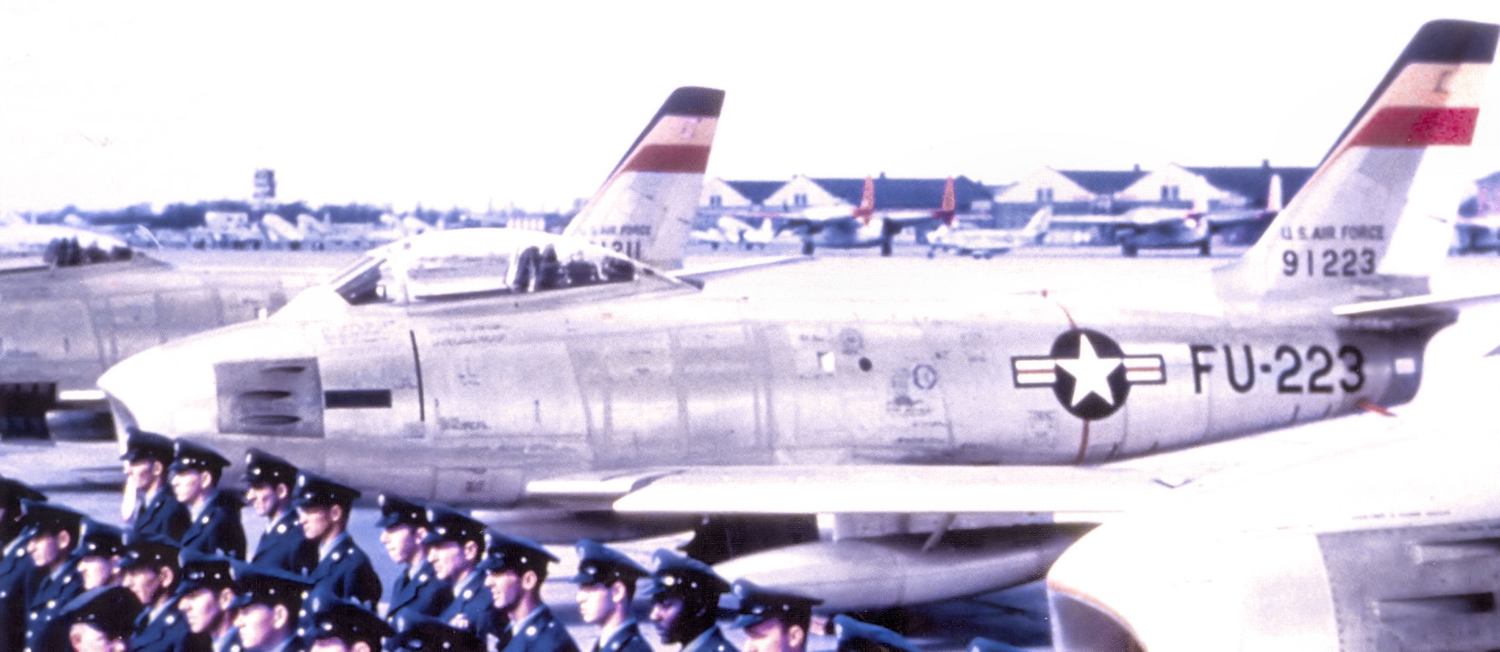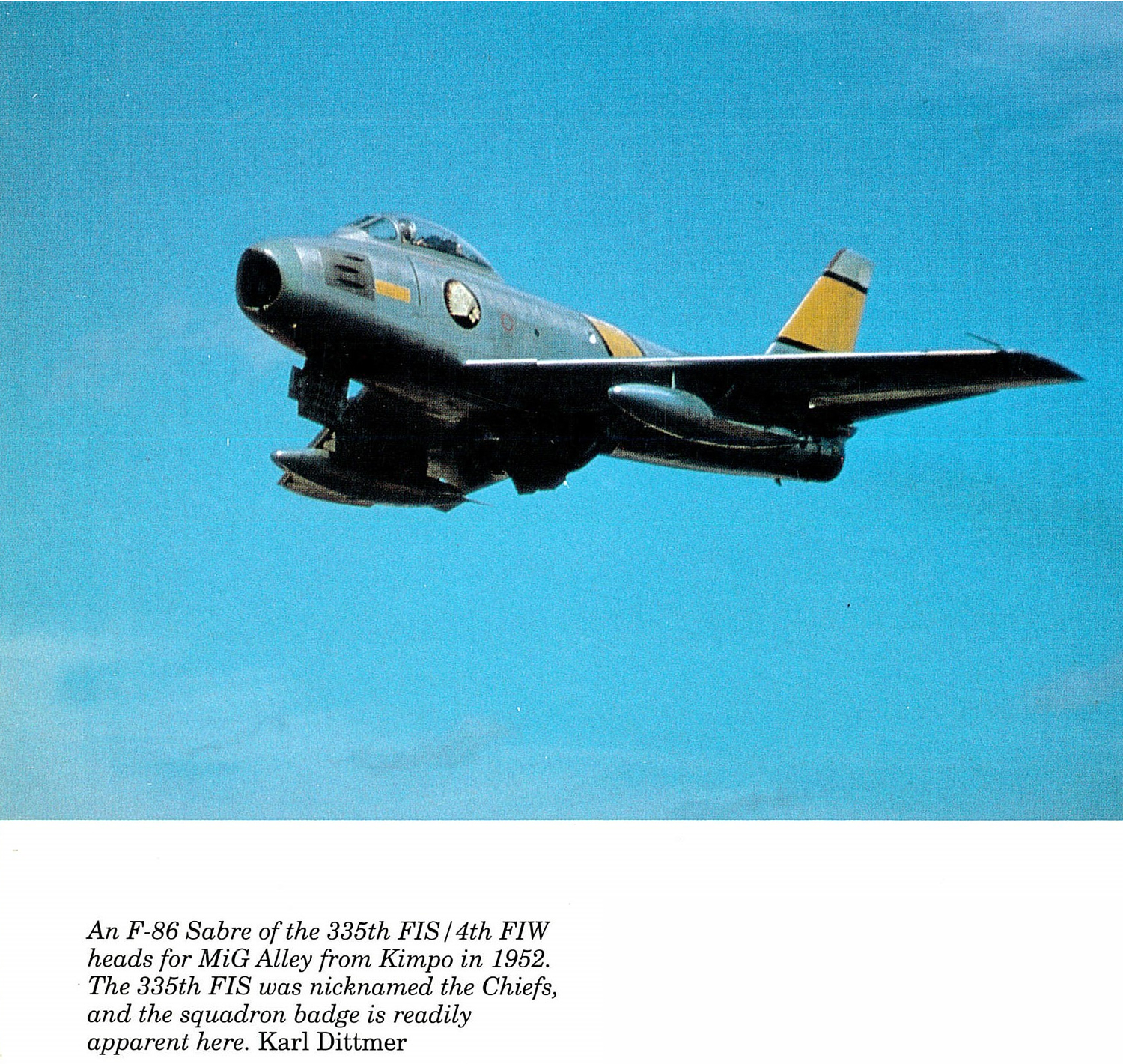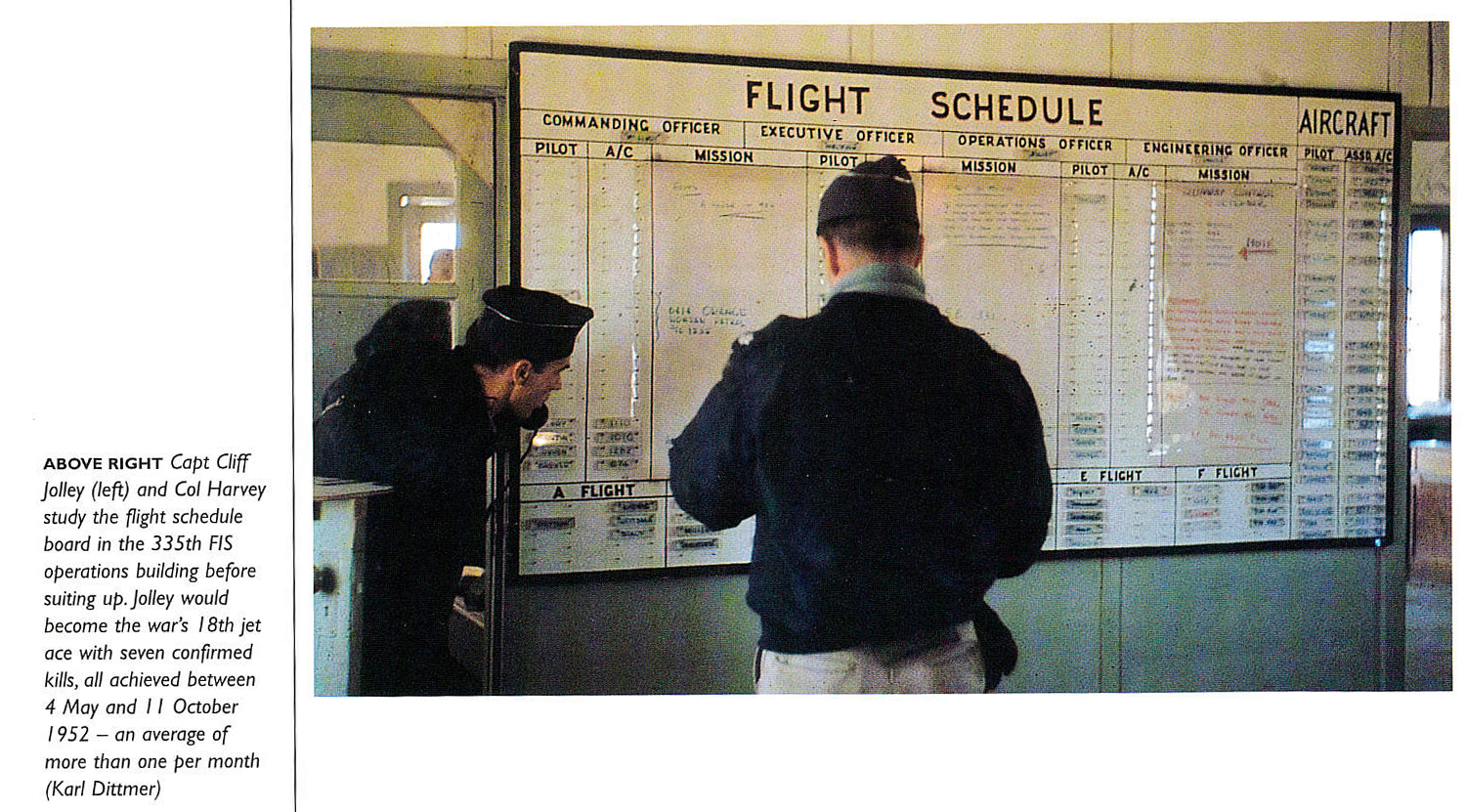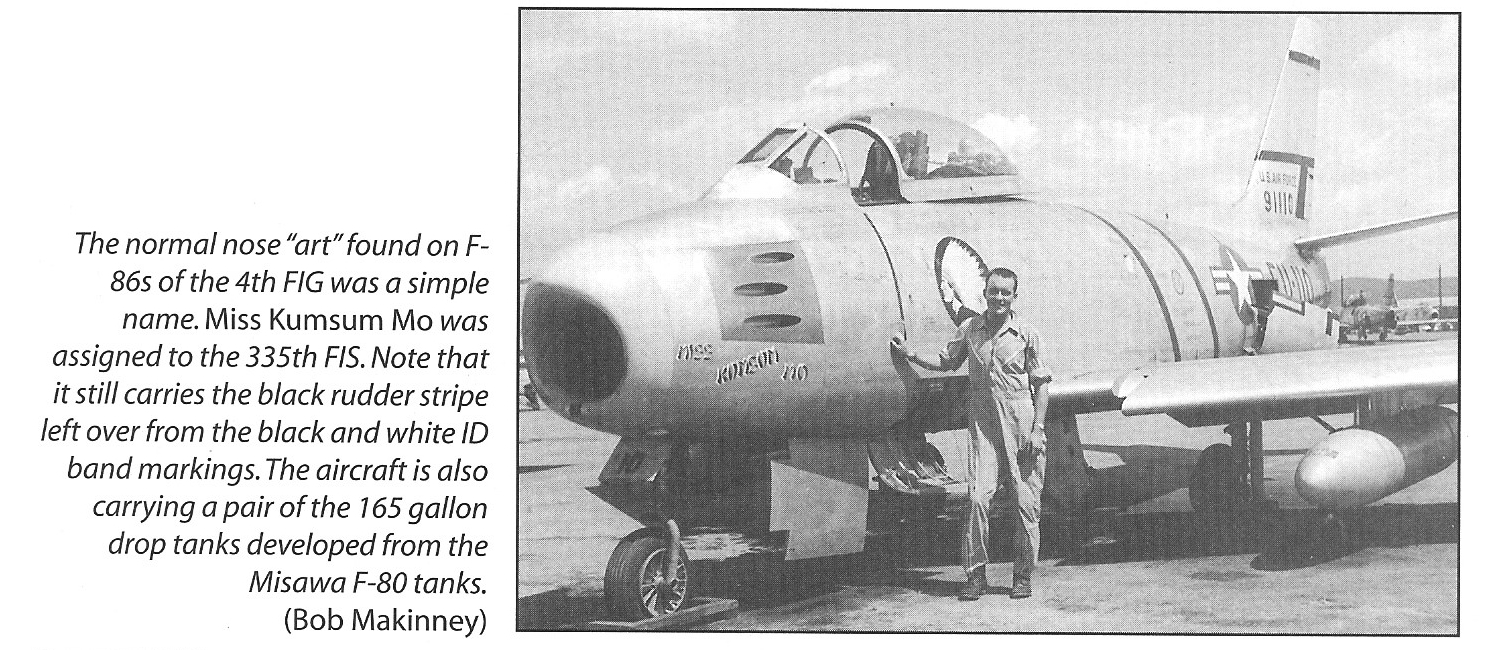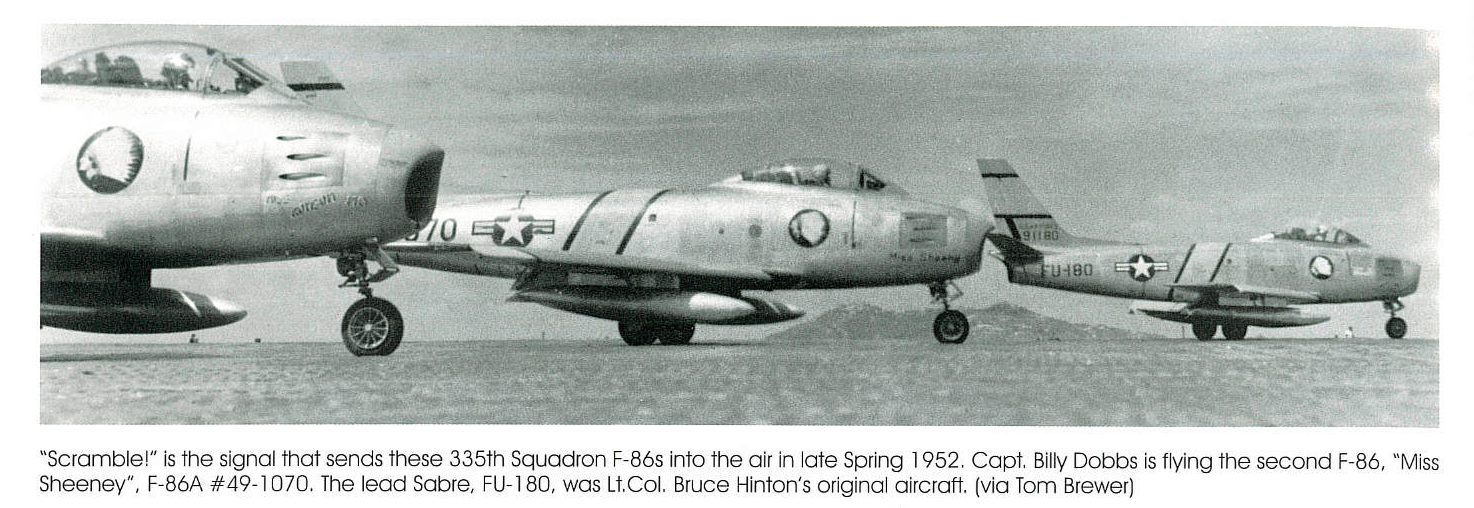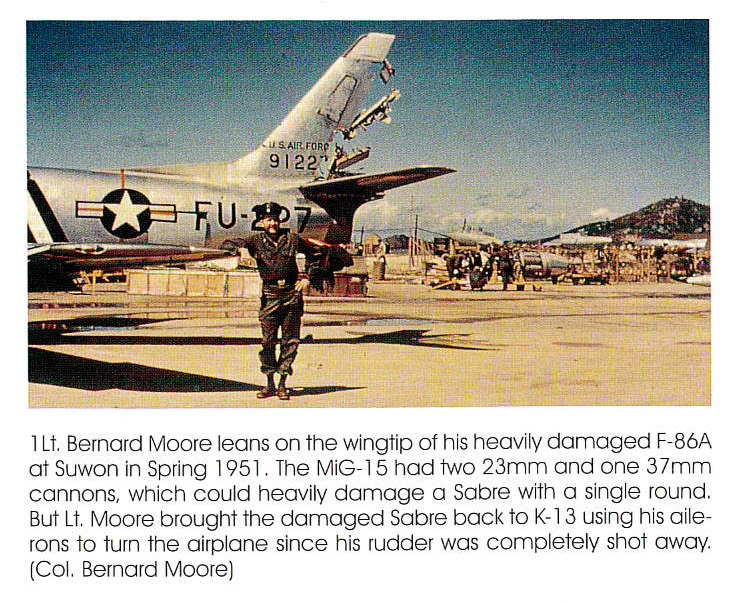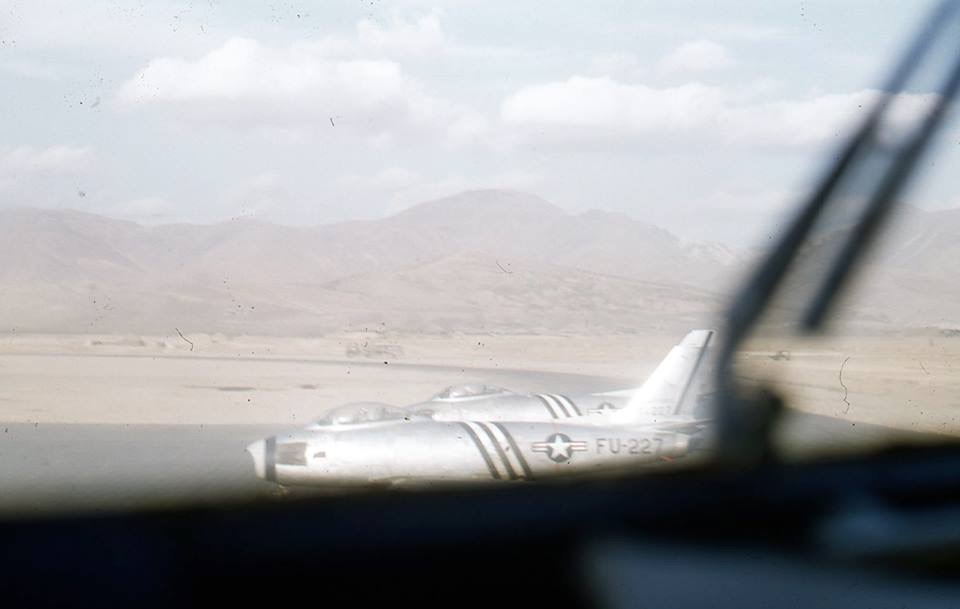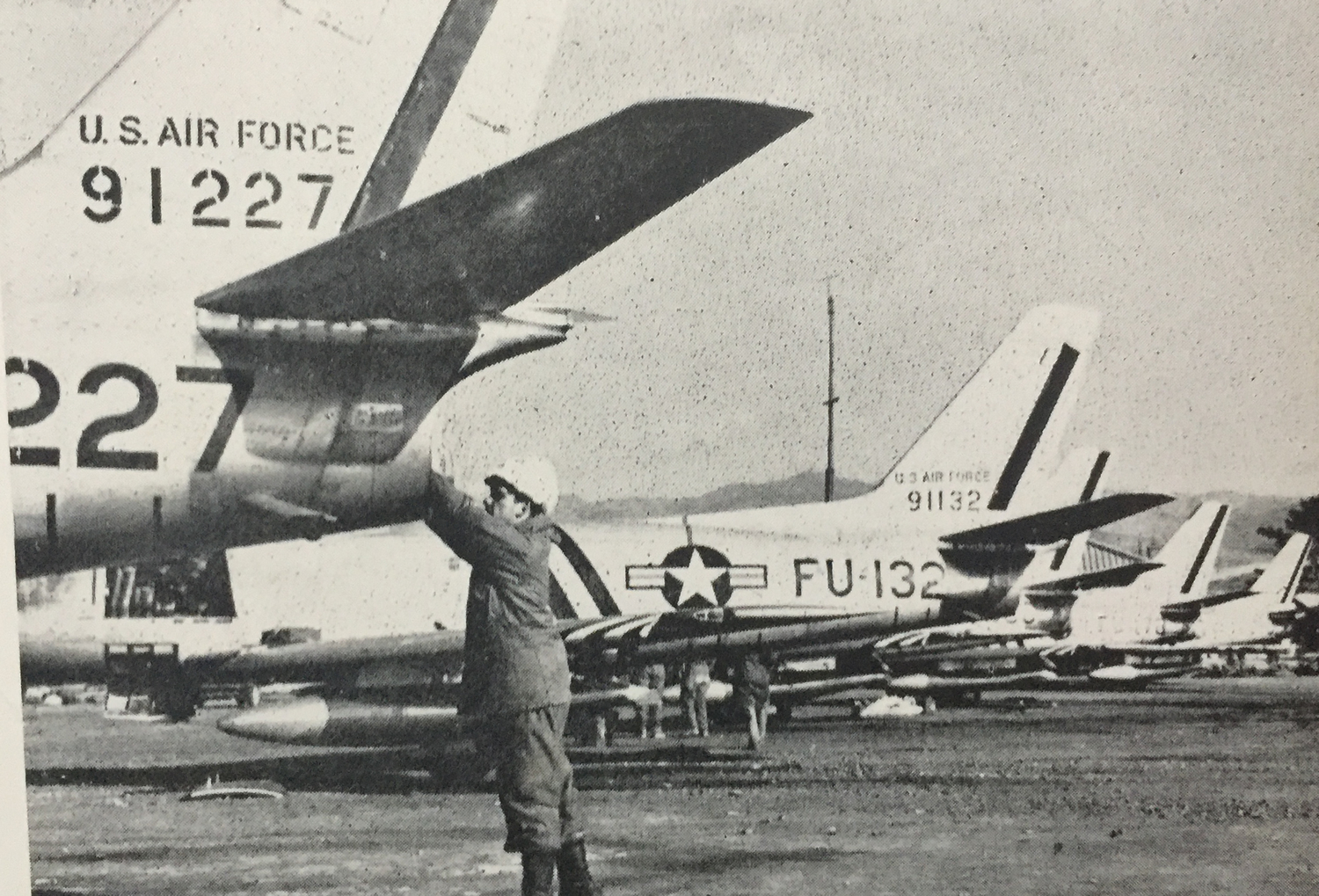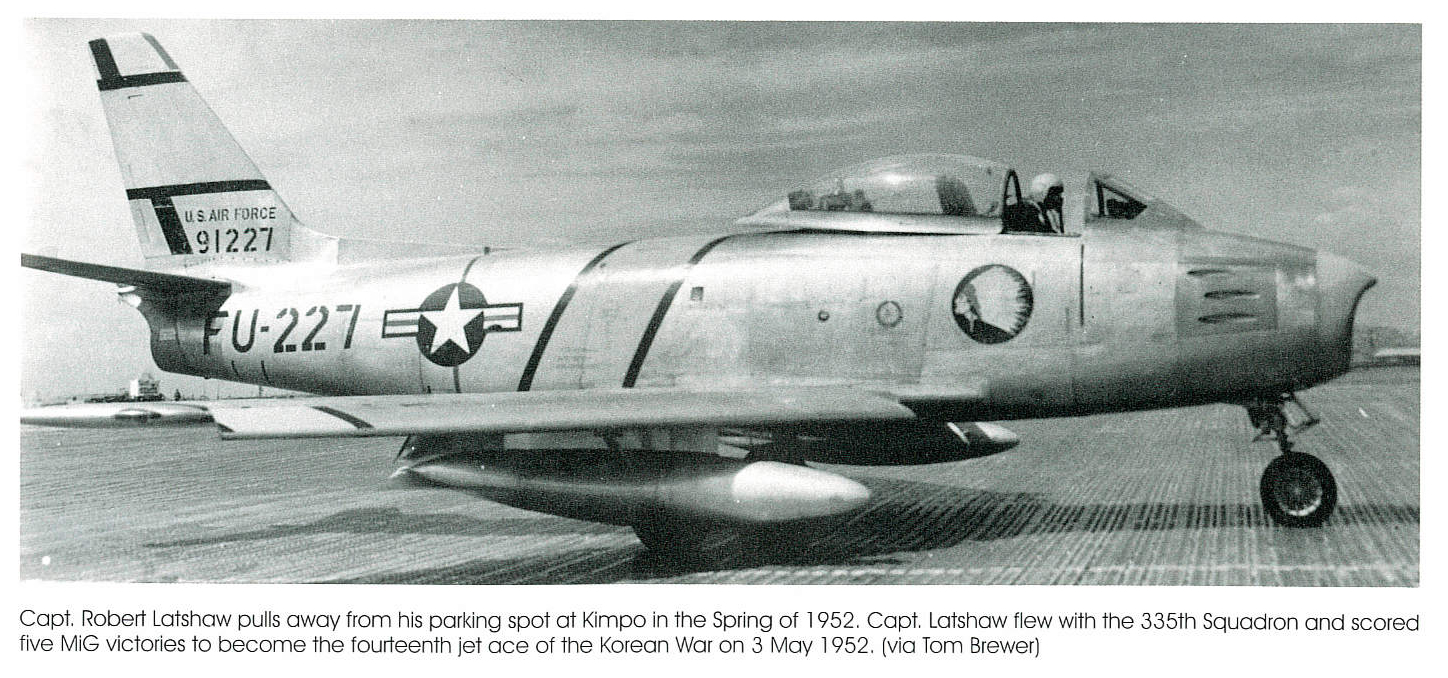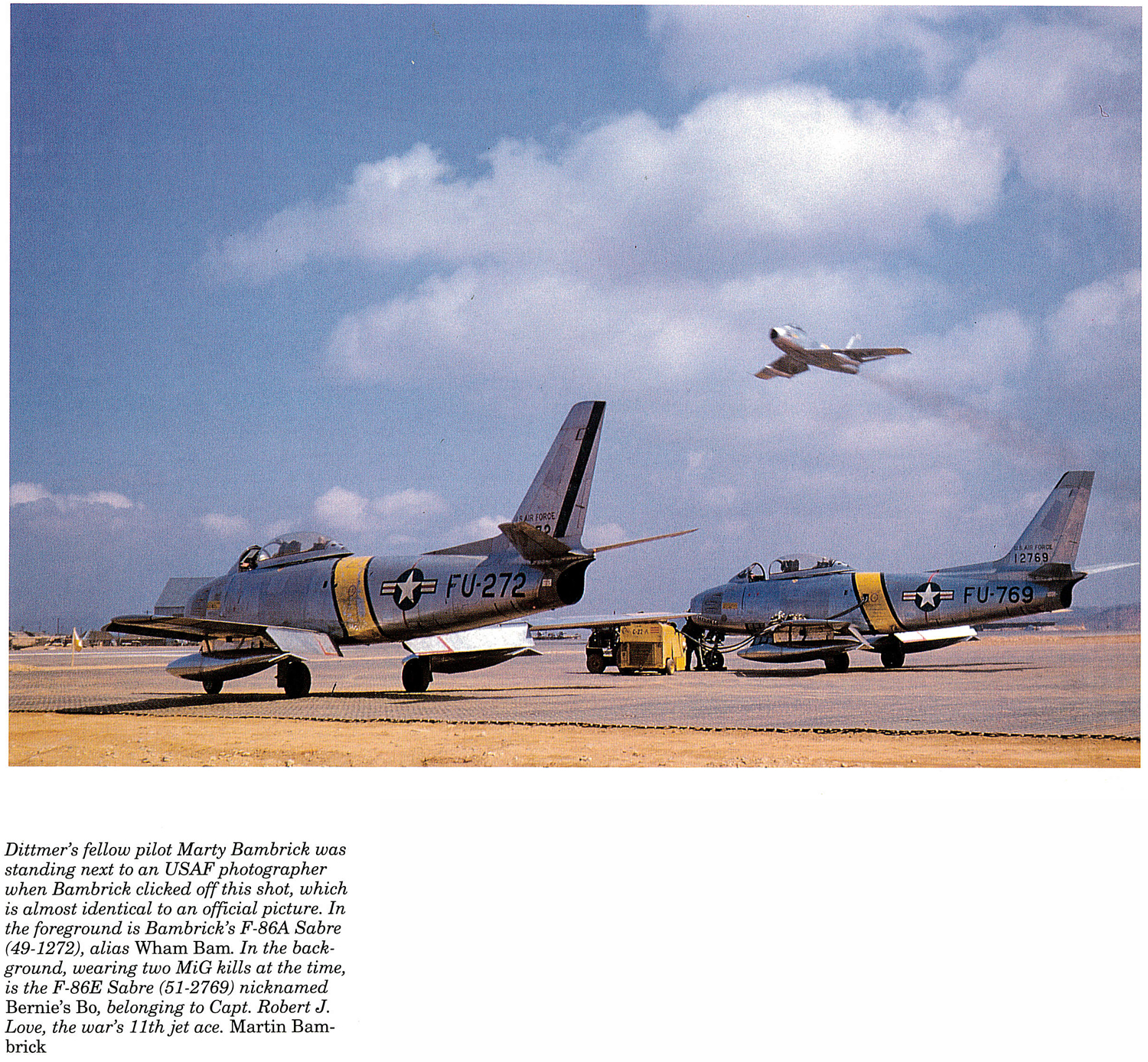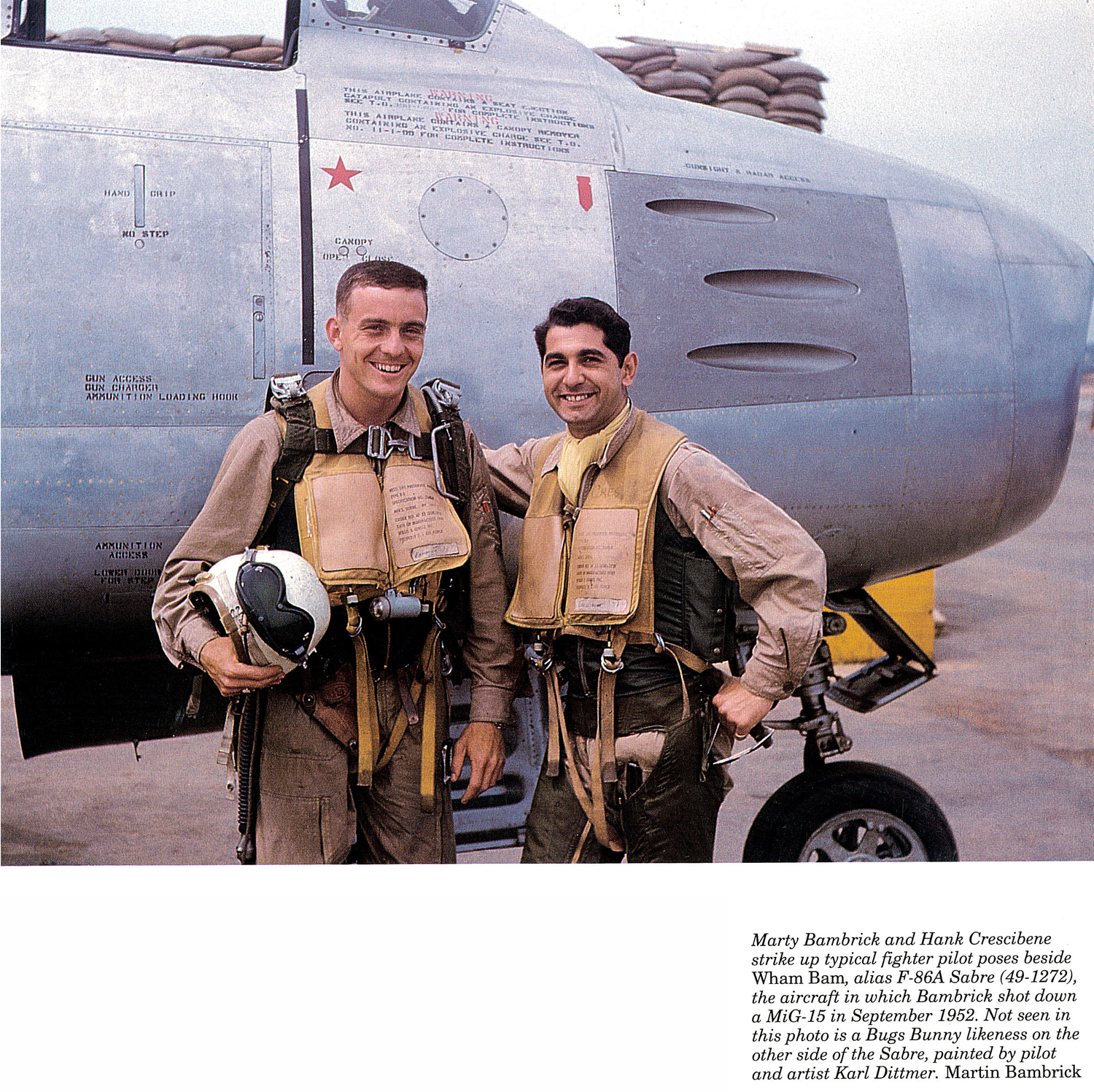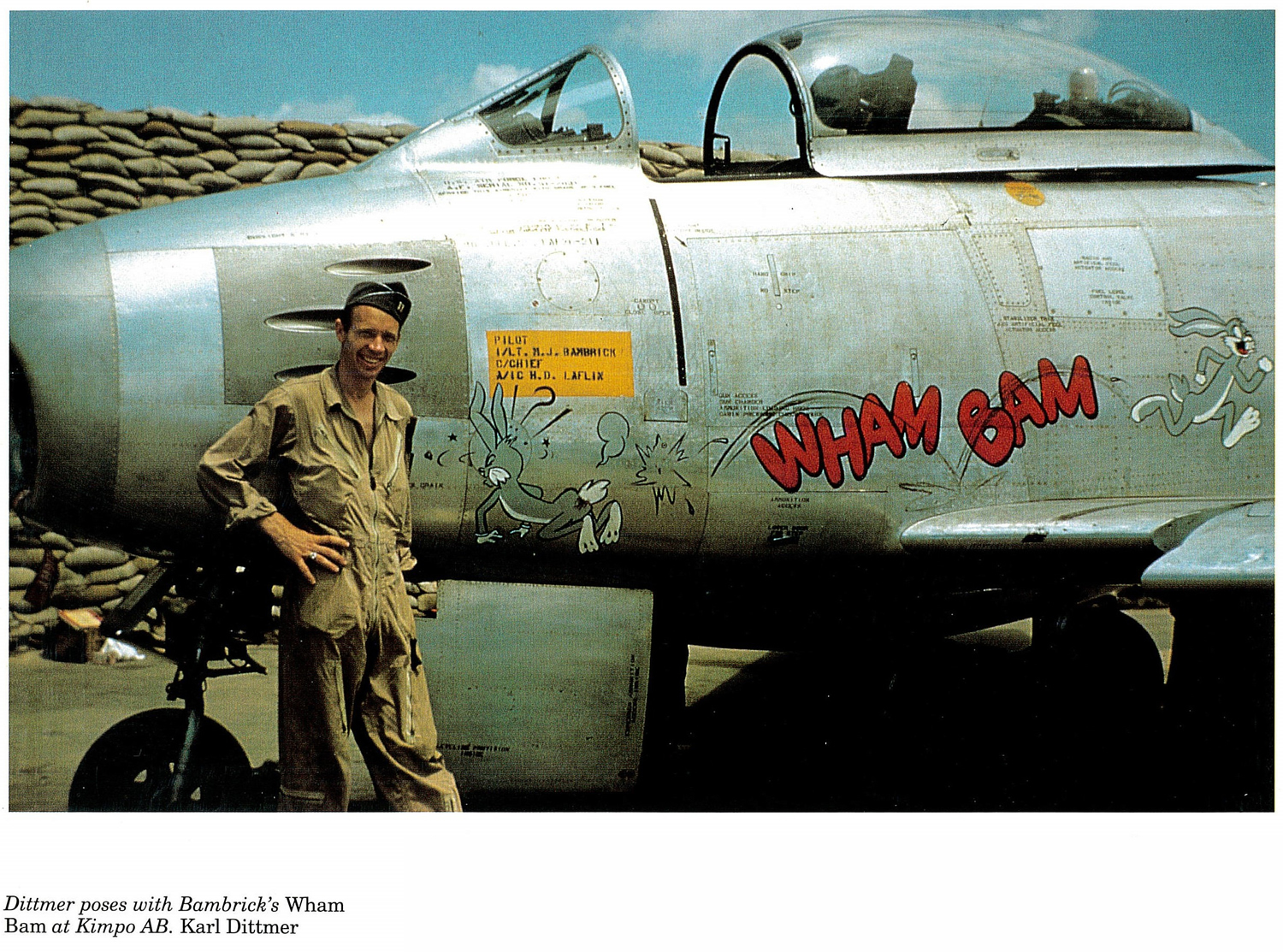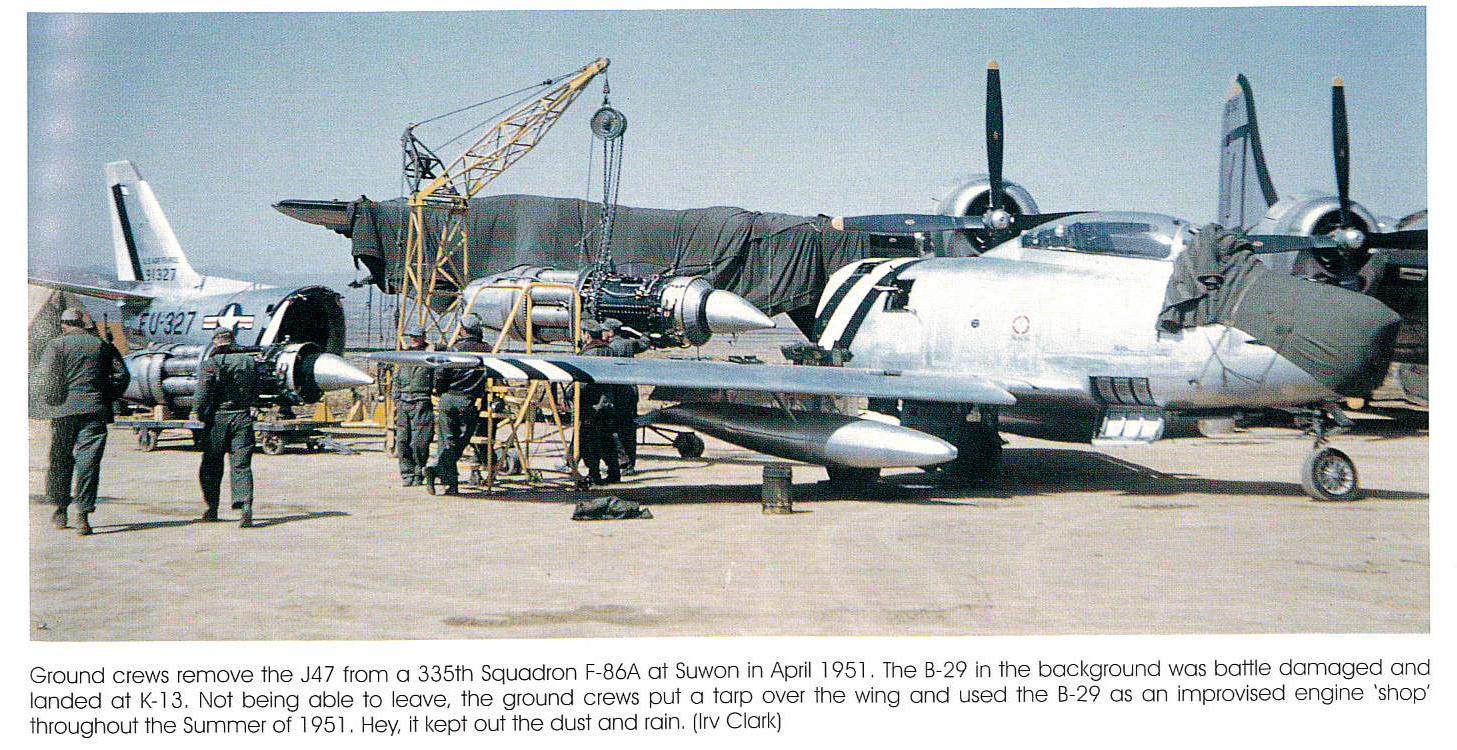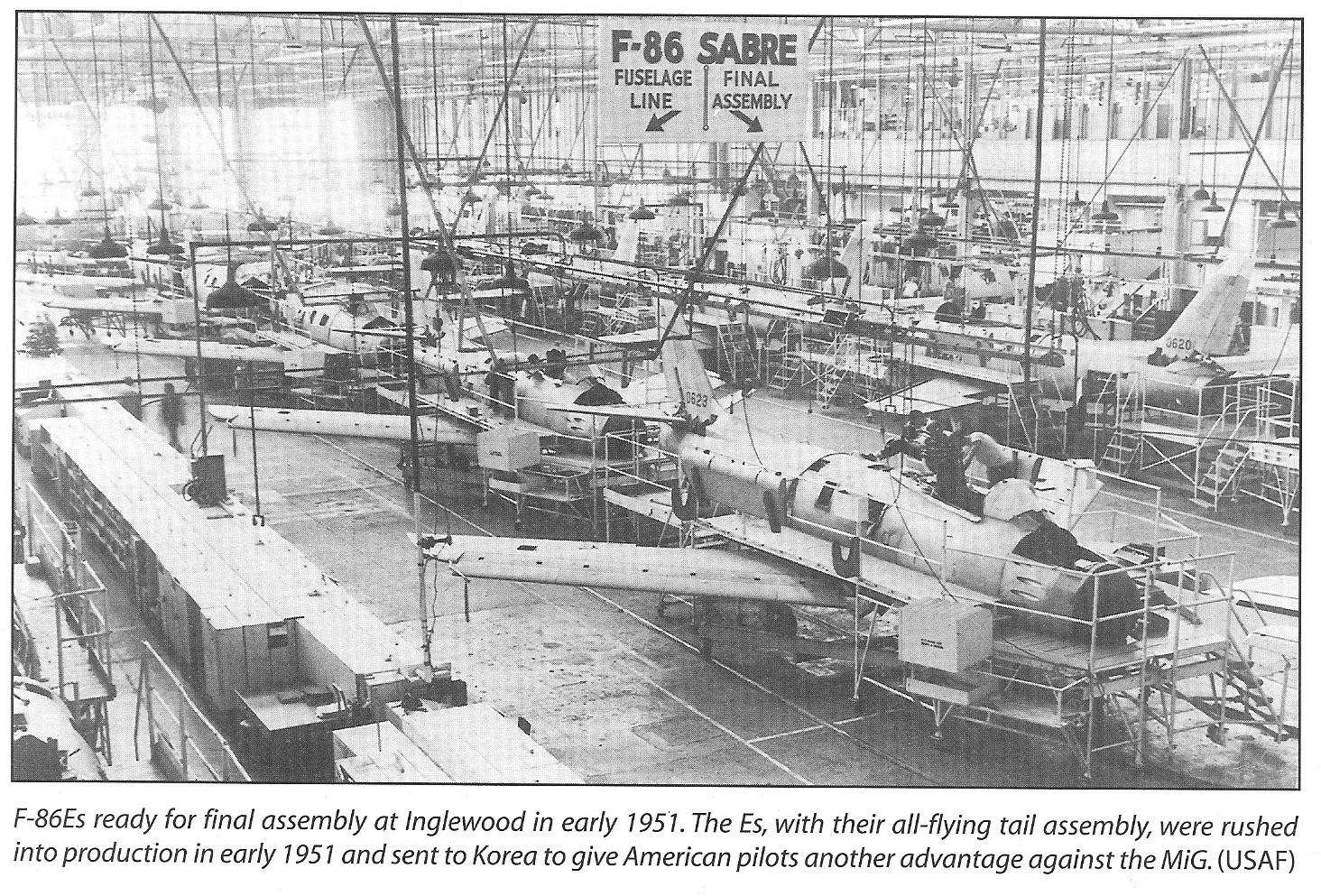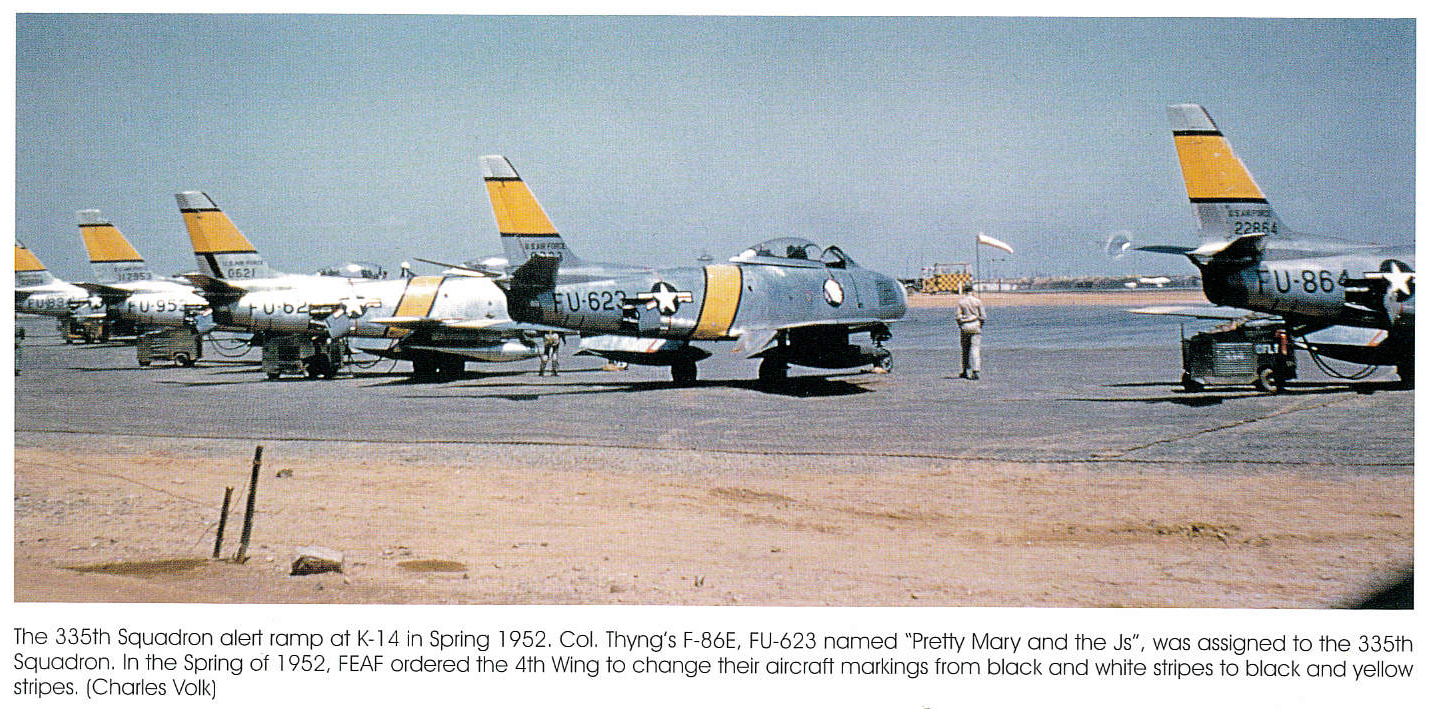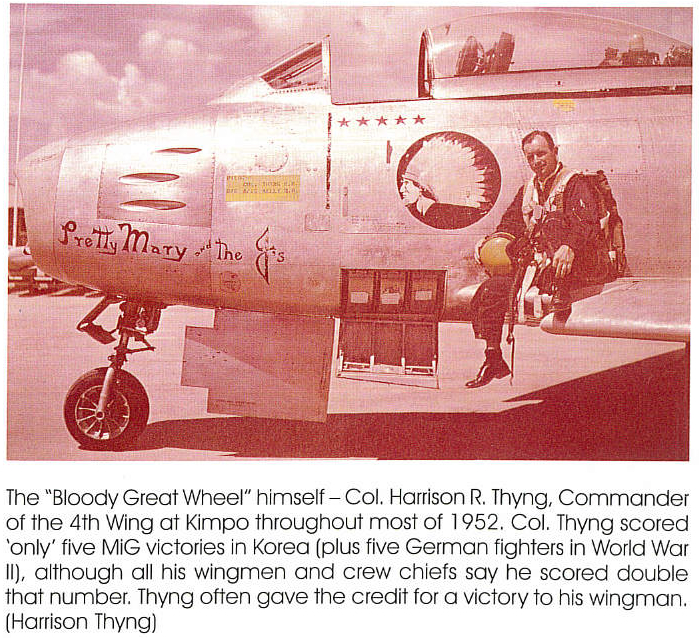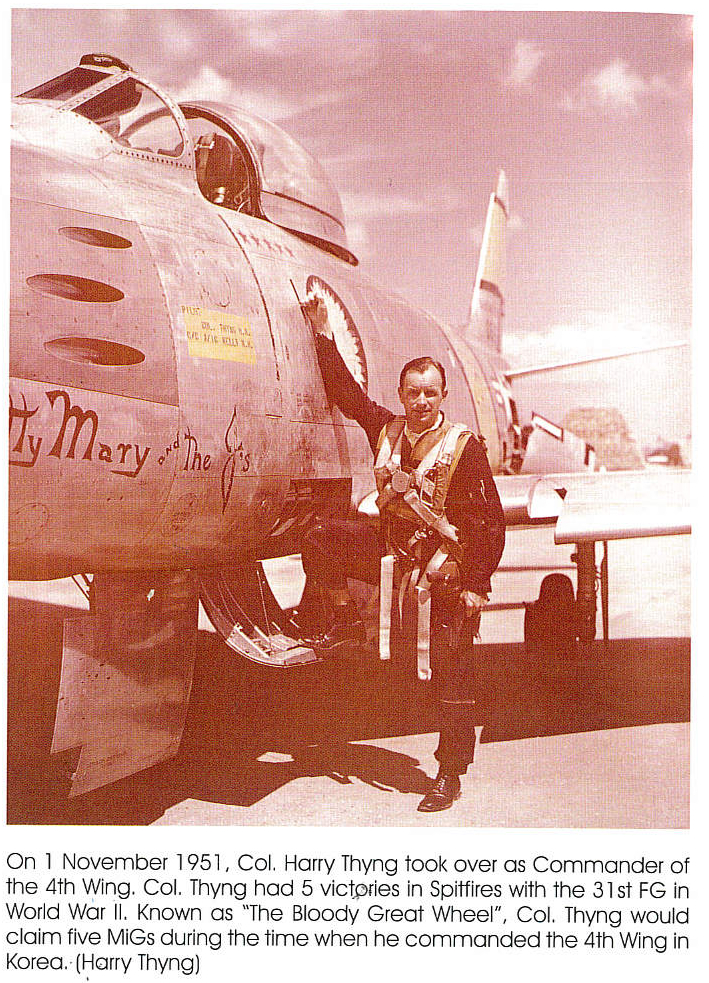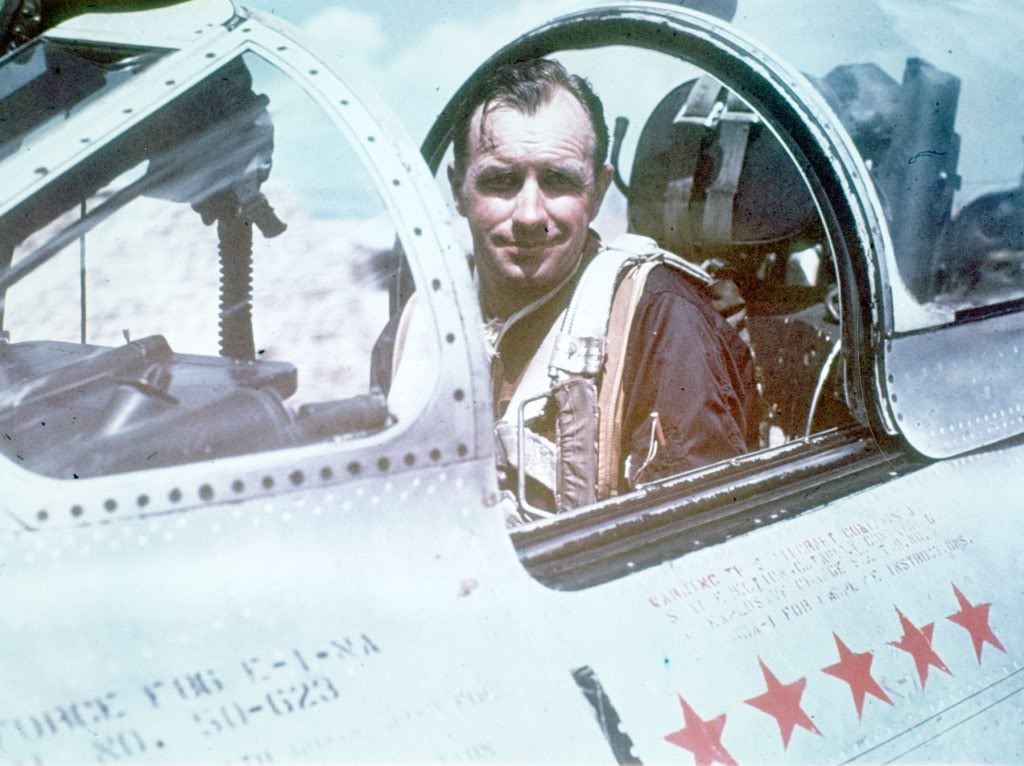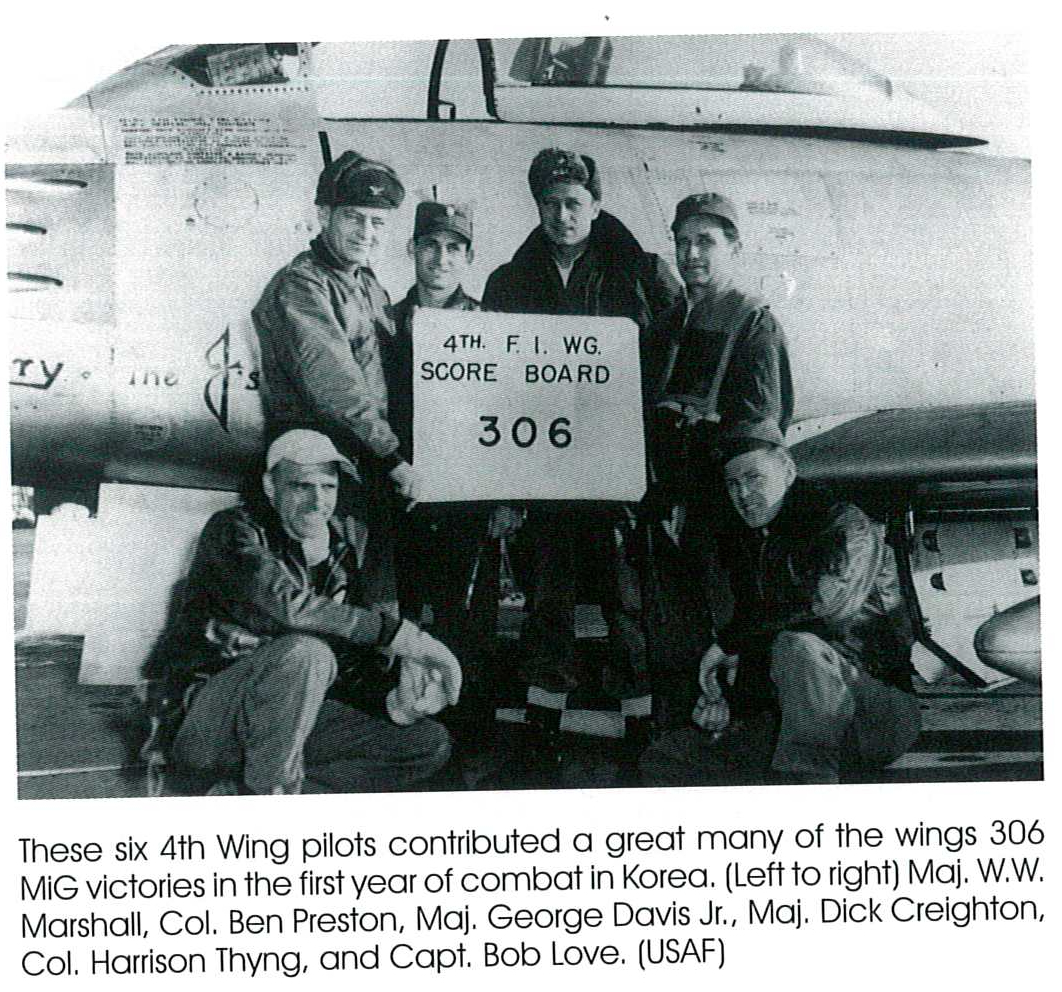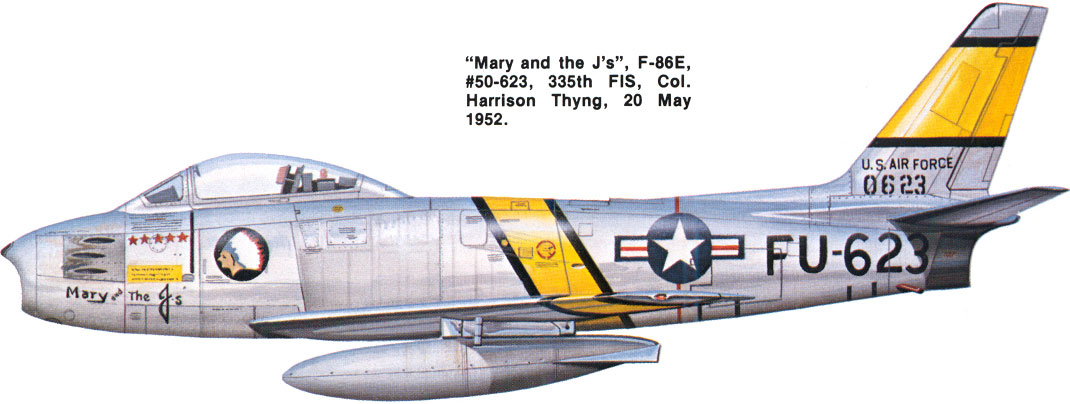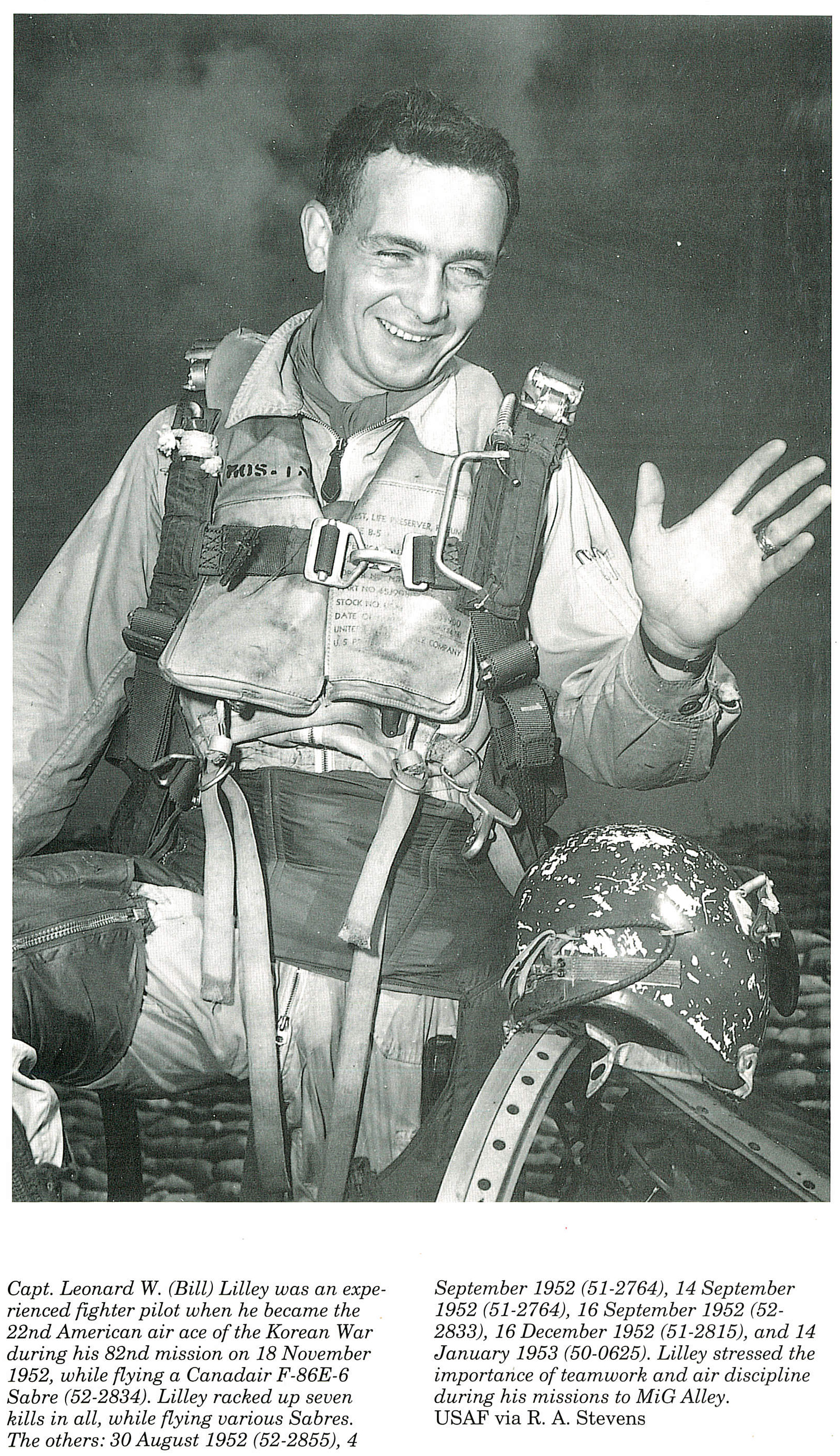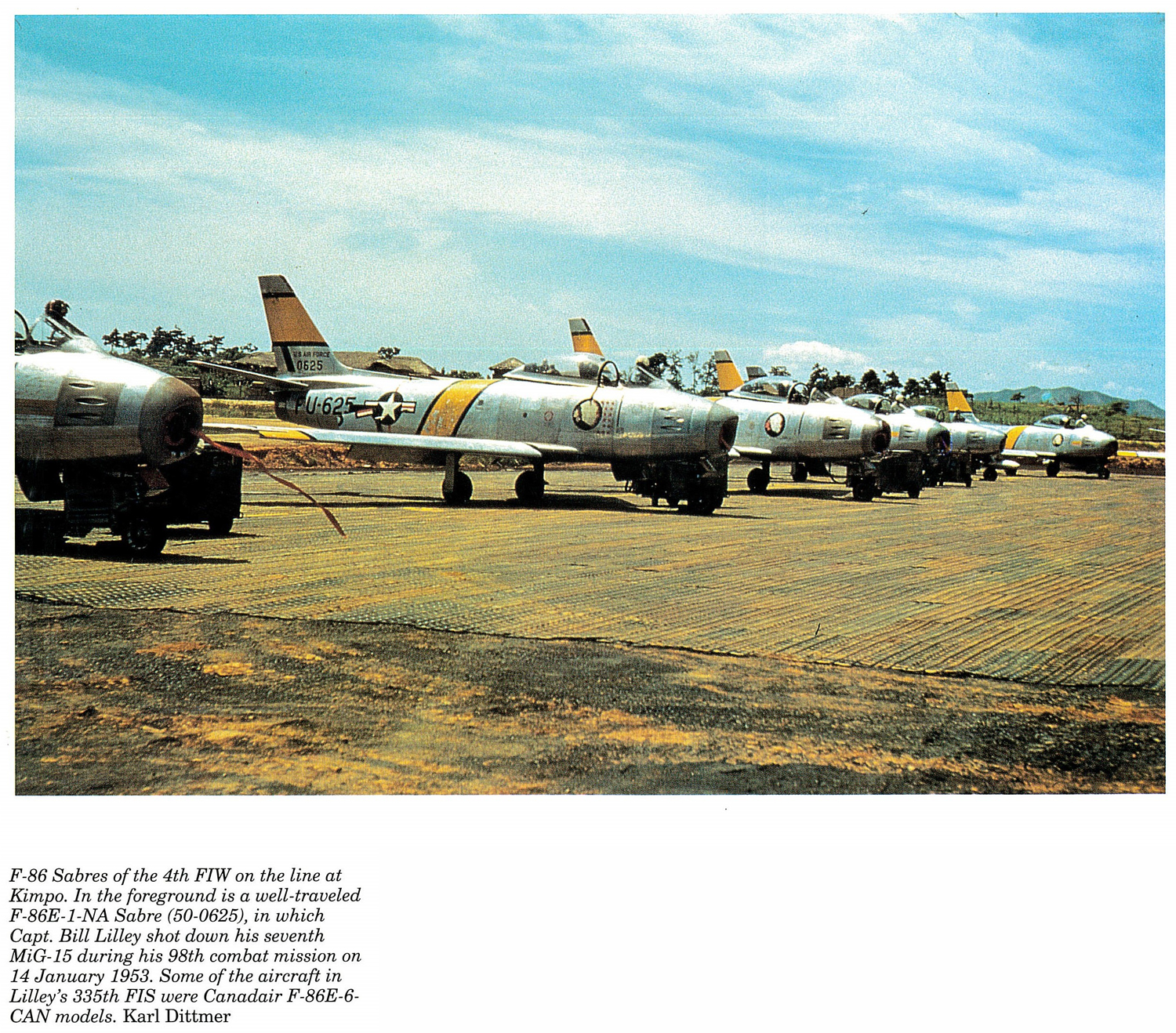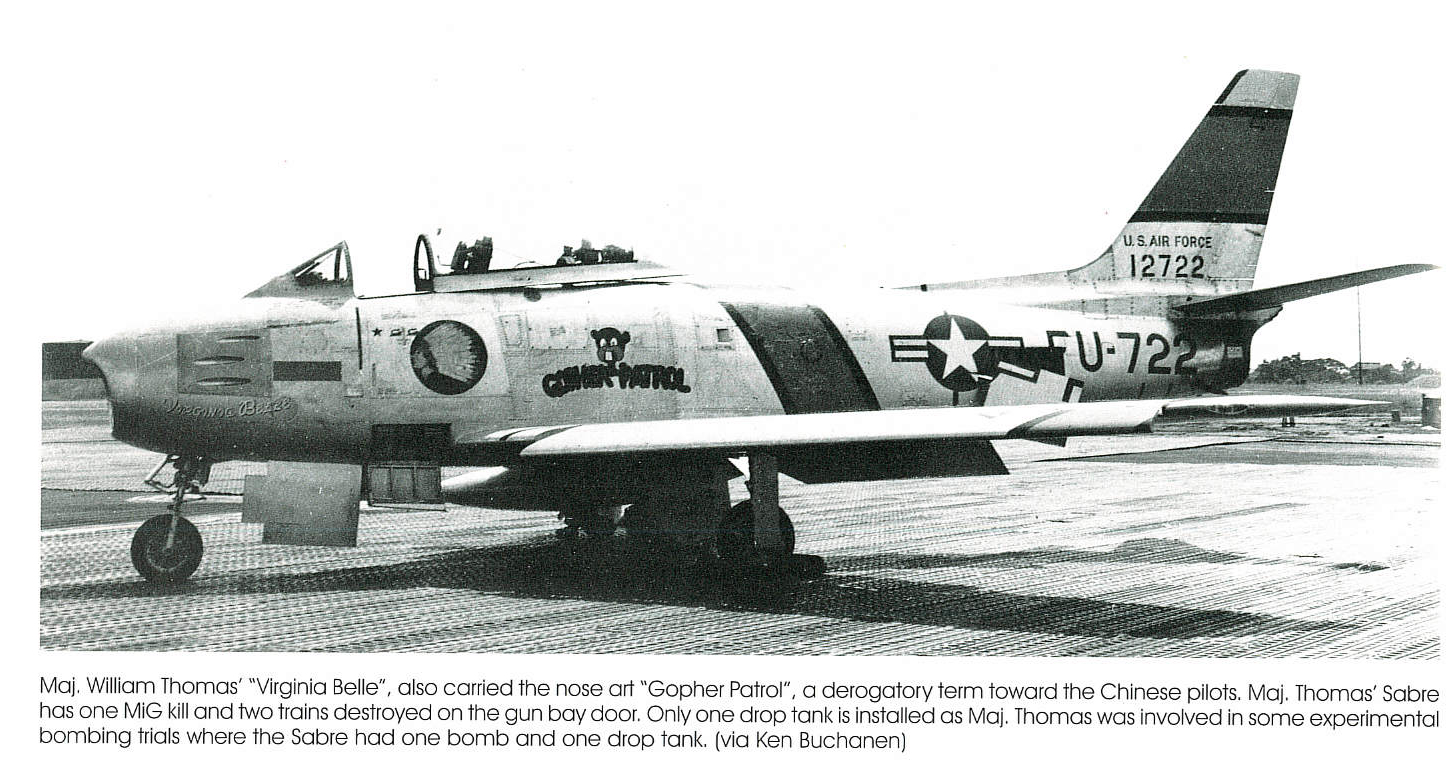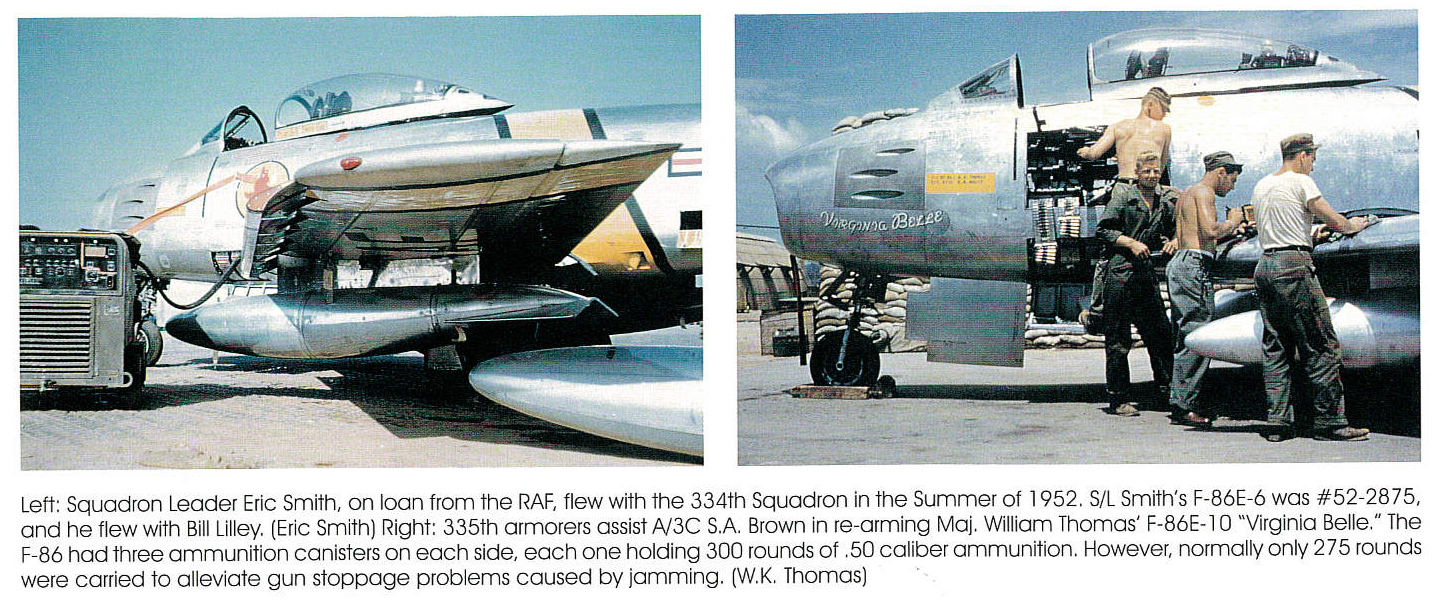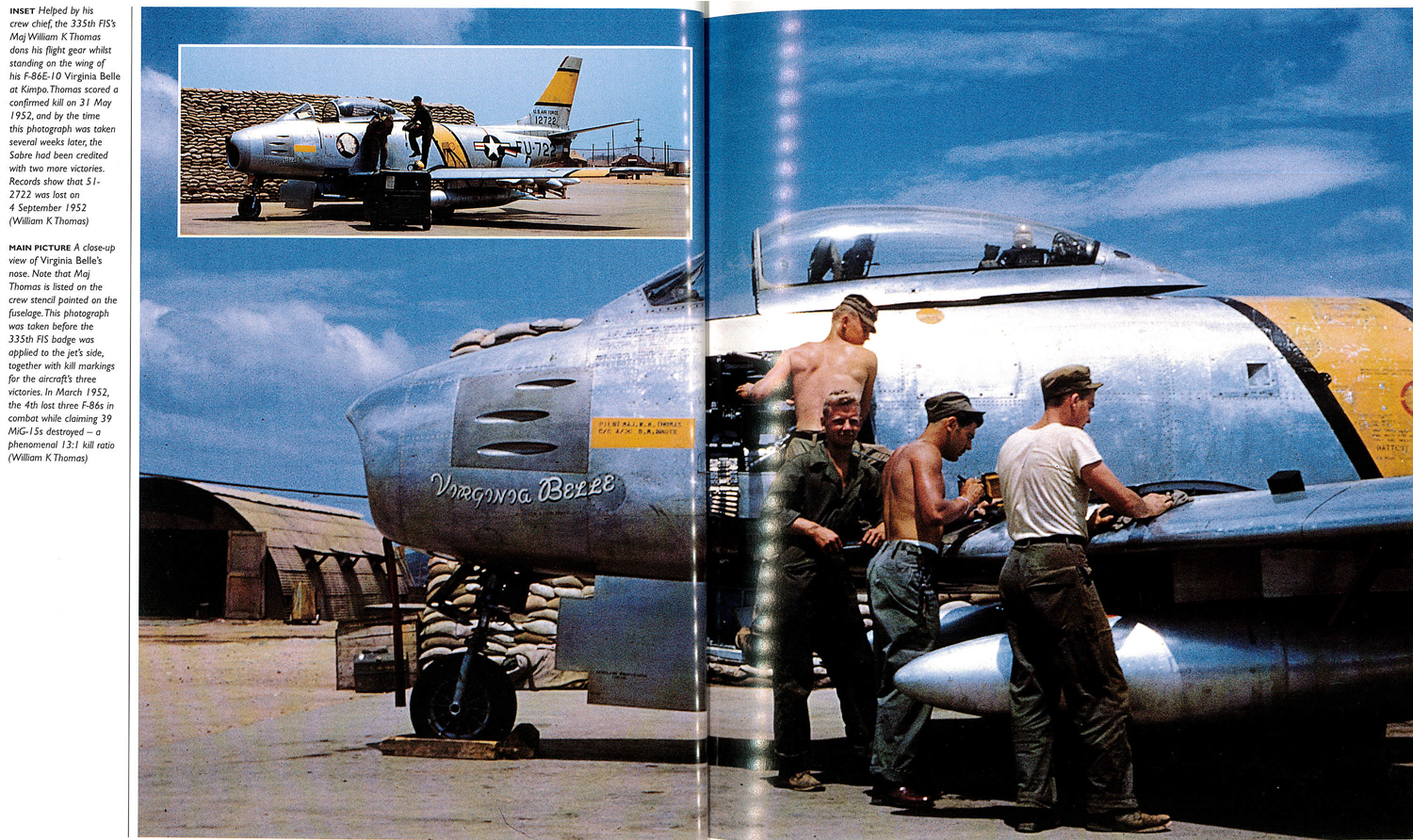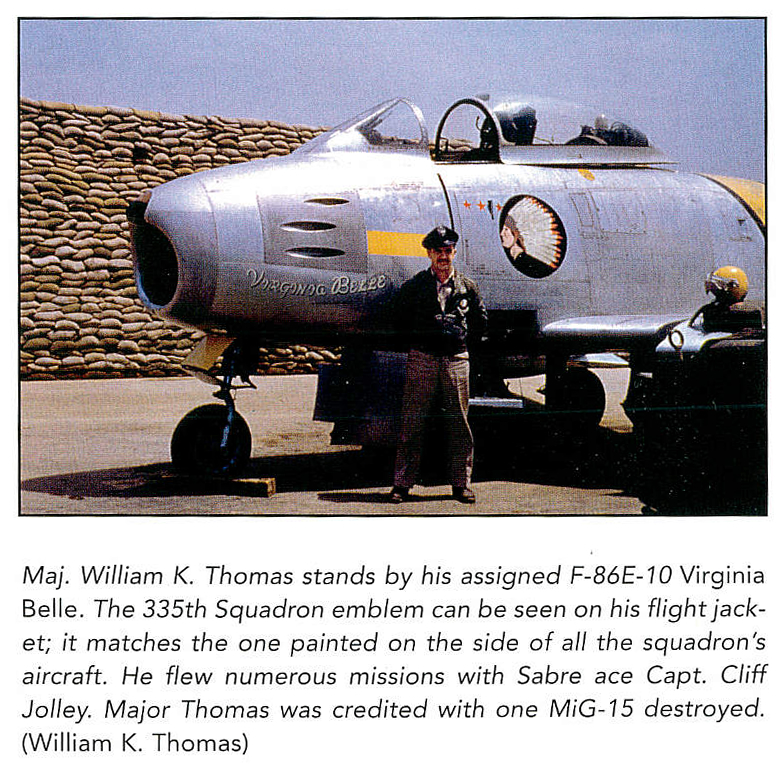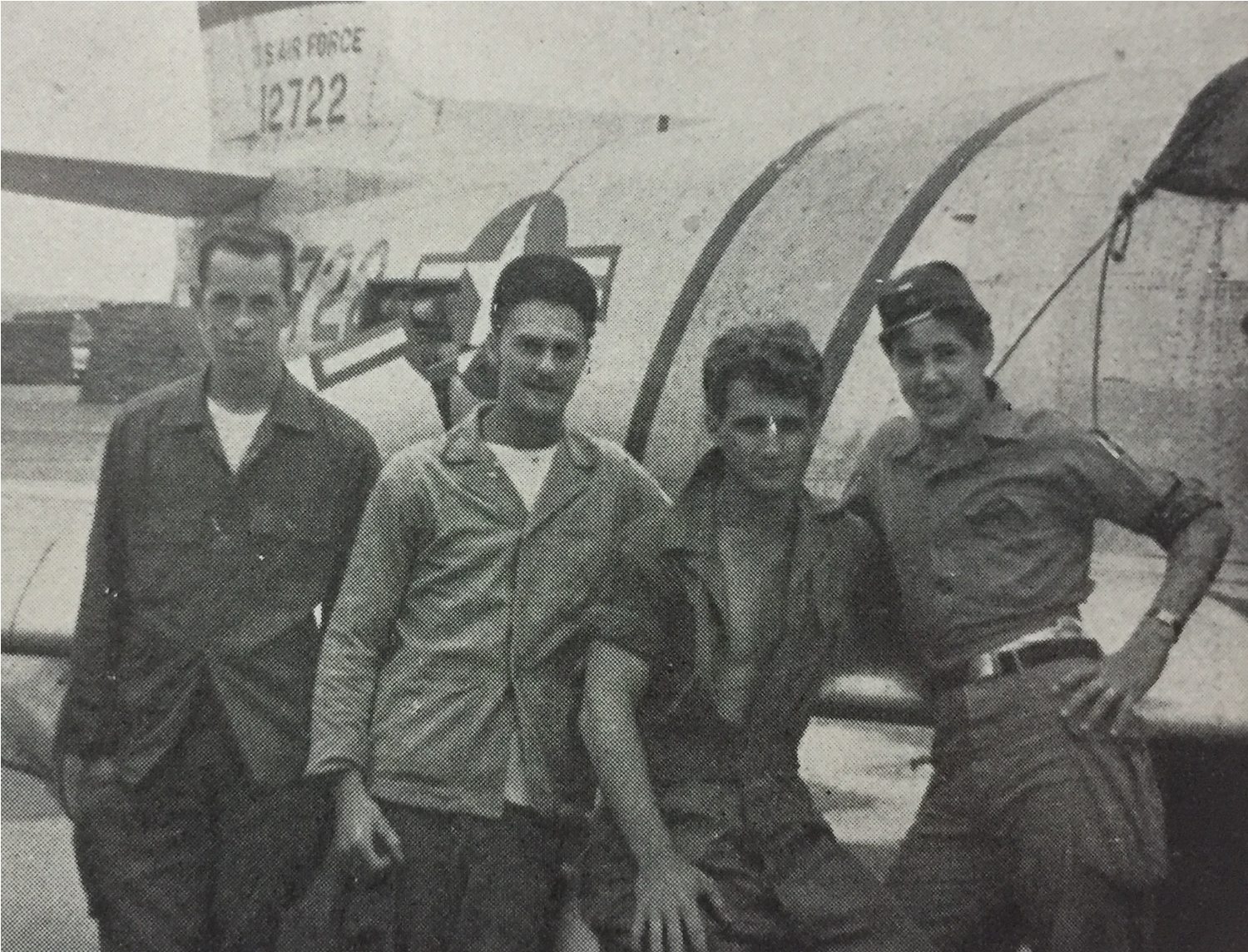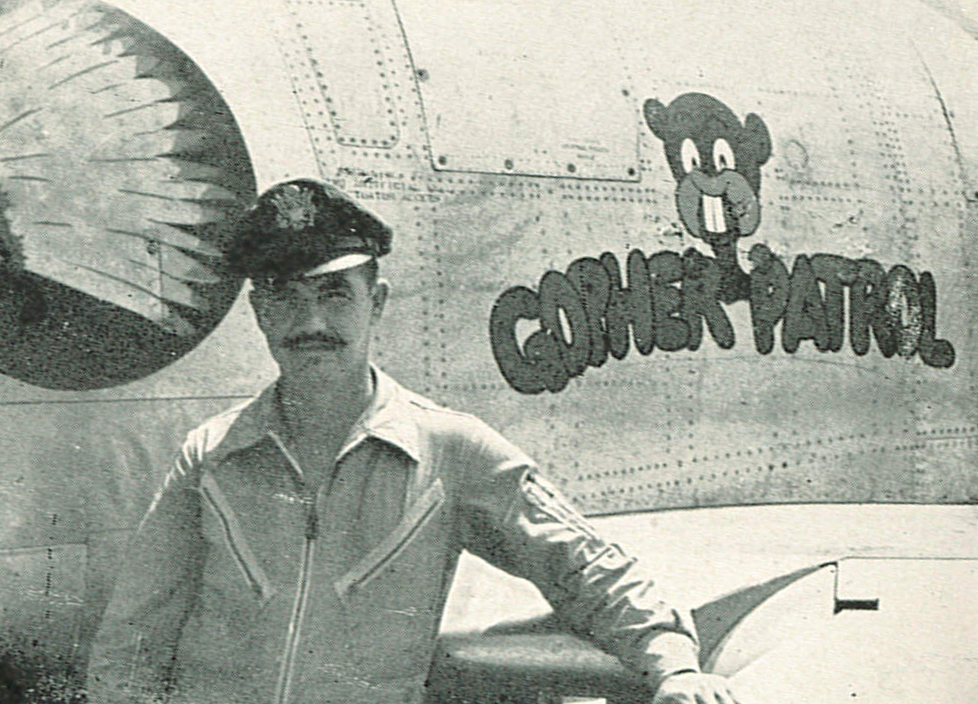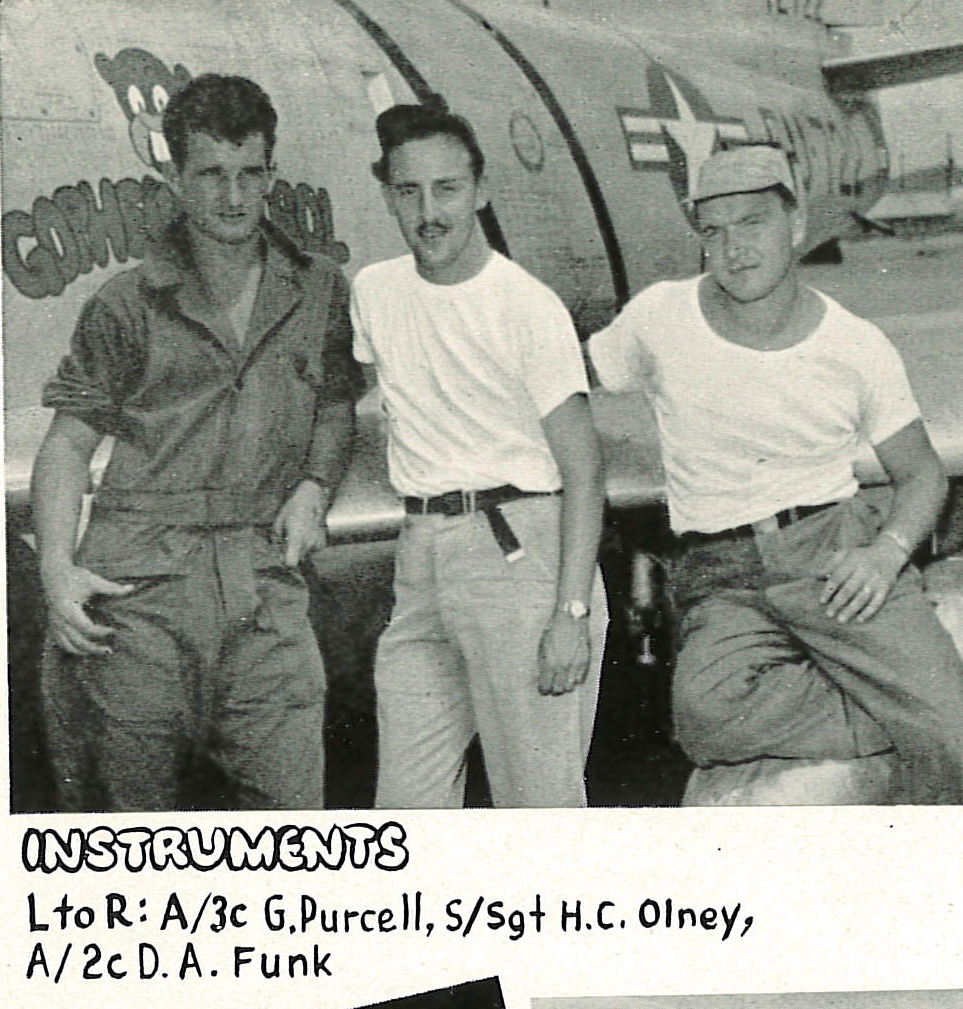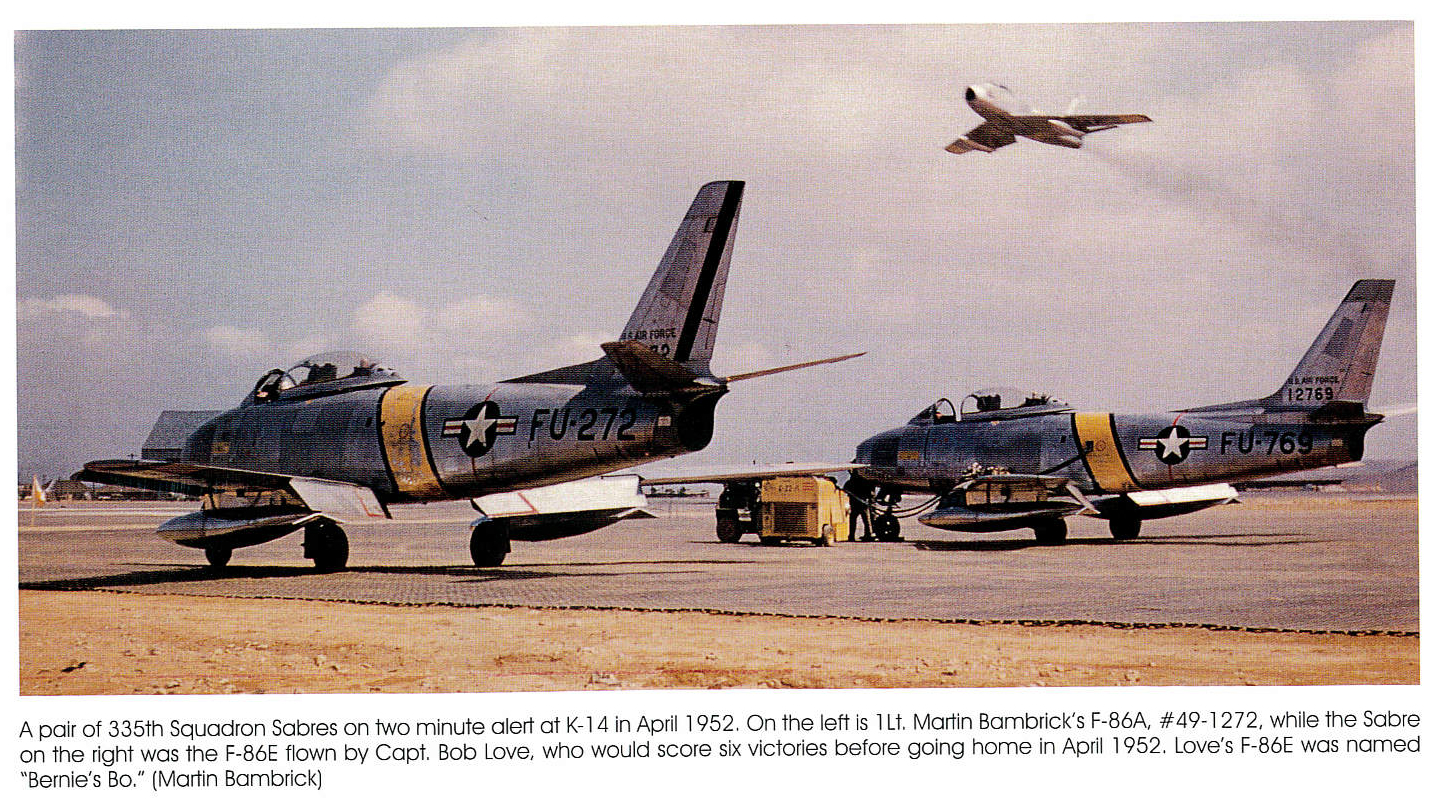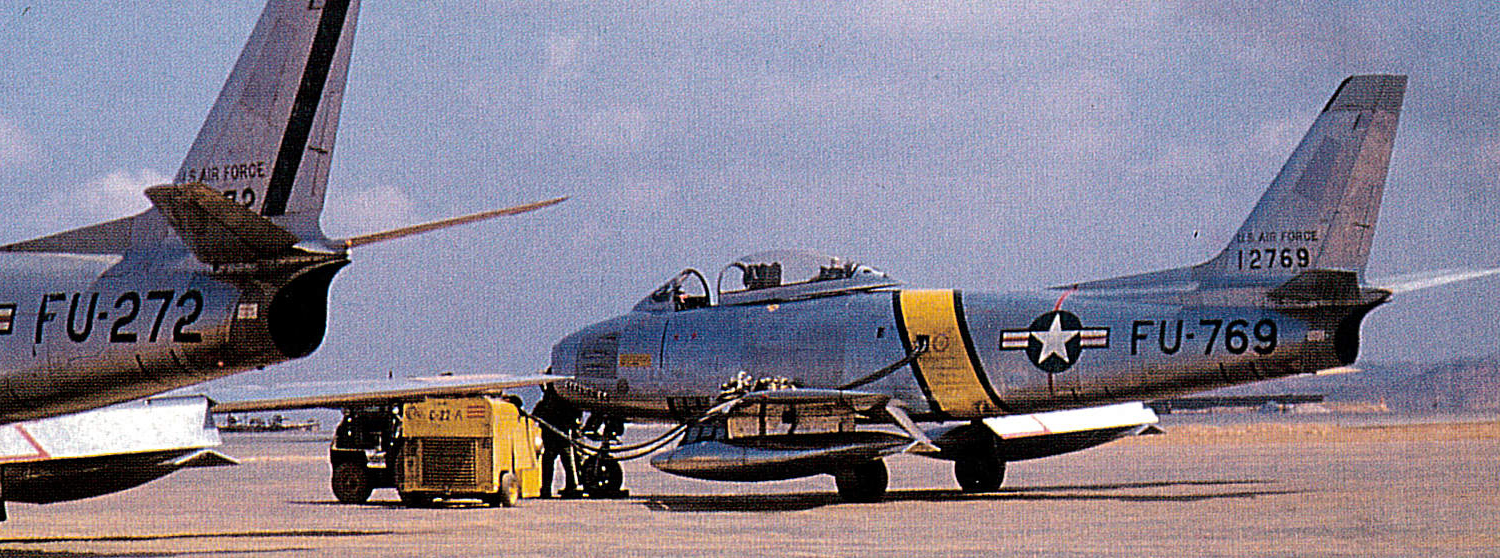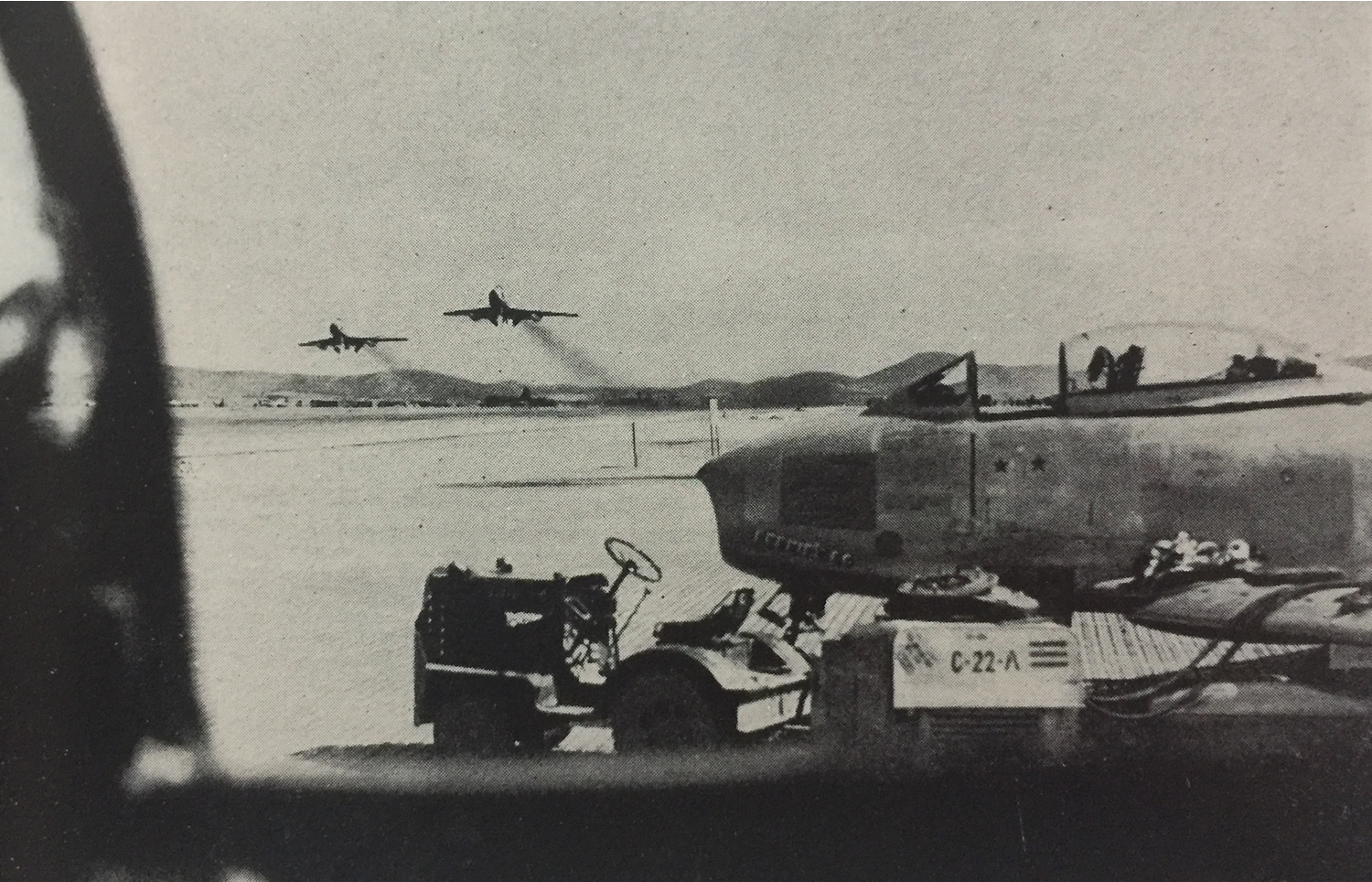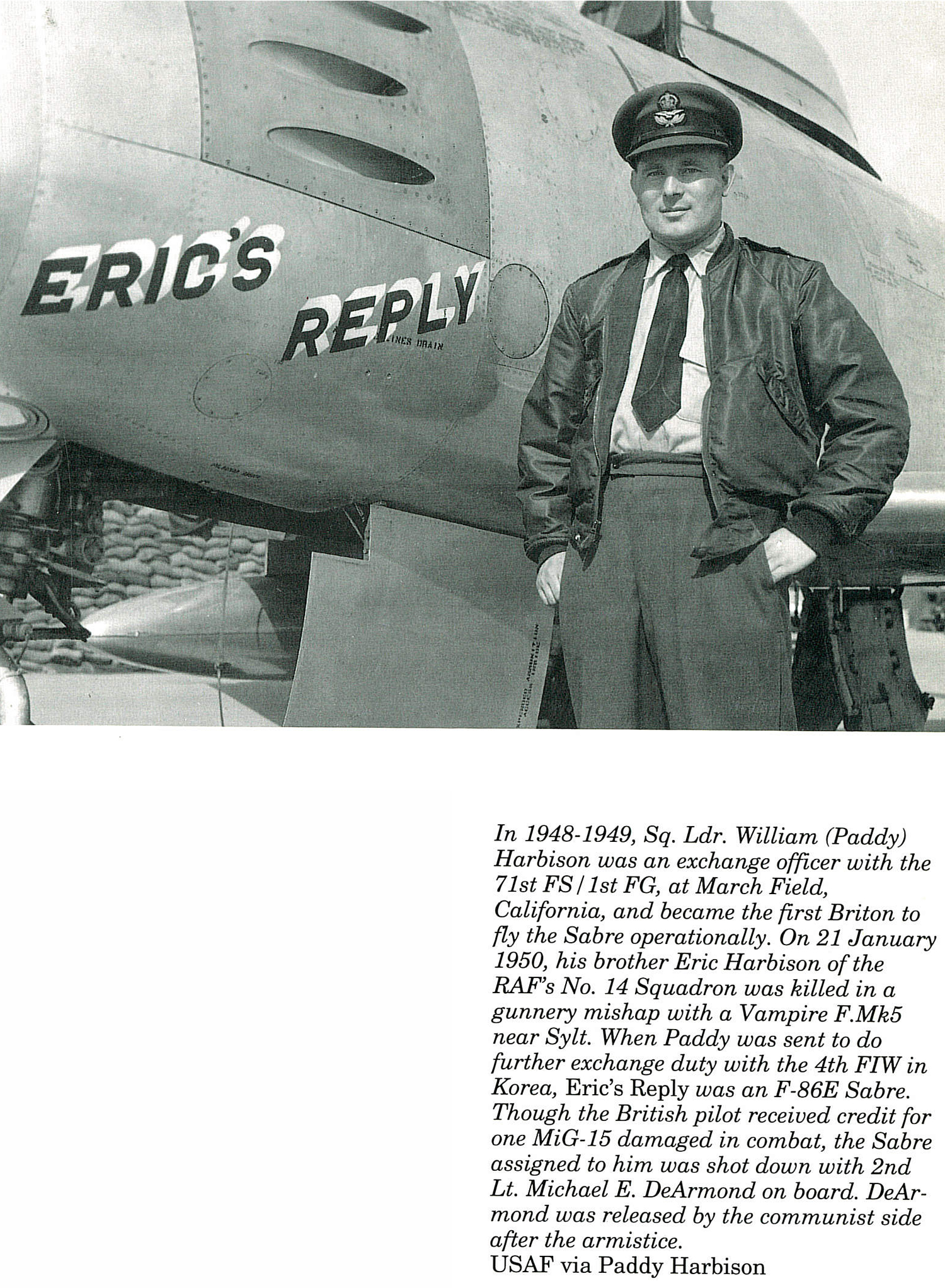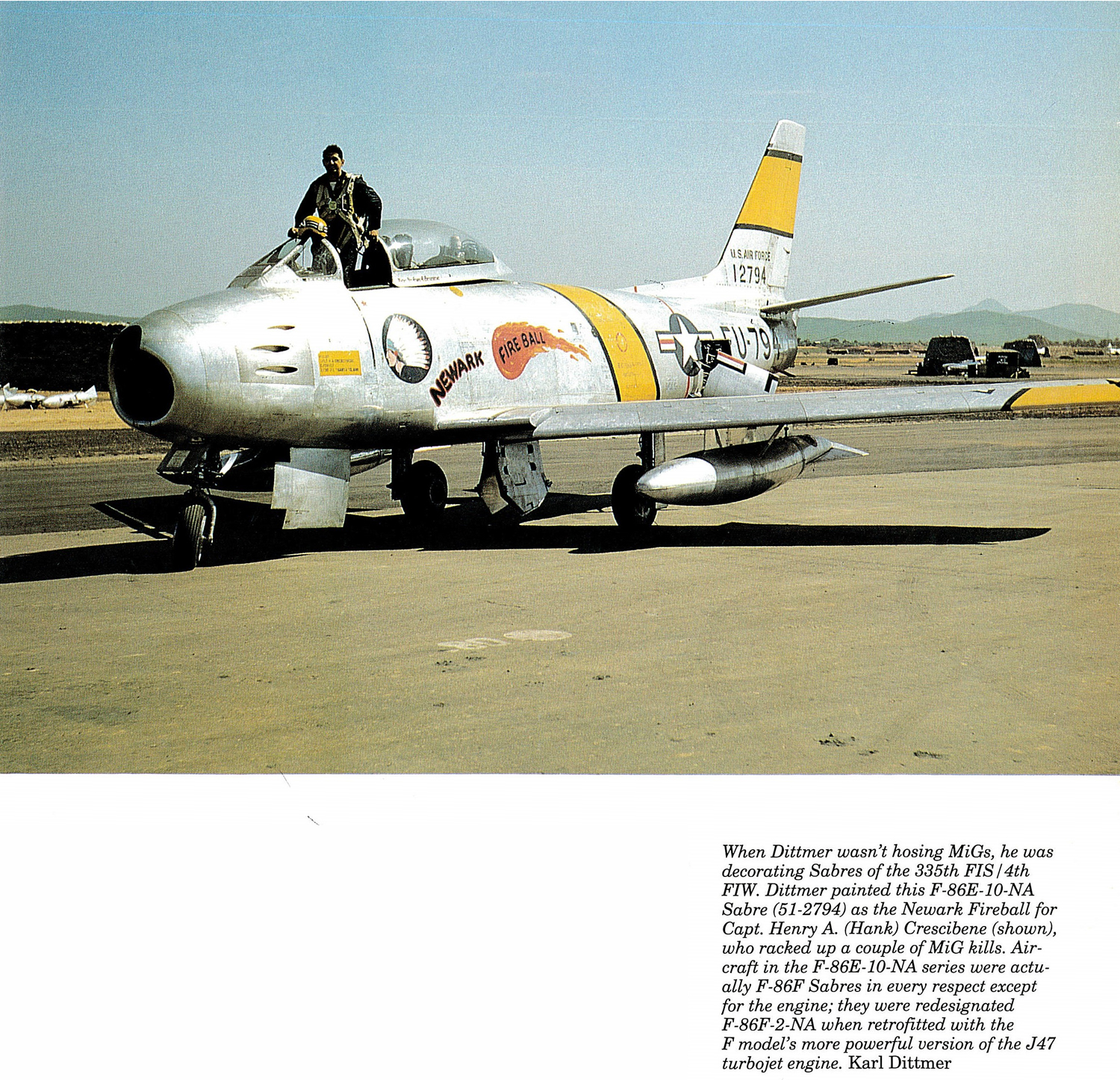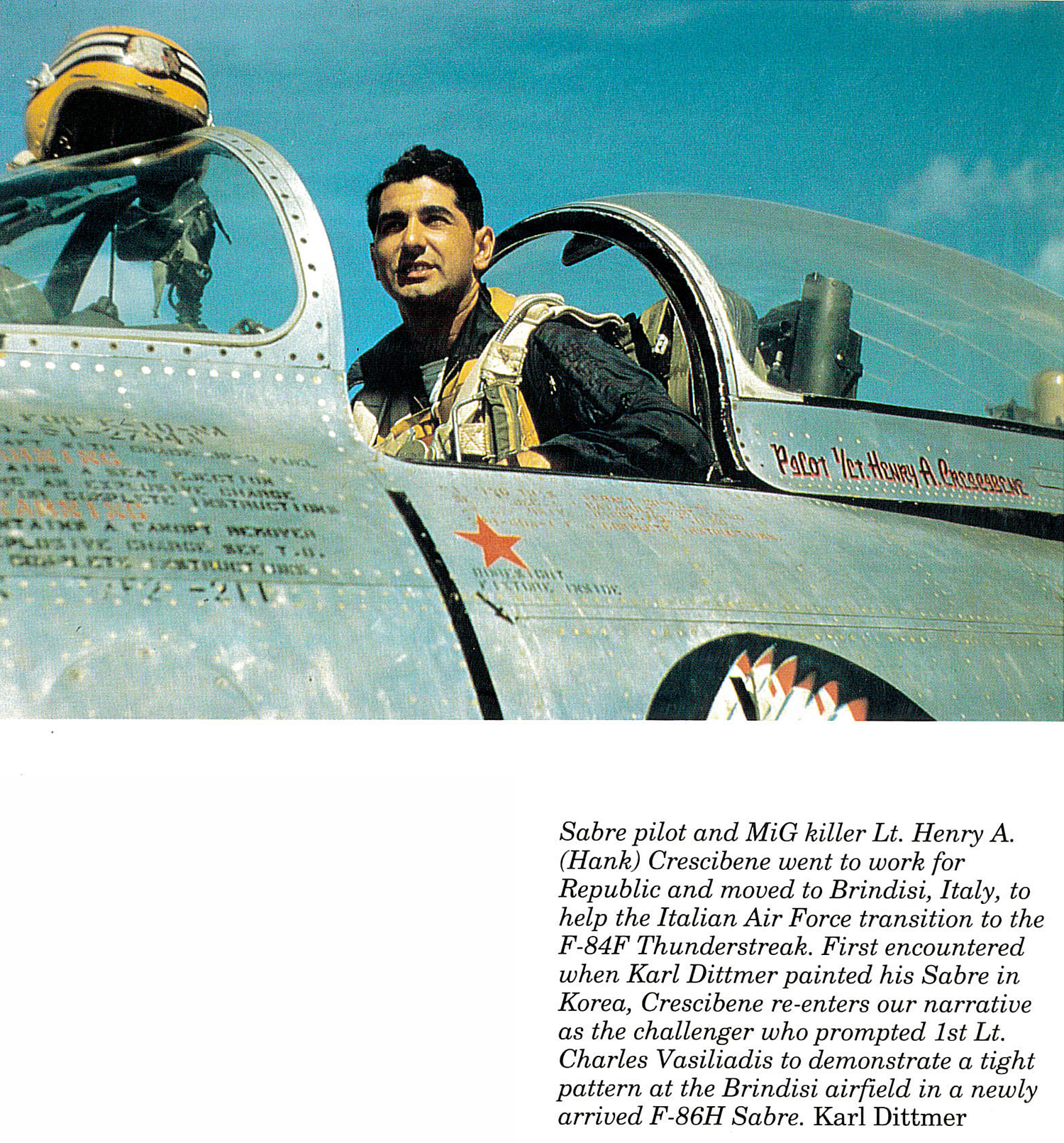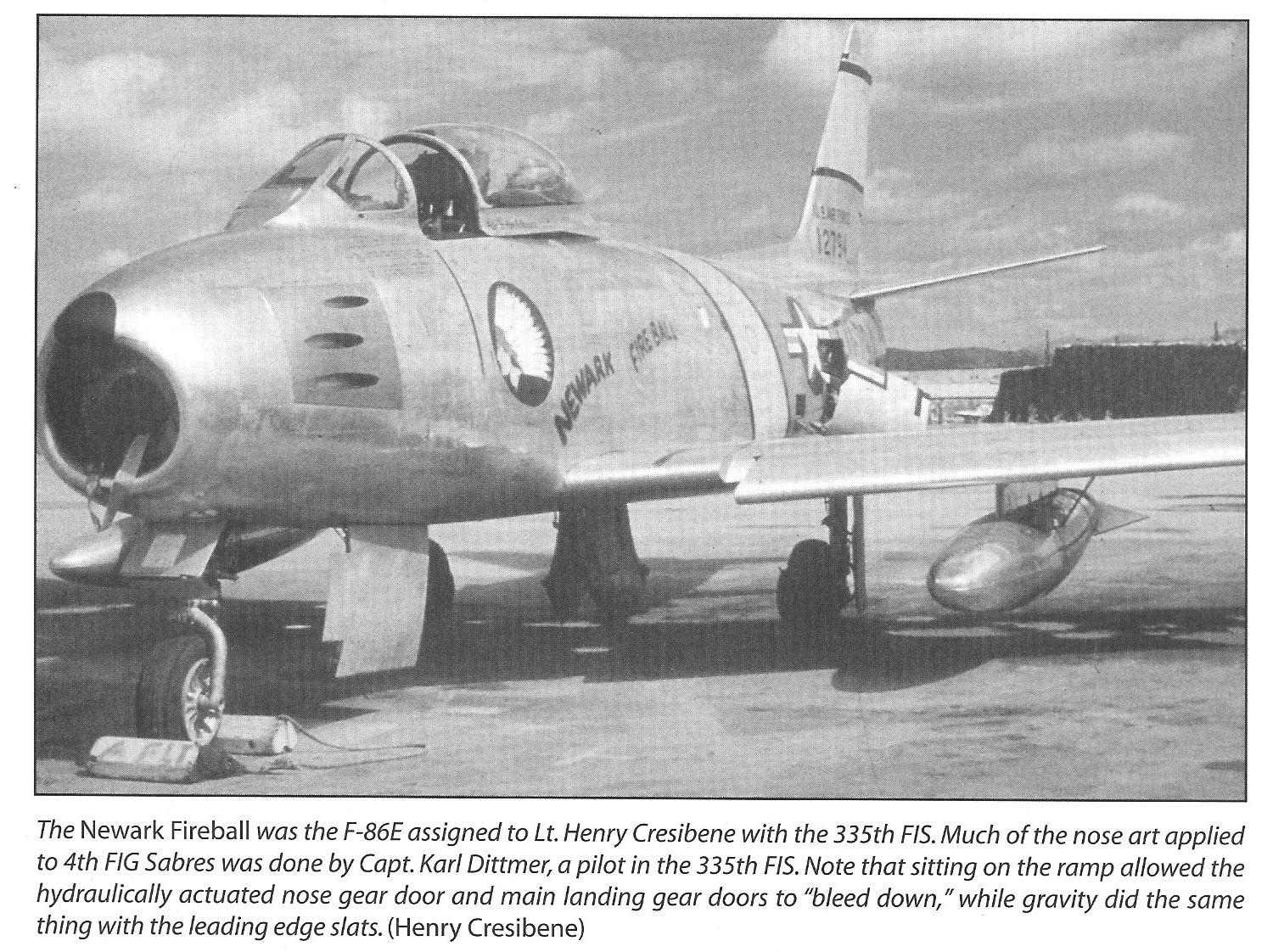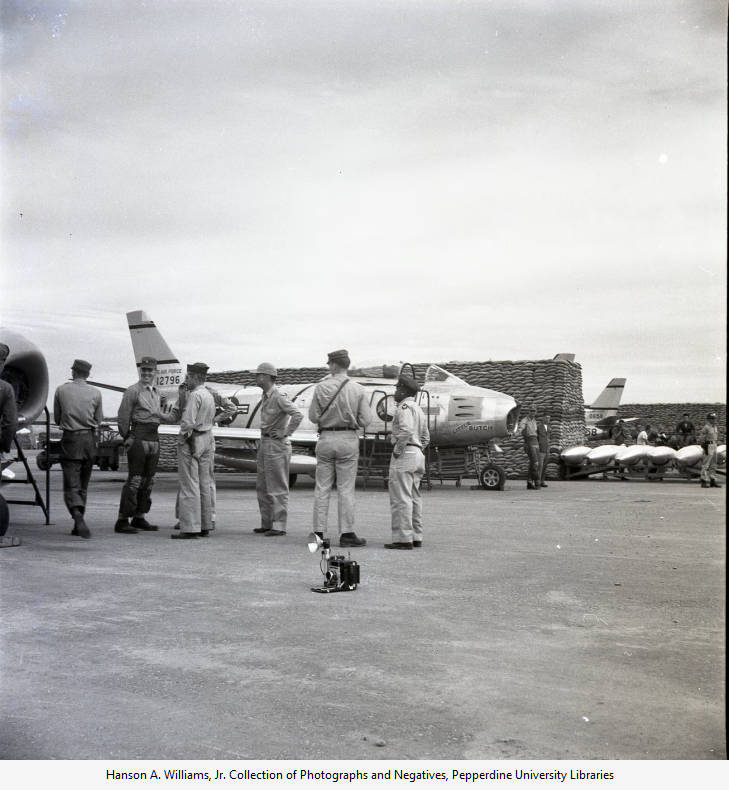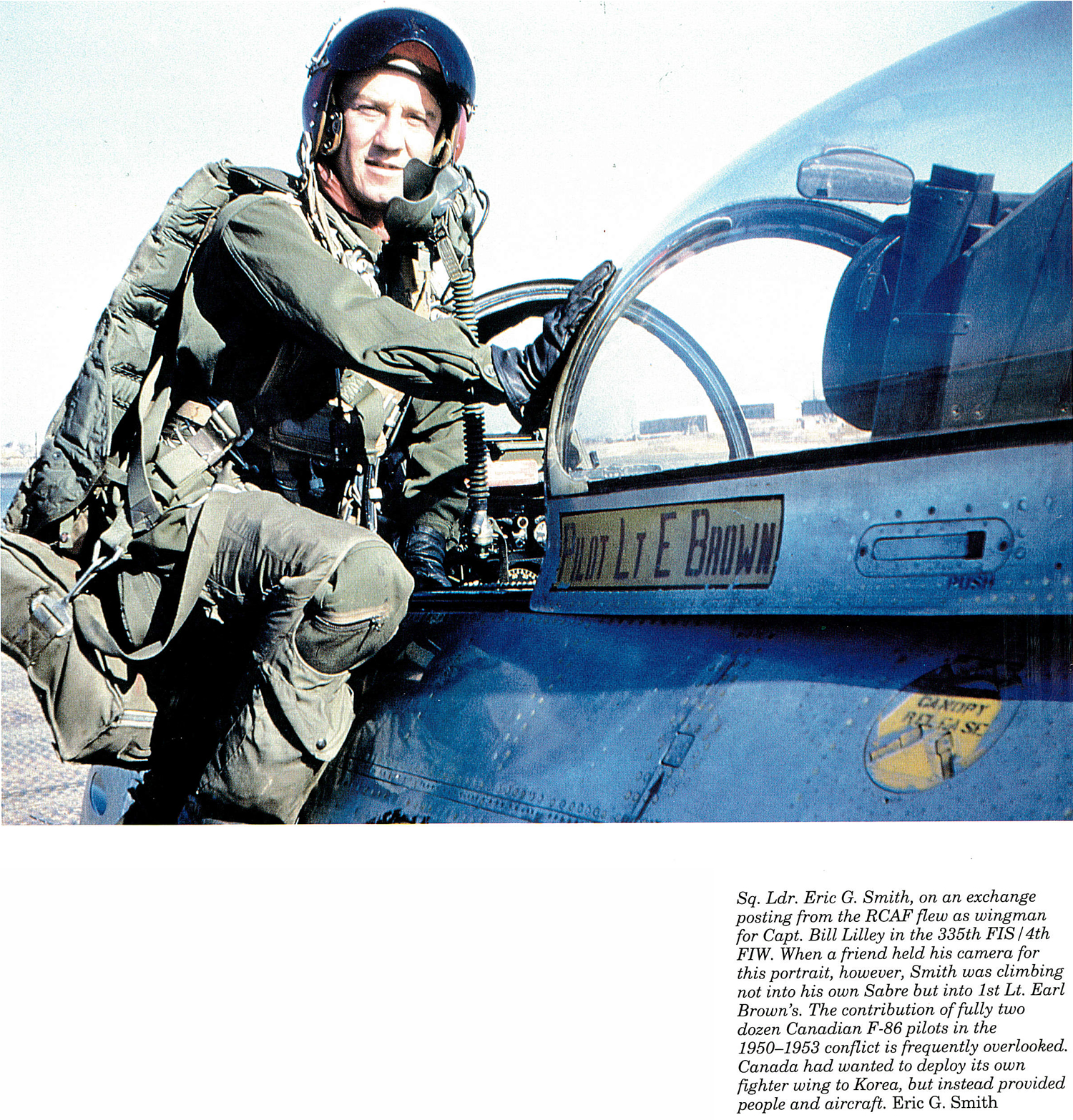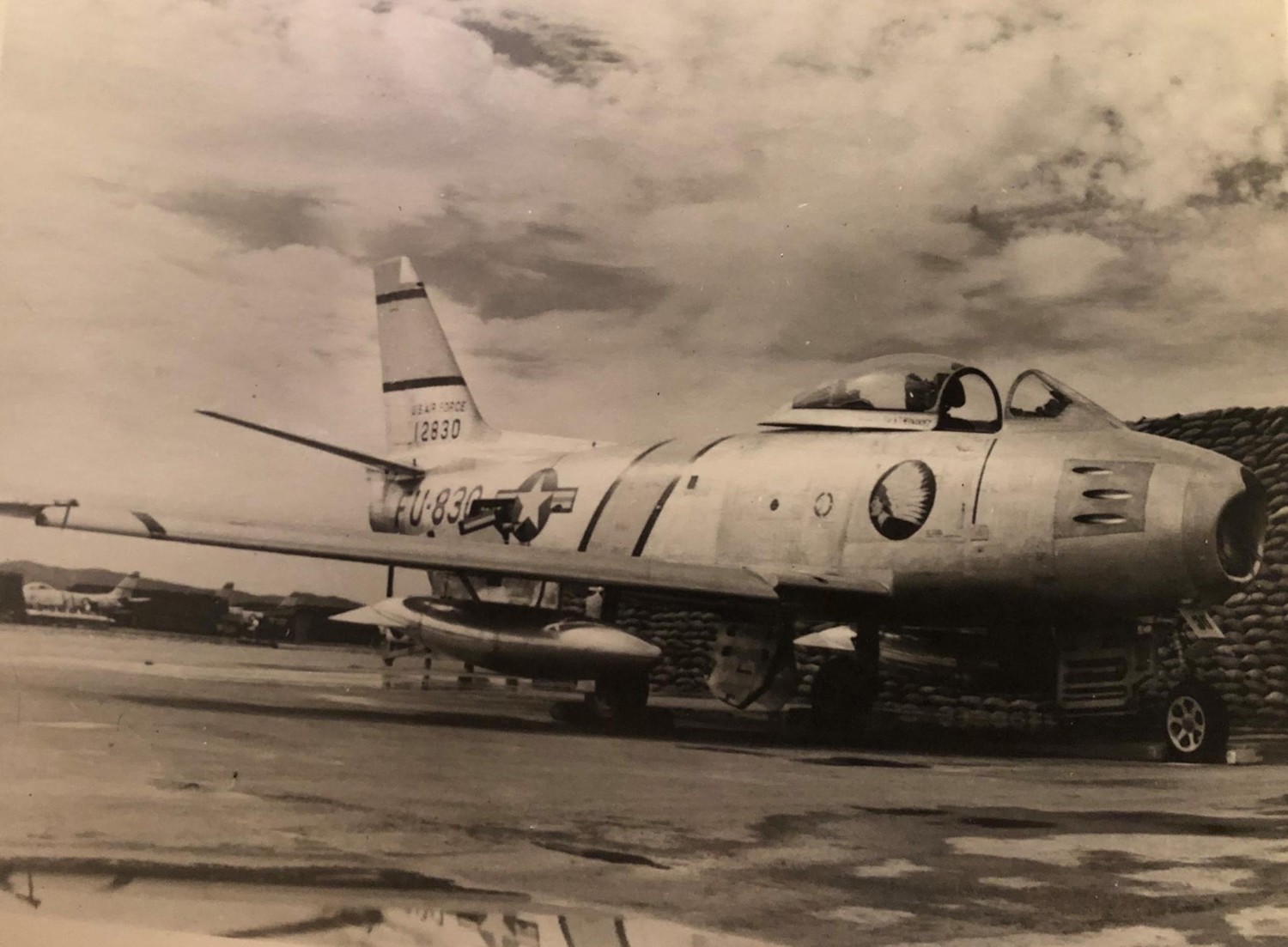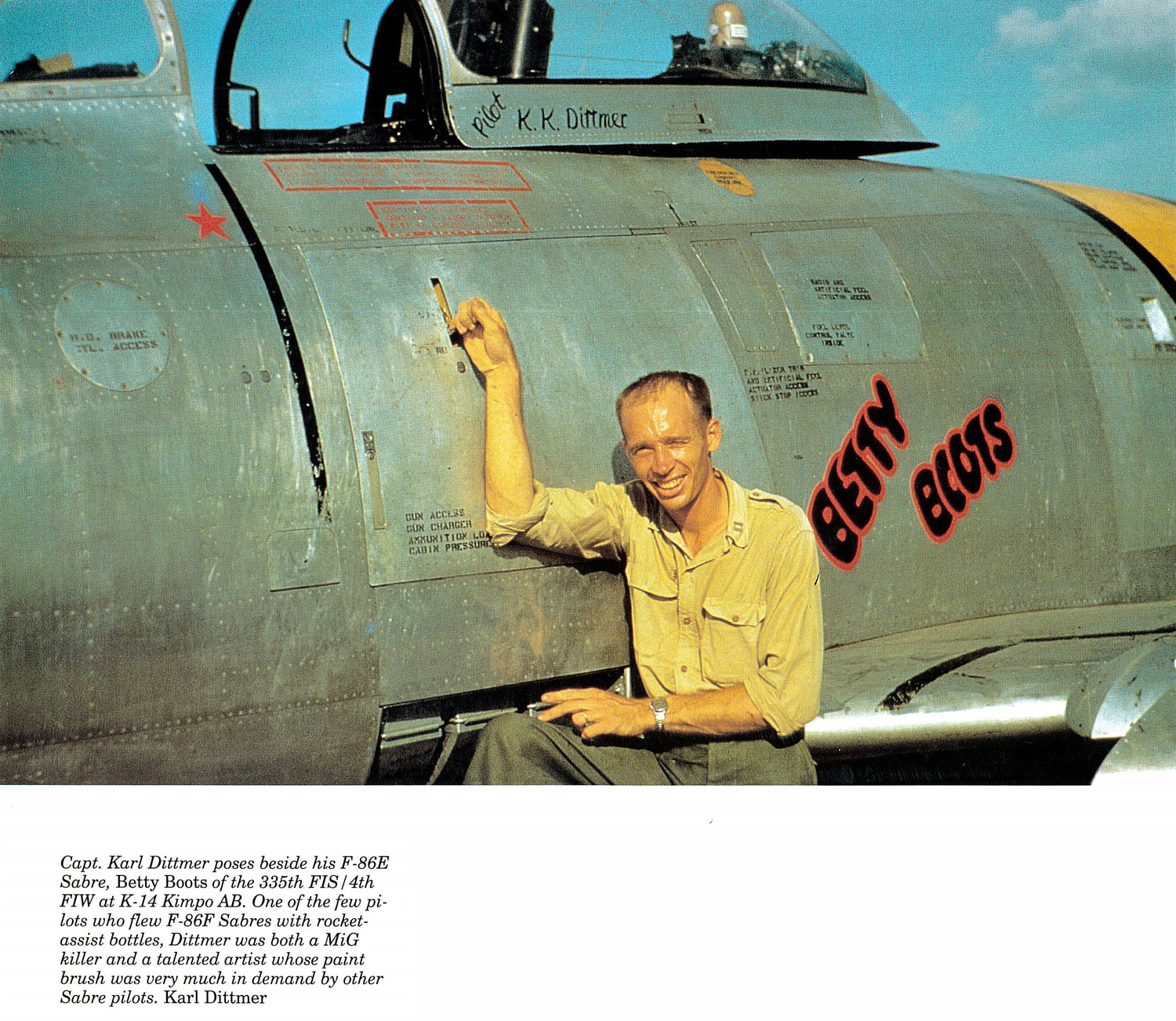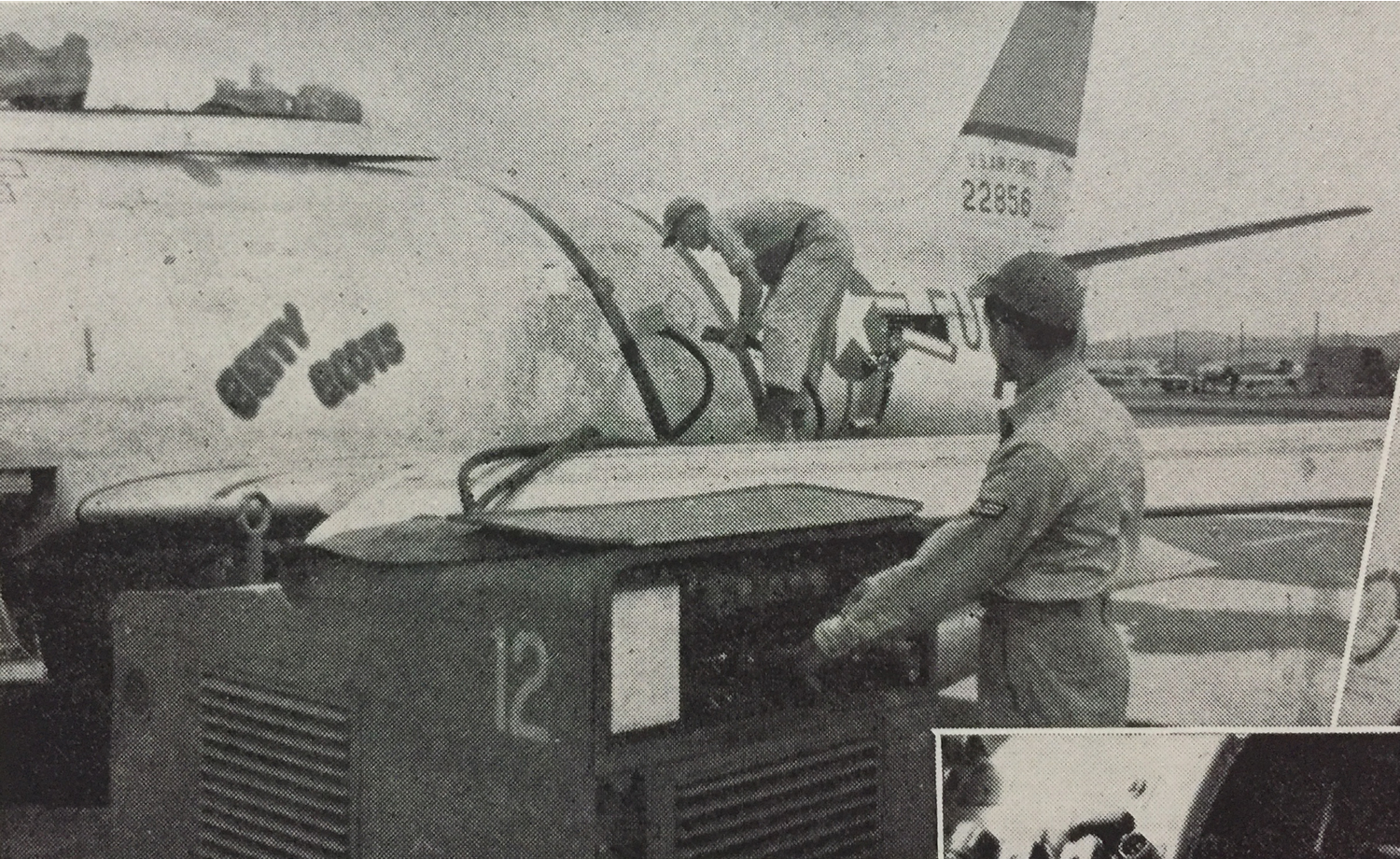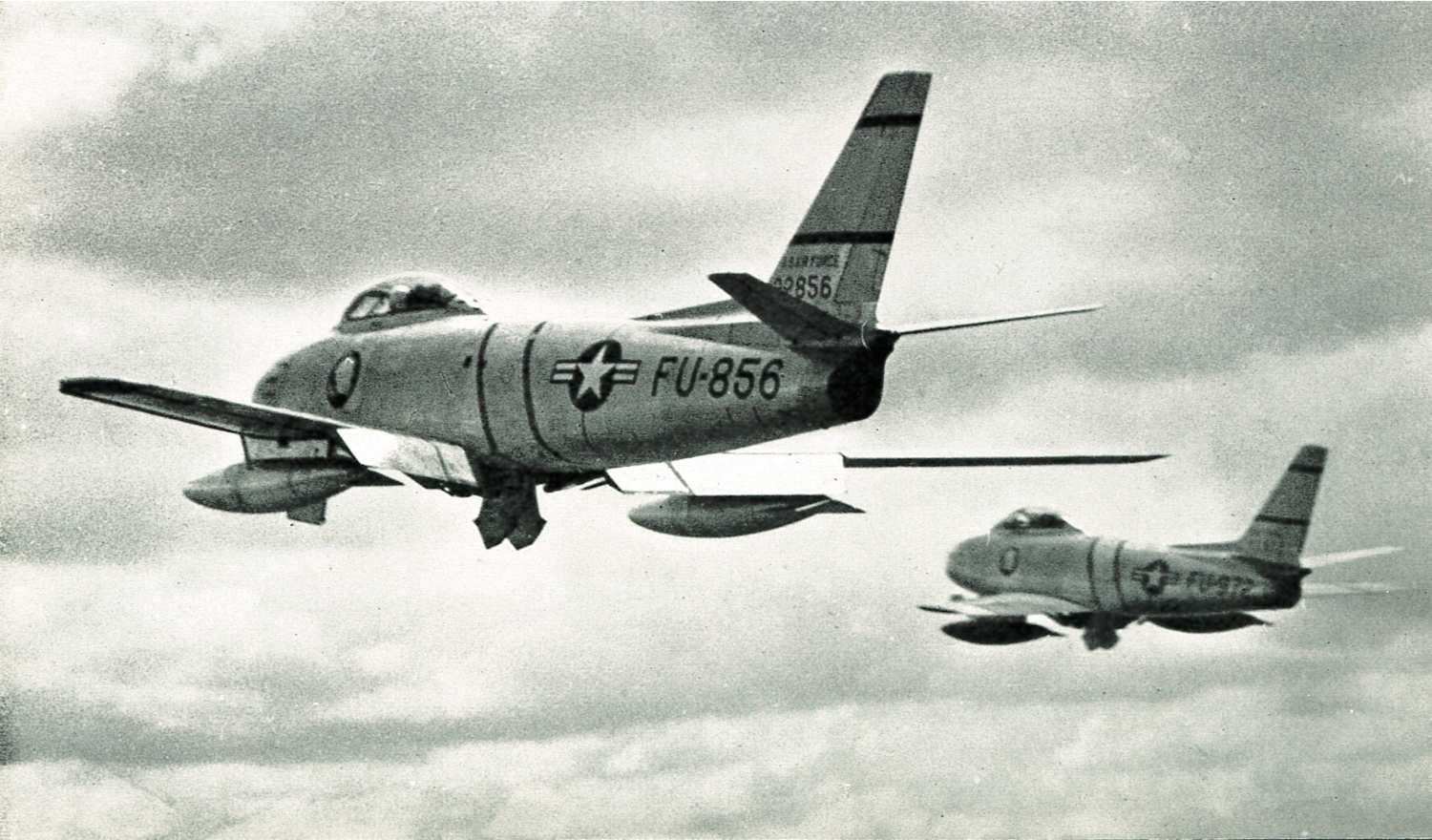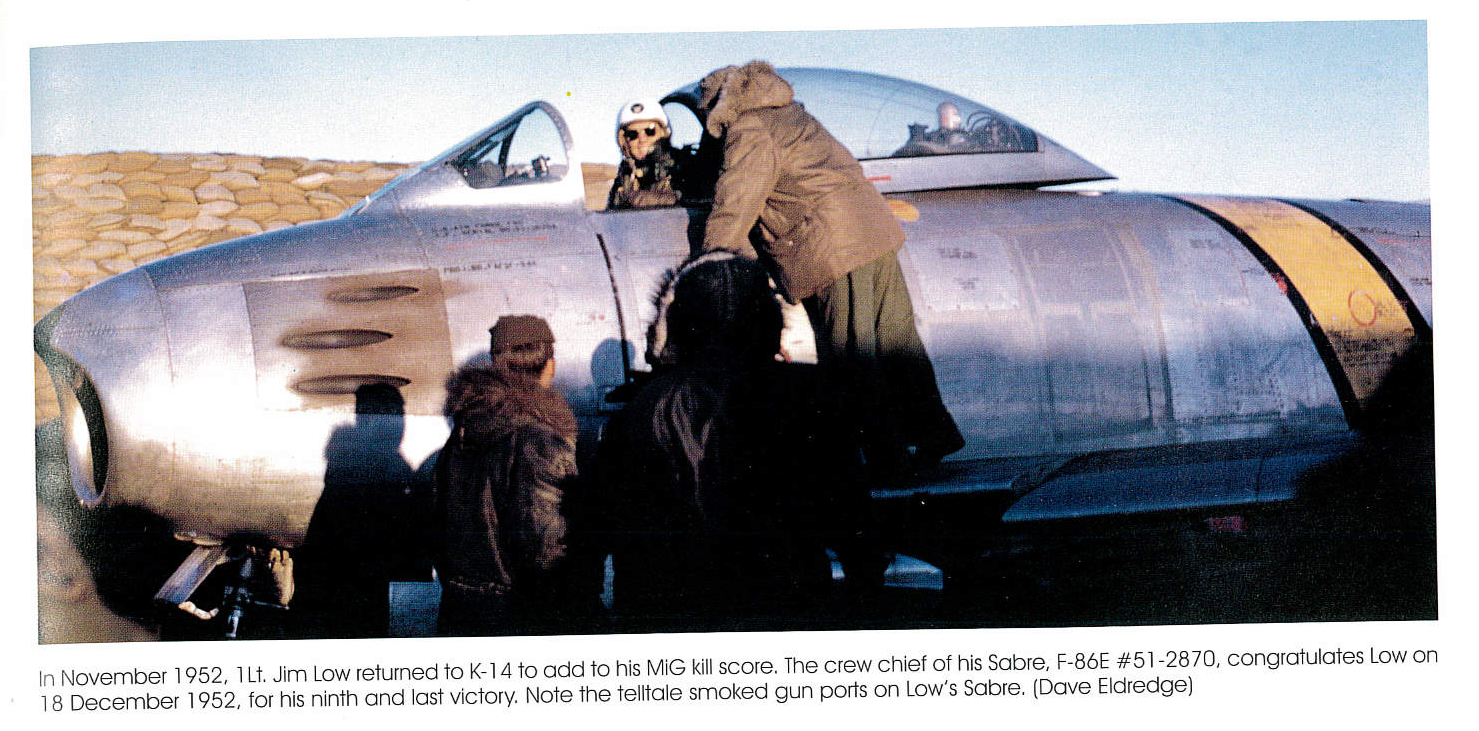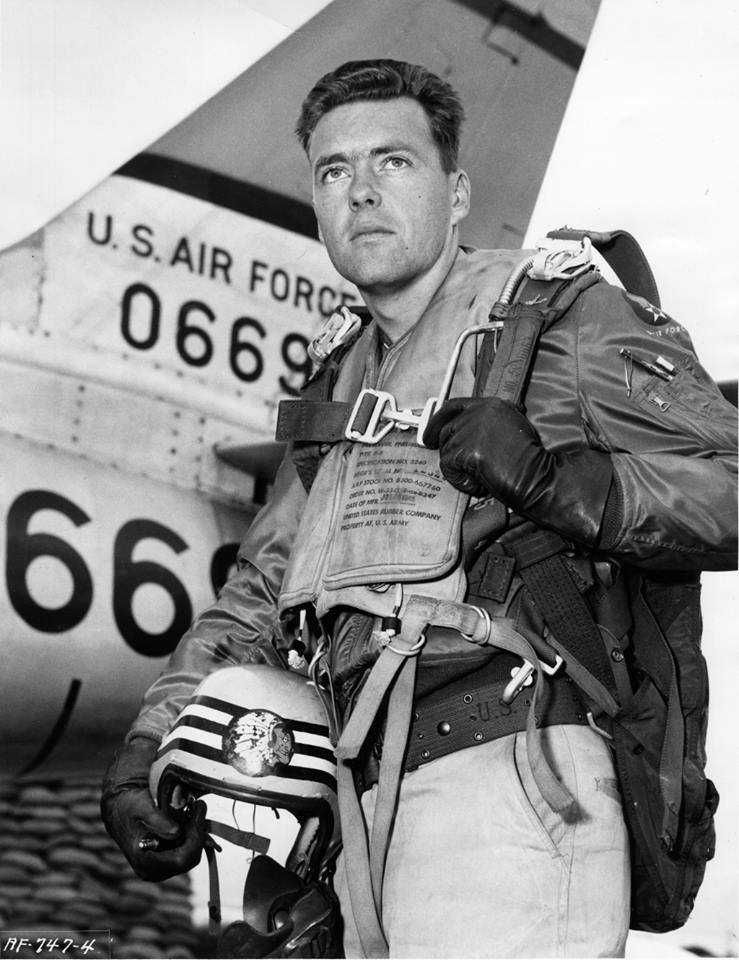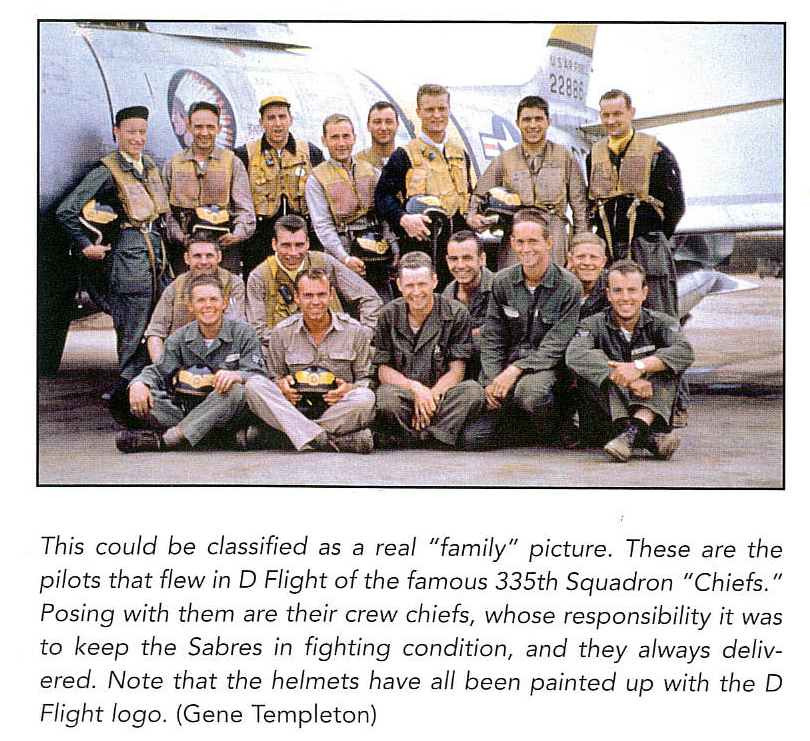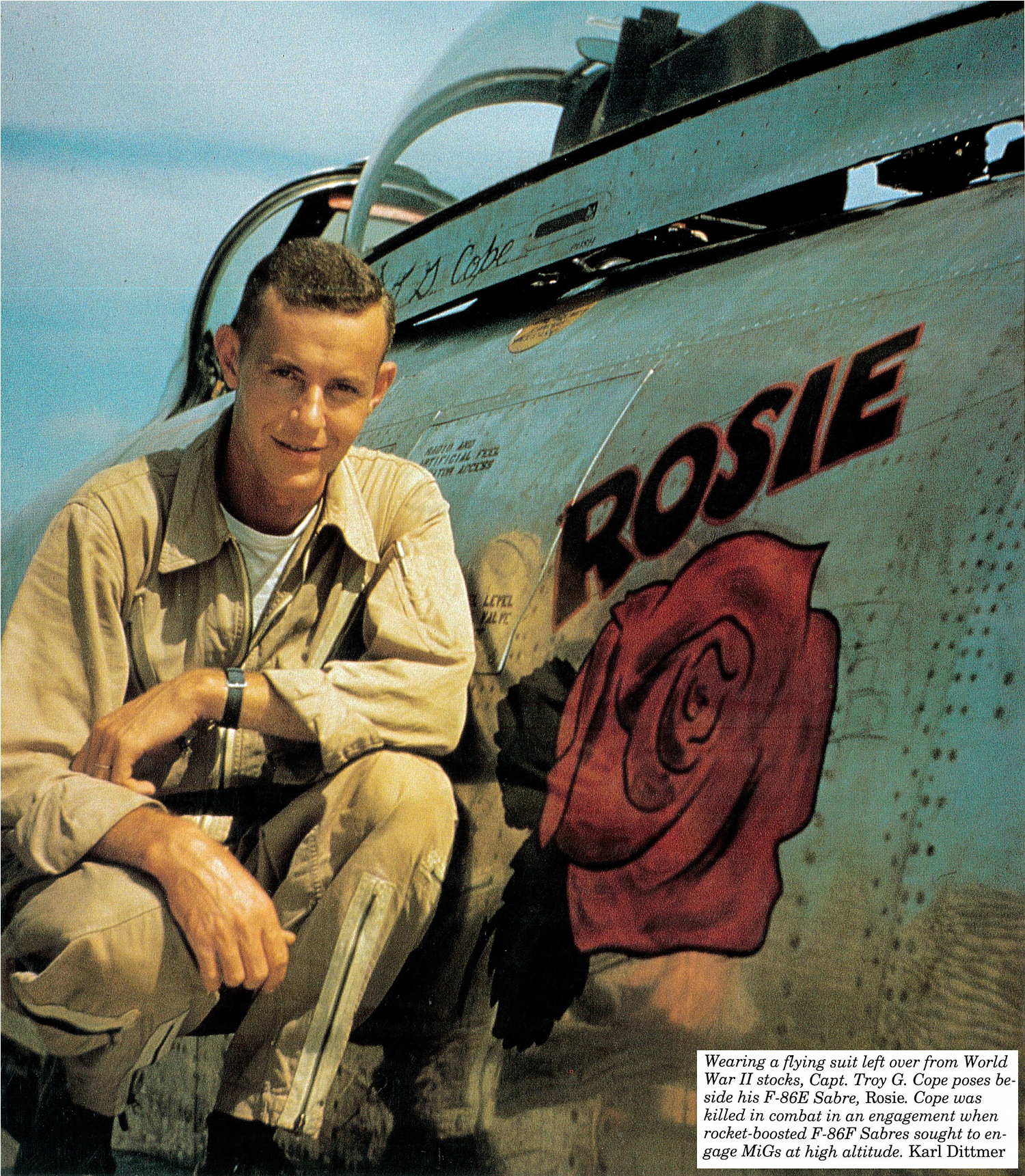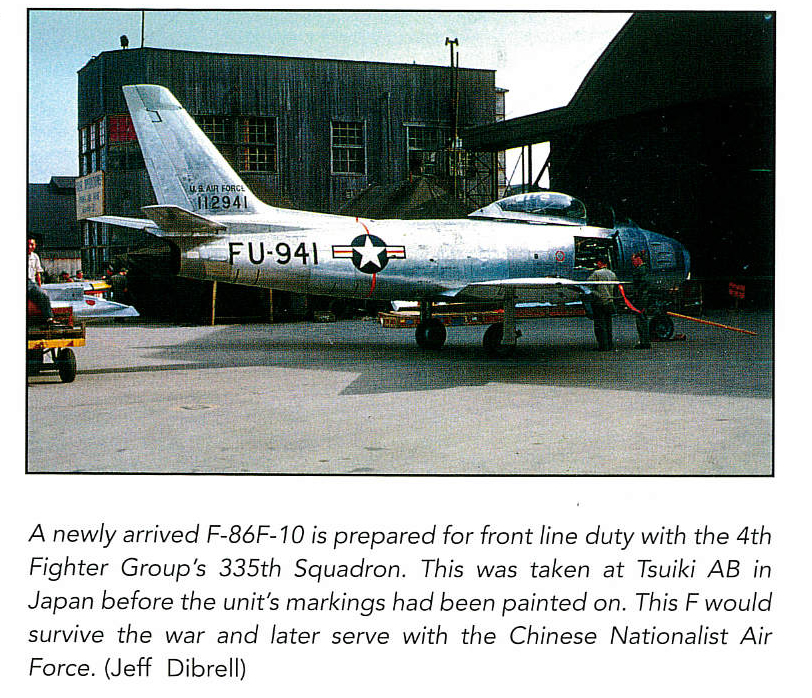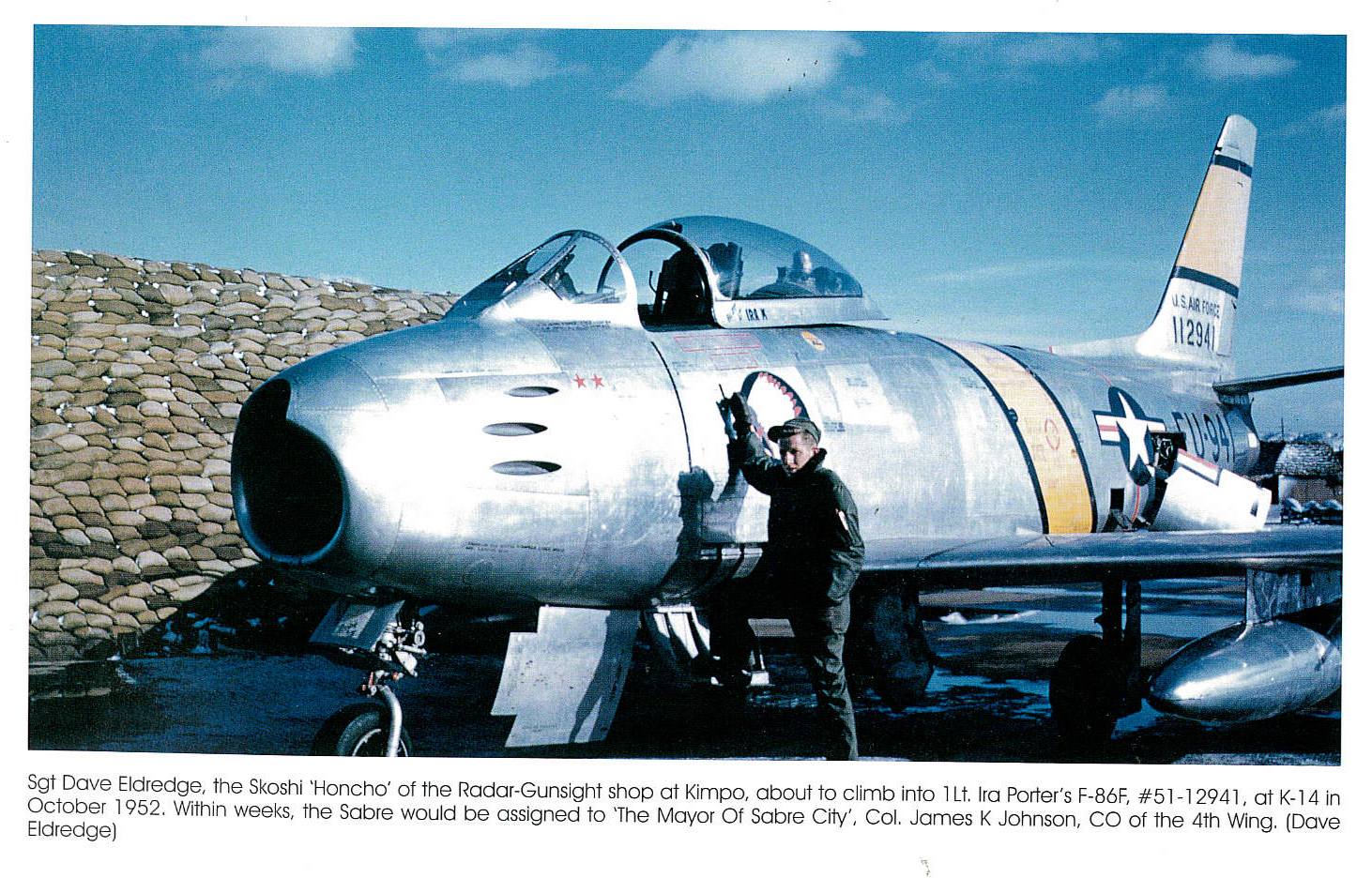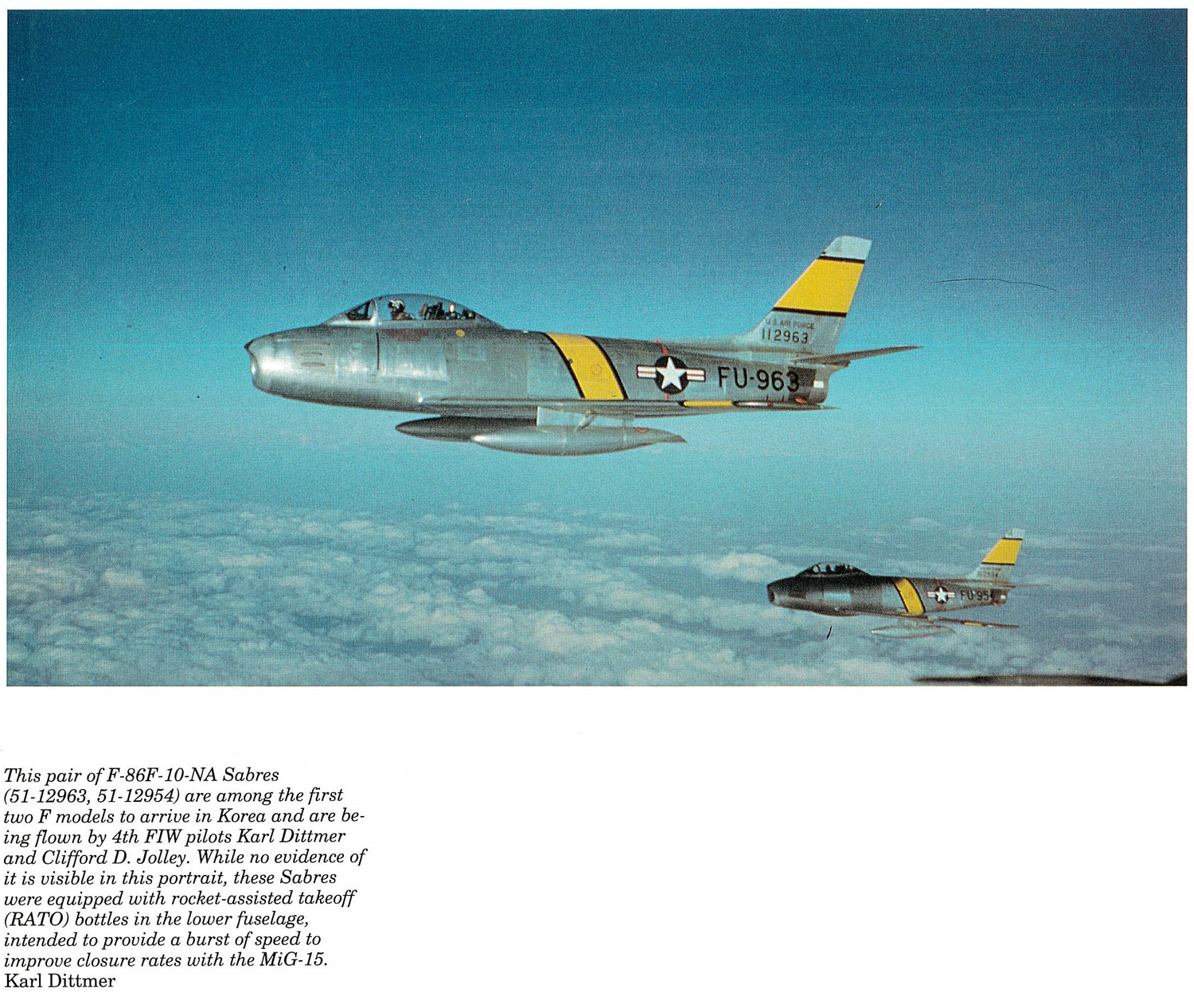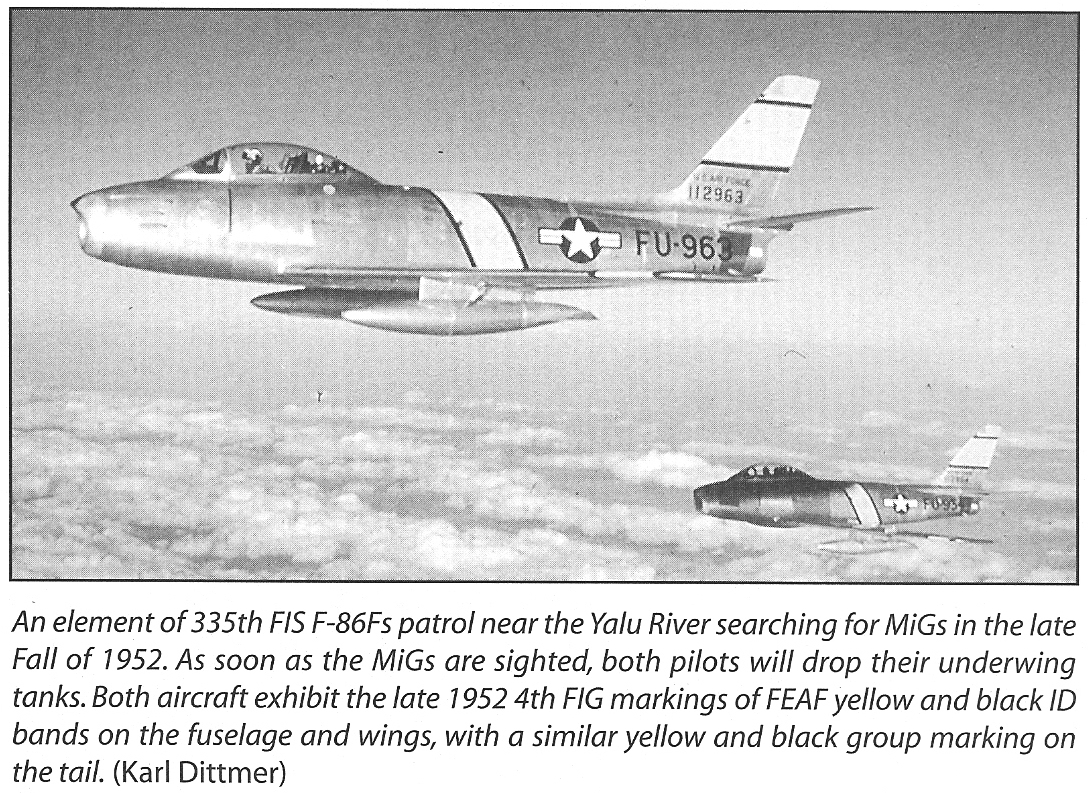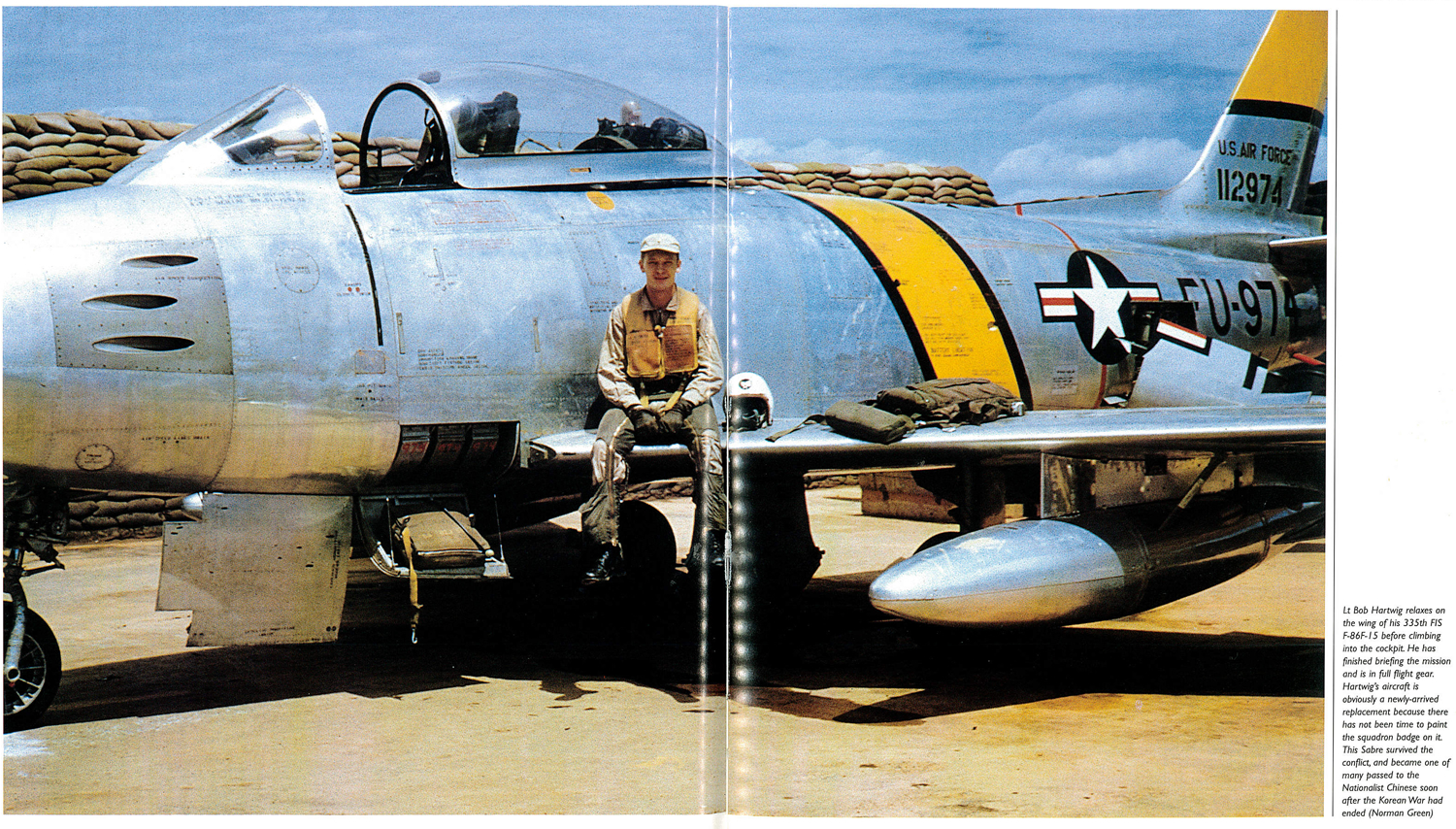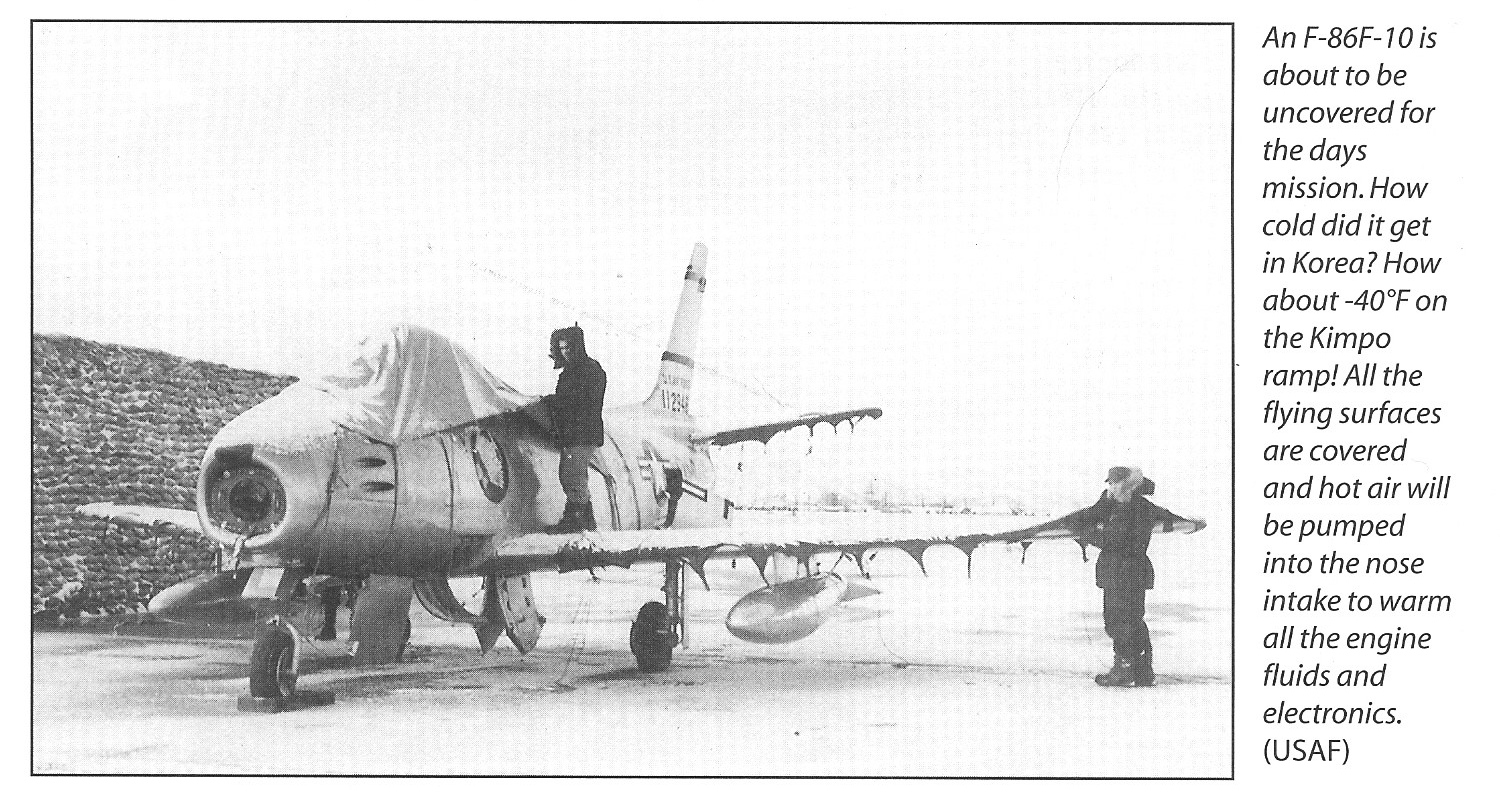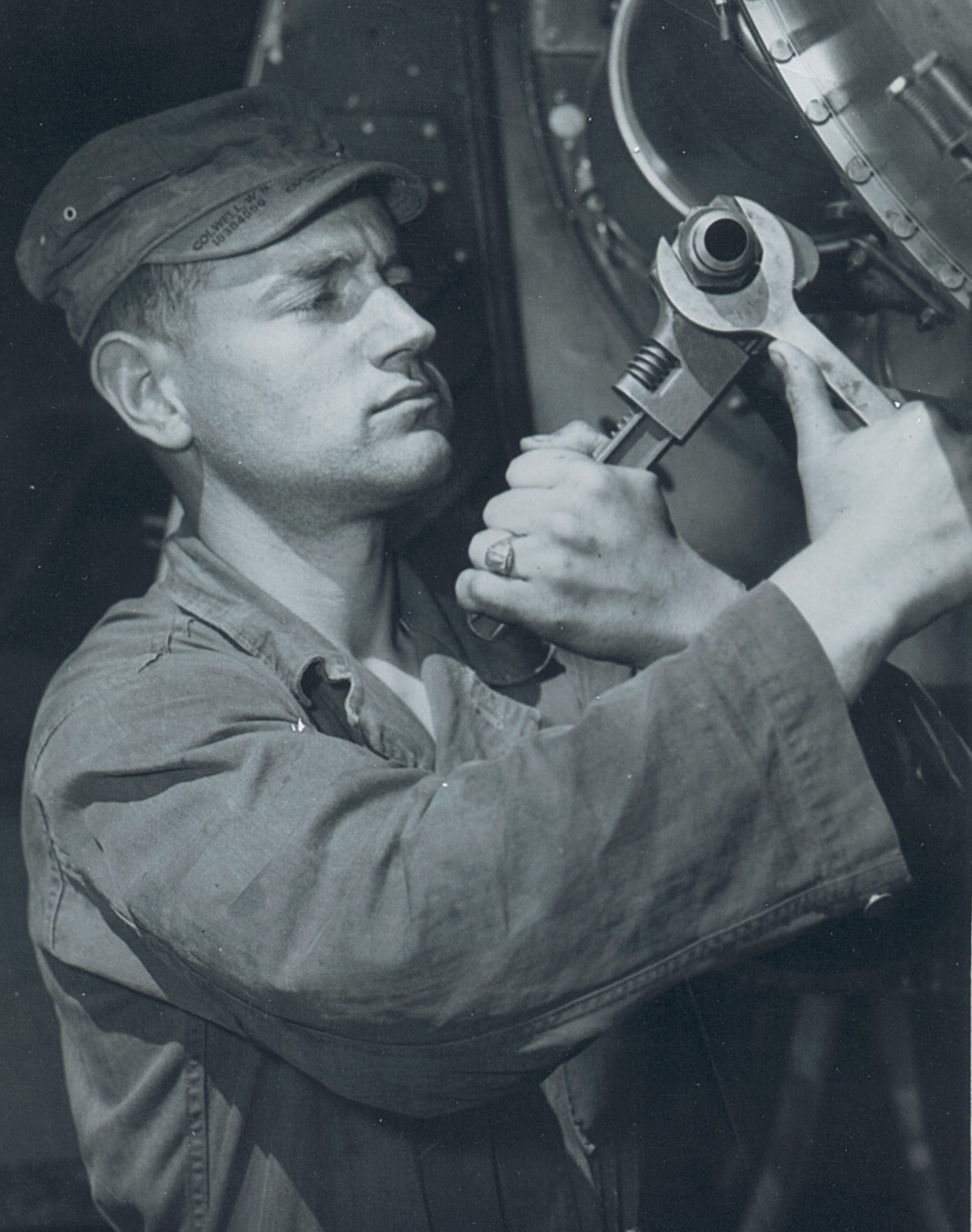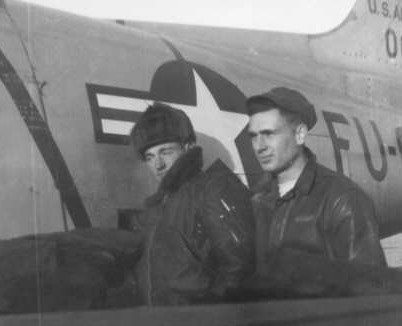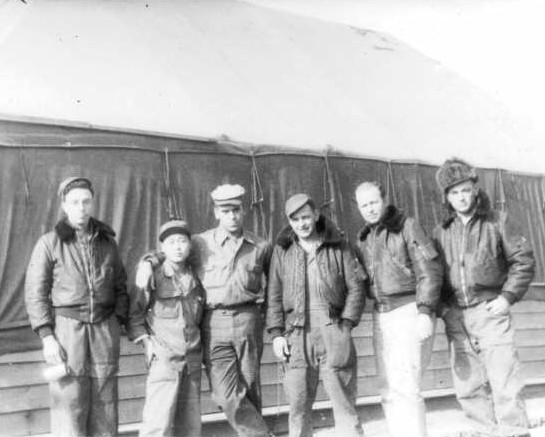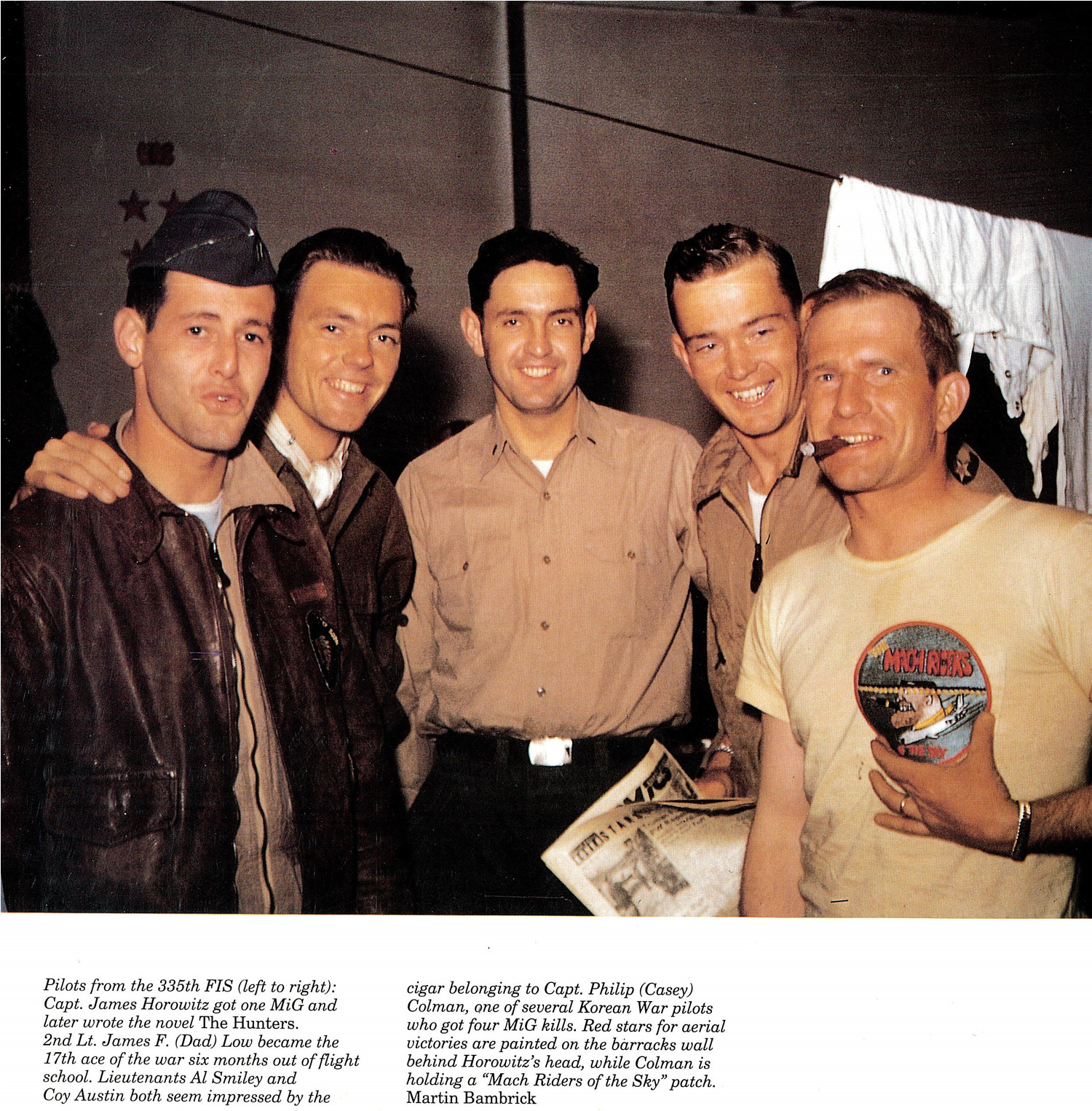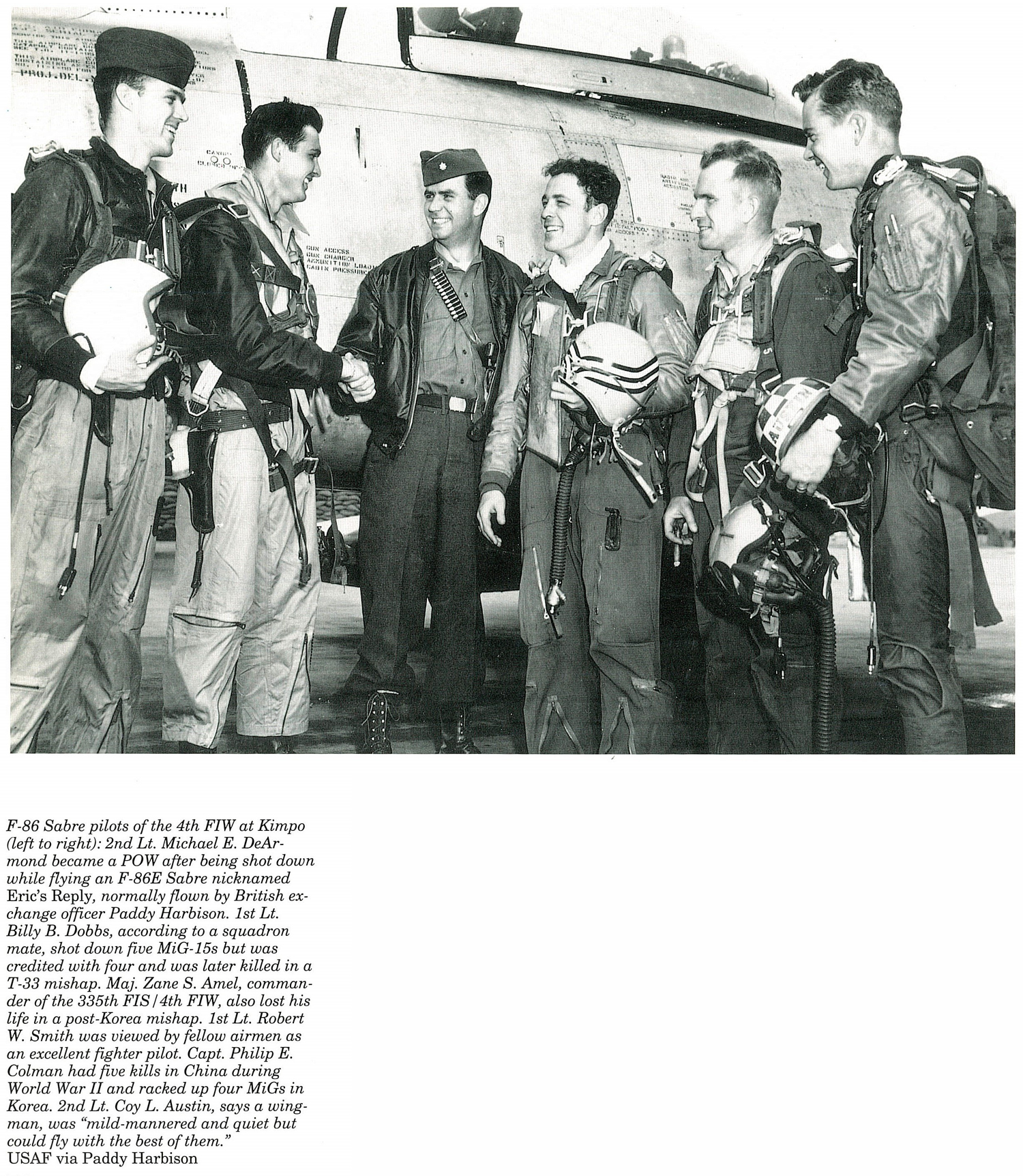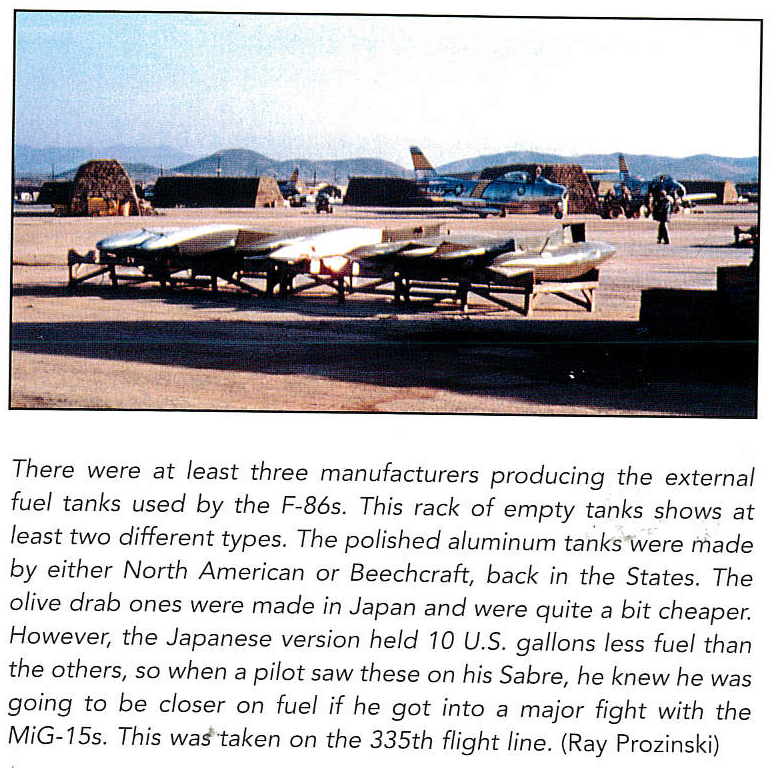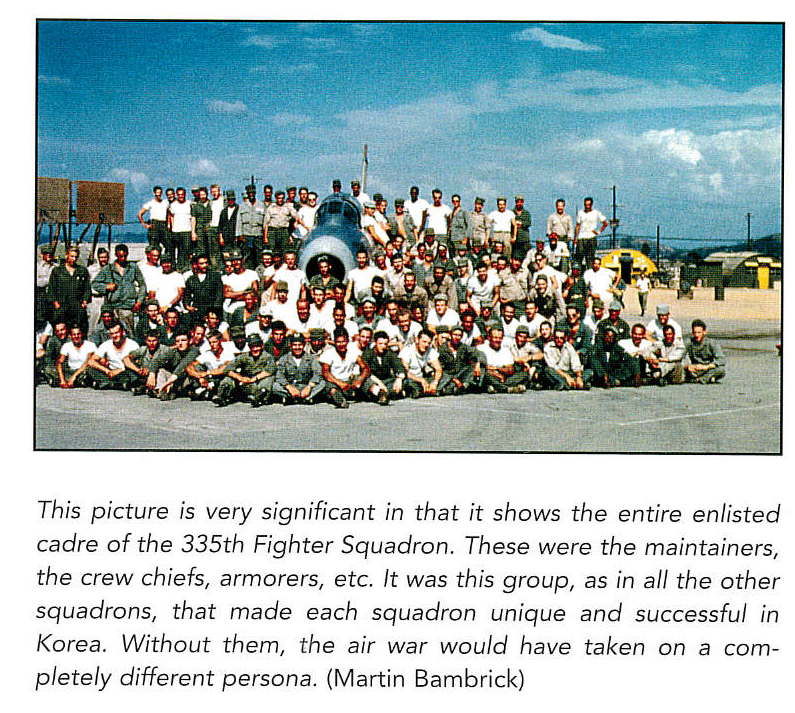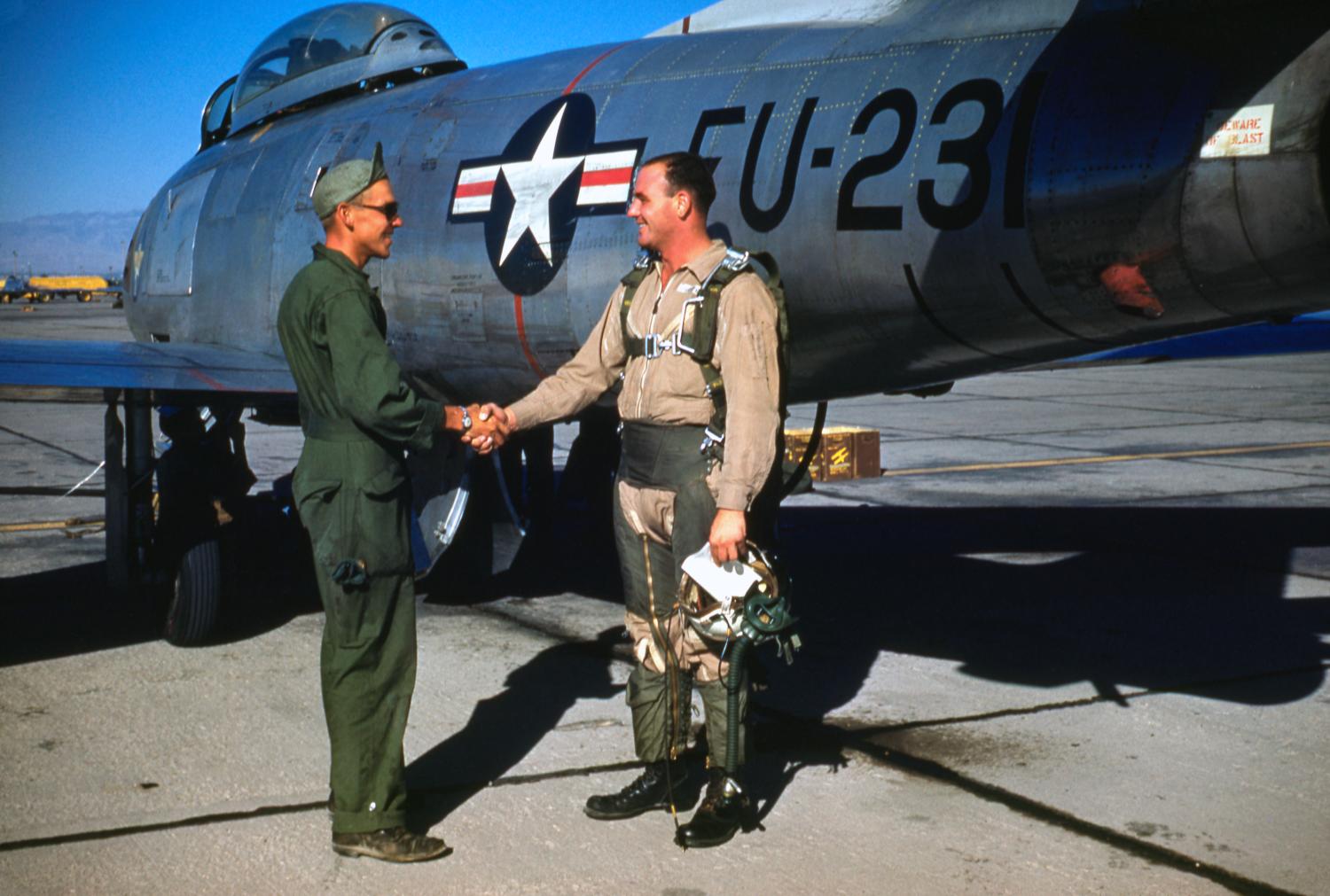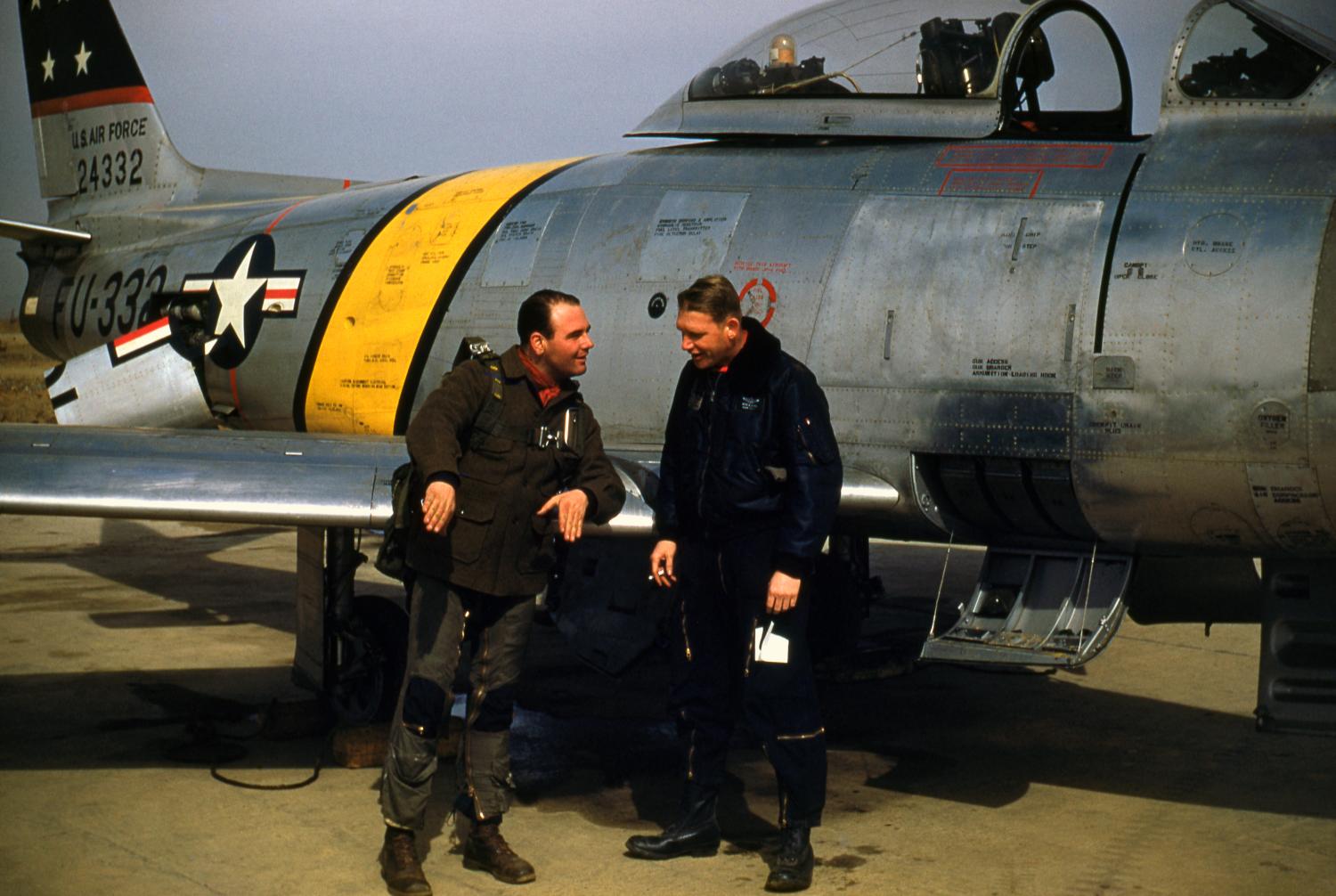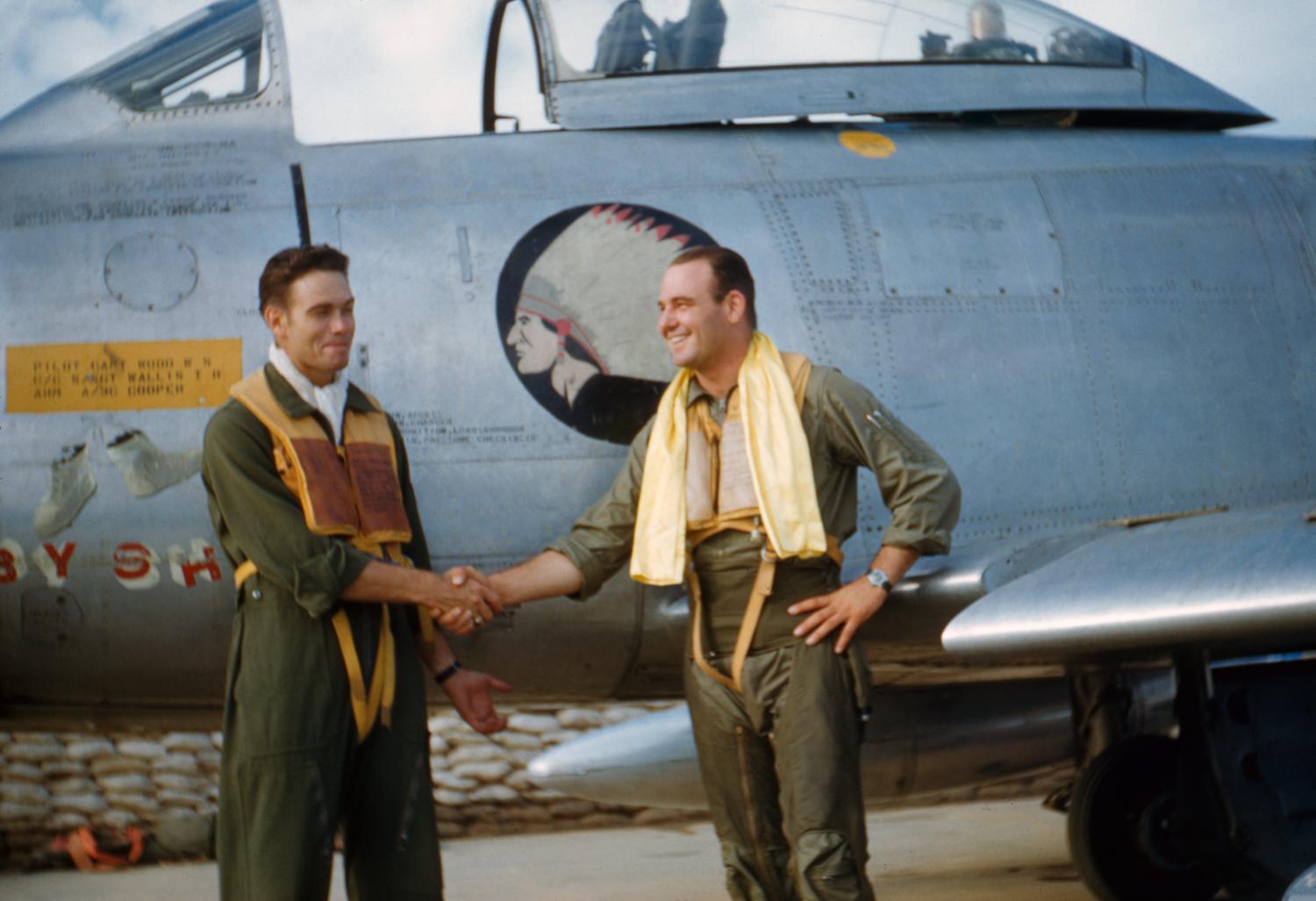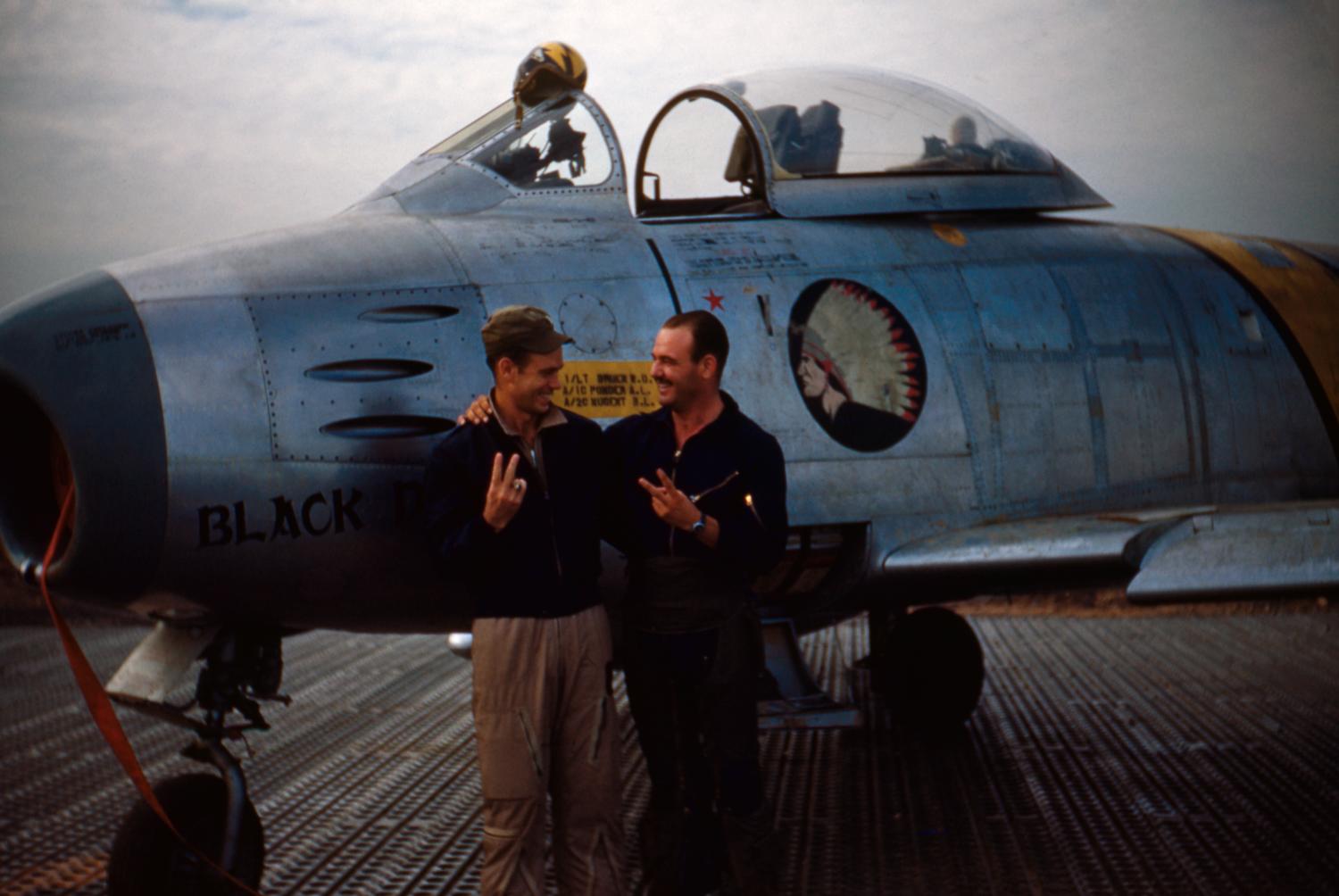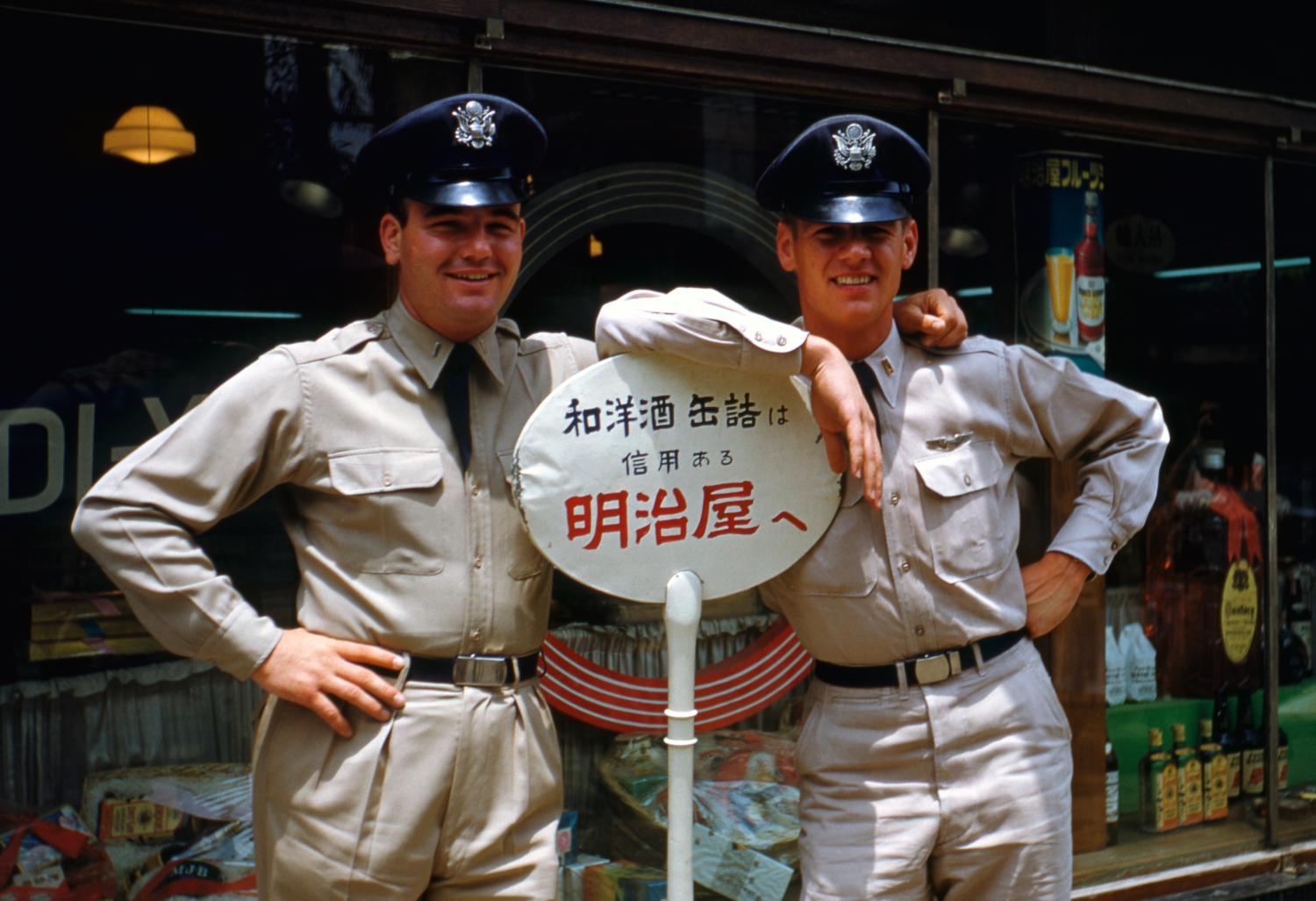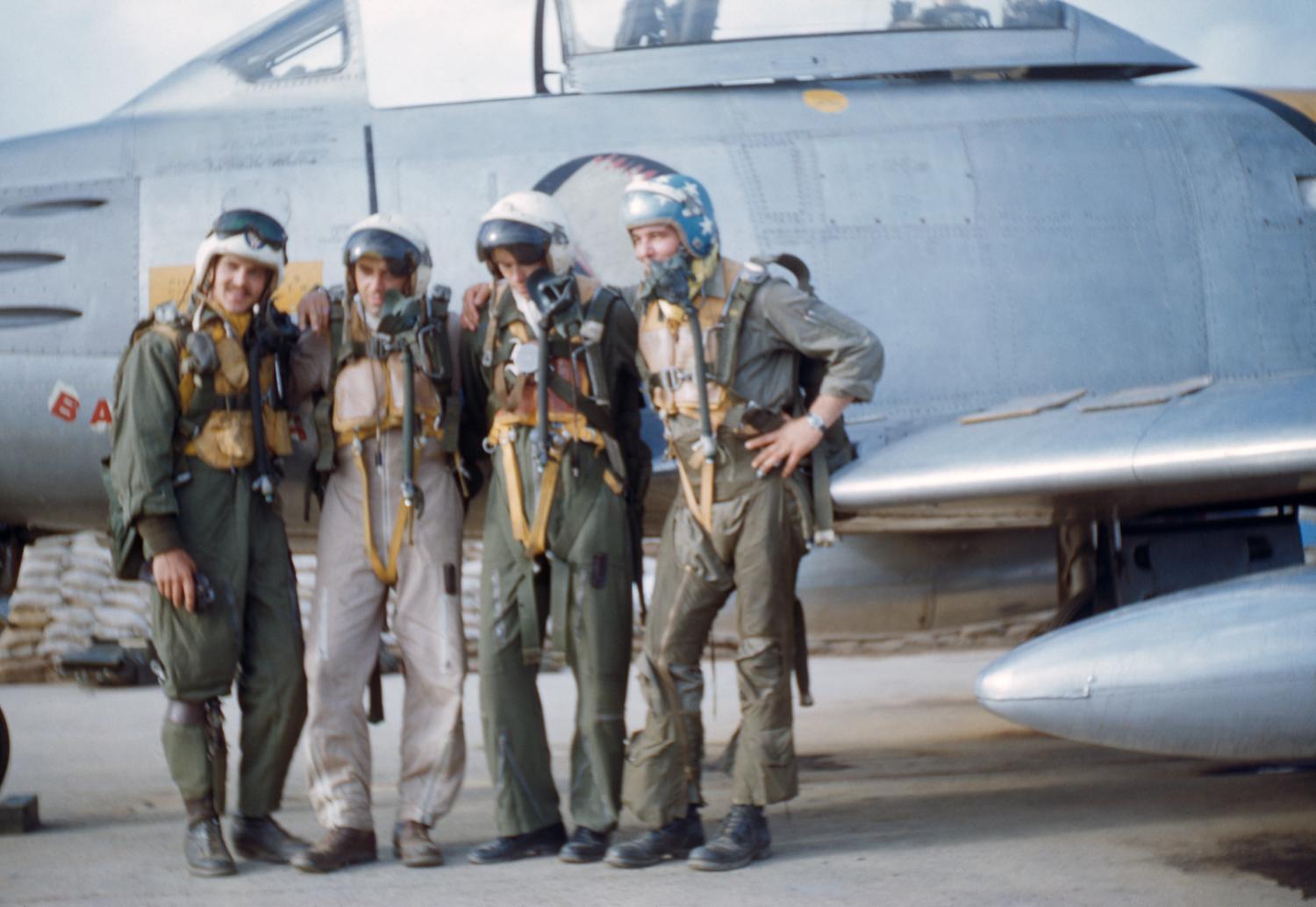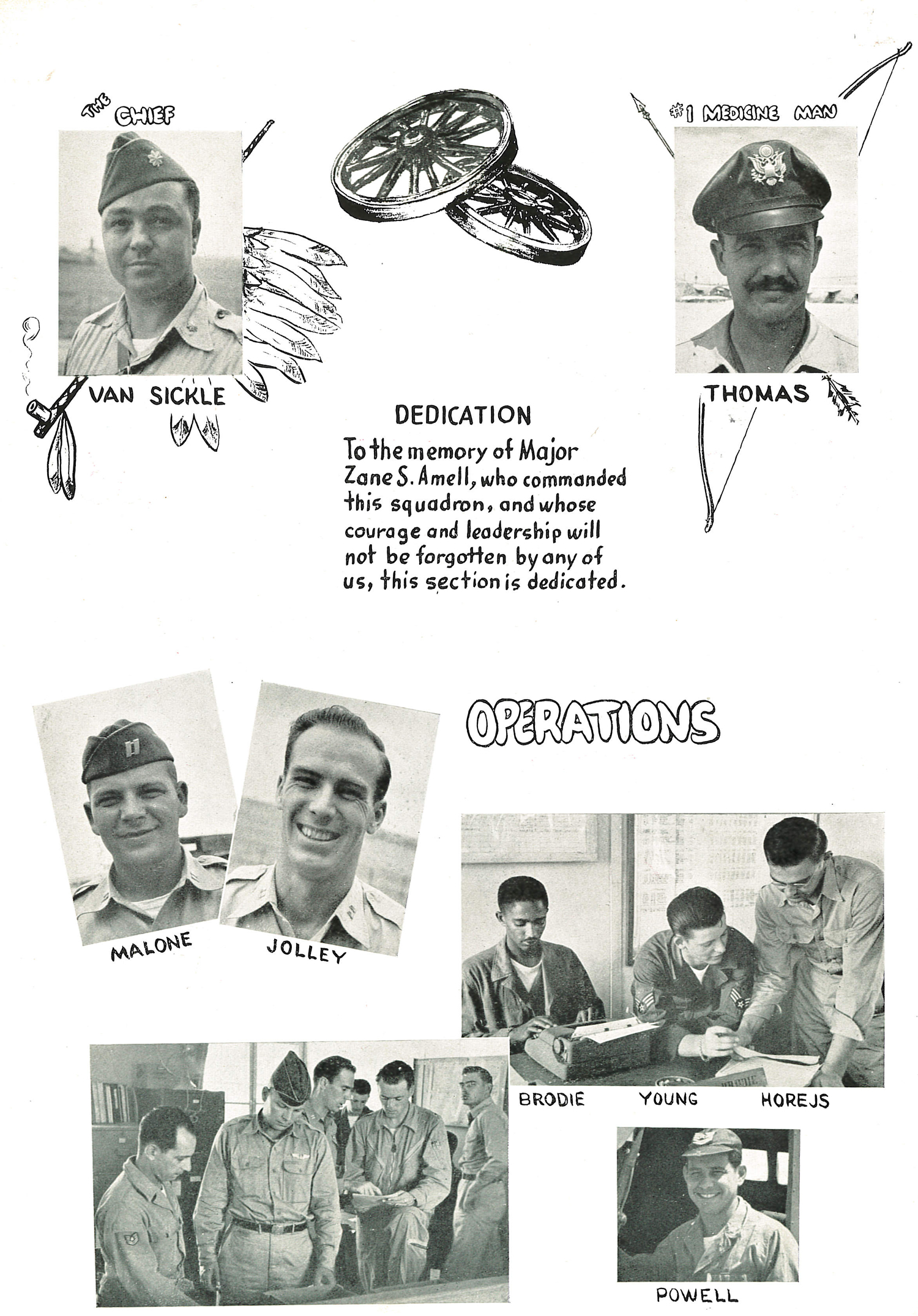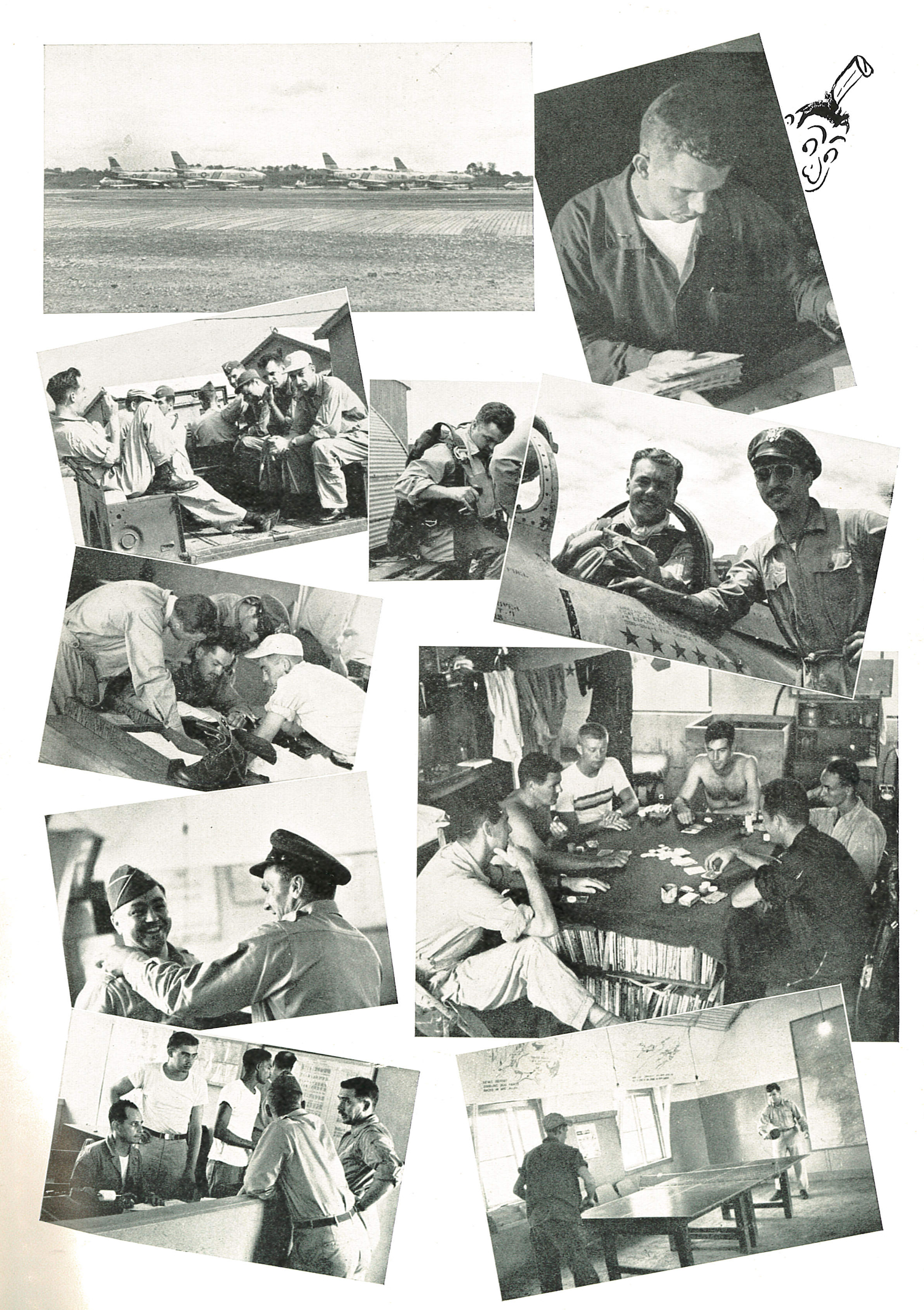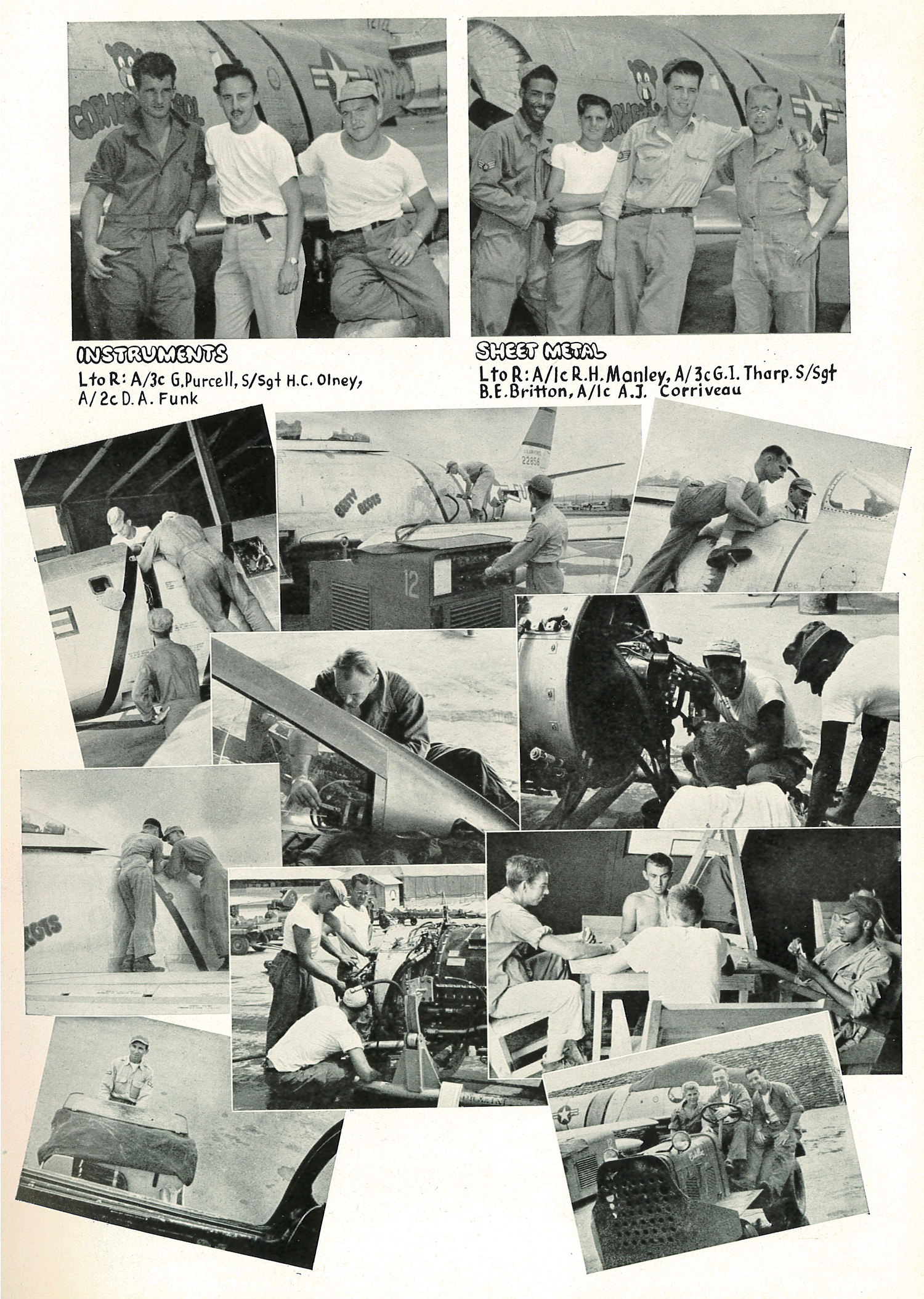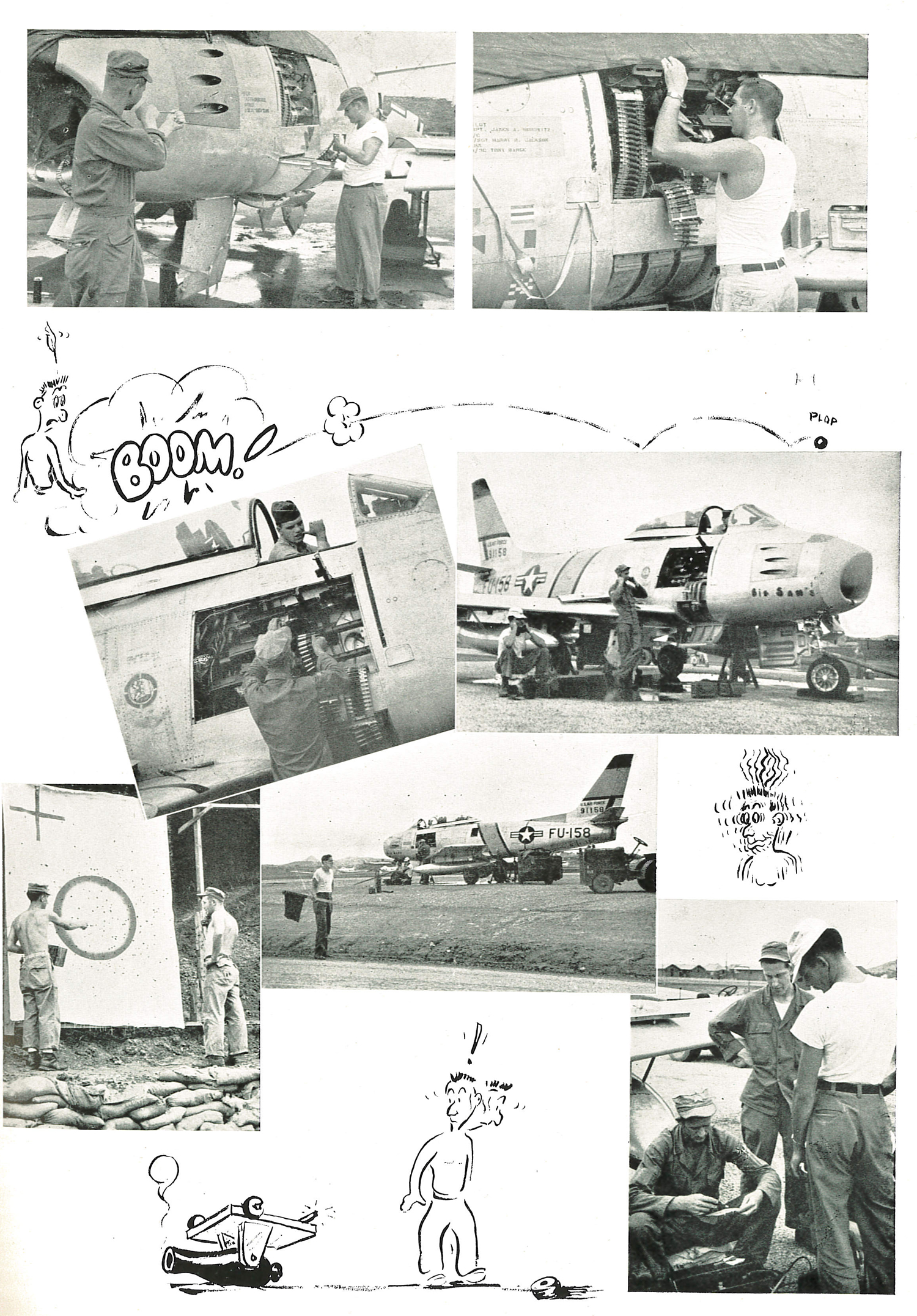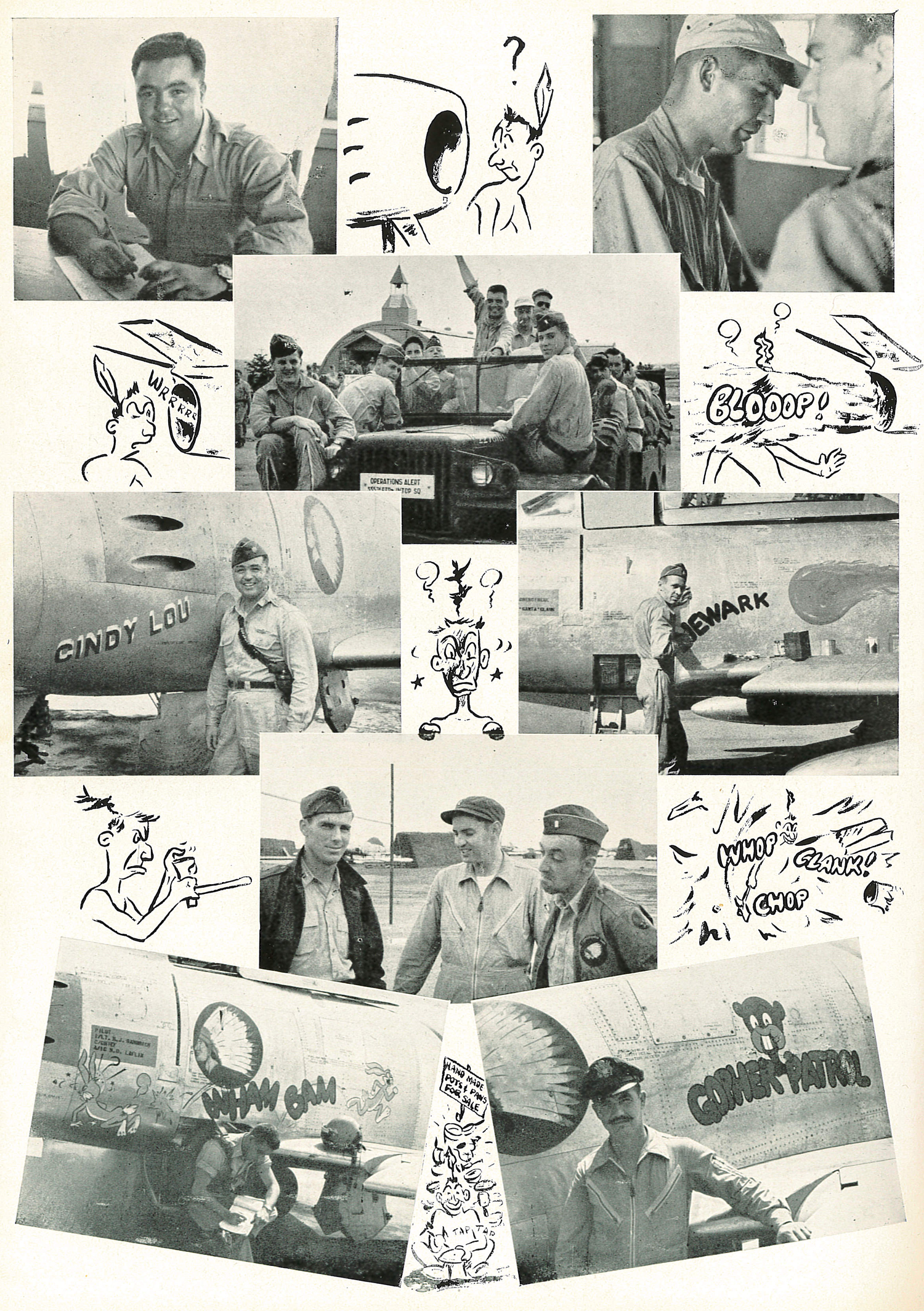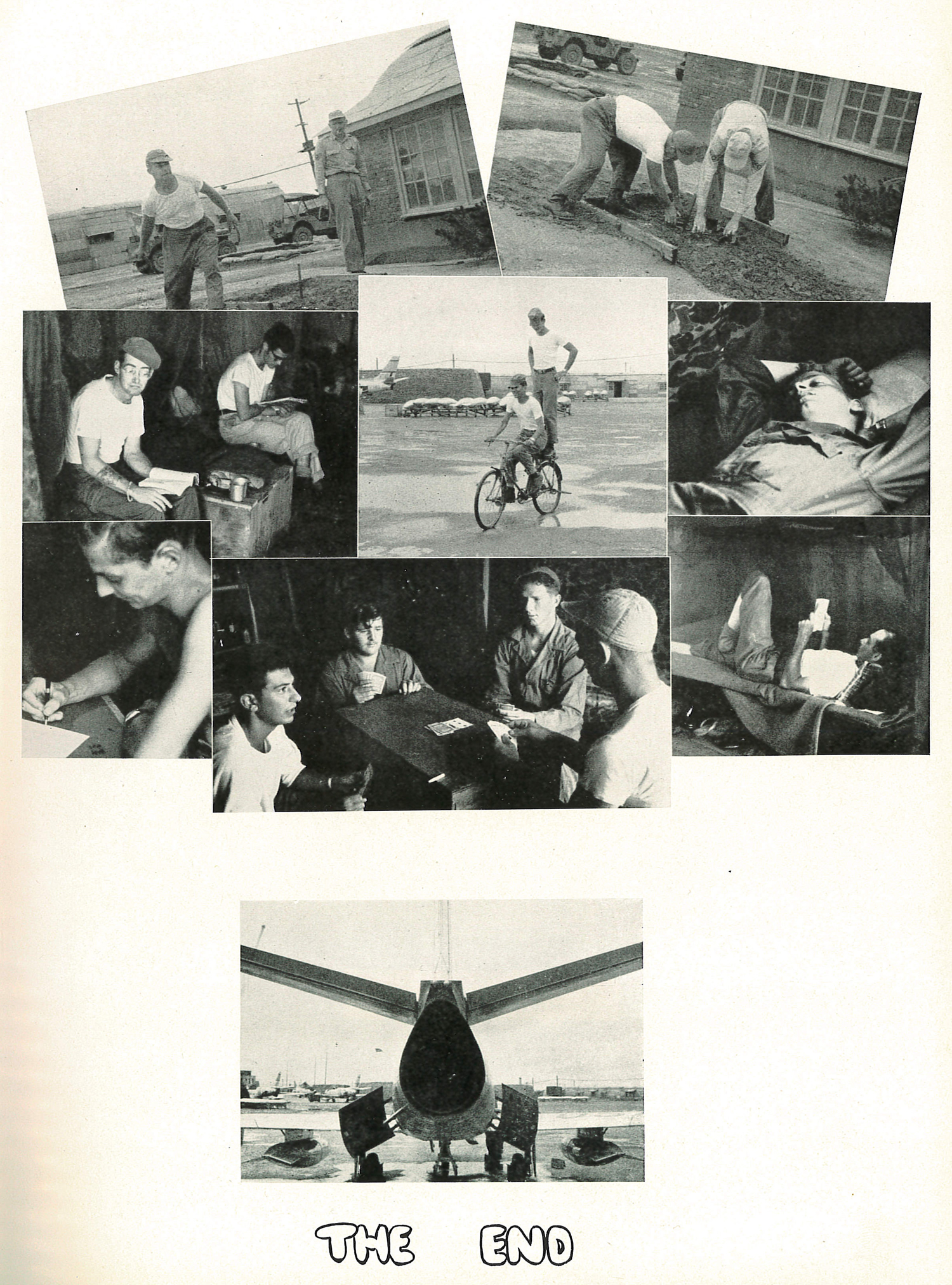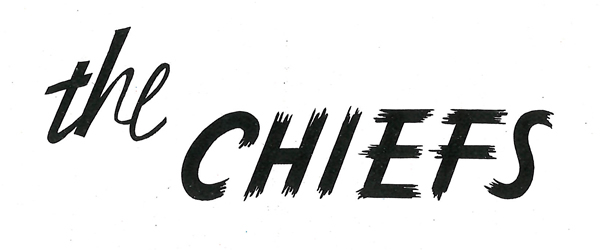Jan. 1: As almost half
a million CCF and North Korean troops launched a new ground offensive,
5th Air Force embarked on a campaign of air raids on enemy troop
columns.
Jan. 2: For the first
time, a C-47 dropped flares to illuminate B-26 and F-82 night attacks
on enemy forces. The flares also deterred enemy night attacks on
US troops. Fifth Air Force withdrew forward-based F-86s assigned
to the 4th FIW from enemy-threatened Kimpo airfield near Seoul to
the wing's home station at Johnson AB, Japan.
Jan. 3: As massive numbers
of Chinese troops crossed the frozen Han River east and west of
Seoul, Eighth Army began evacuating the South Korean capital. The
South Korean government began moving to Pusan. In one of the largest
Bomber Command air raids, more than 60 B-29s dropped 650 tons of
incendiary bombs on Pyongyang. UN forces burned nearly 500,000 gallons
of fuel and 23,000 gallons of napalm at Kimpo in preparation for
abandoning the base to the advancing enemy. FEAF flew 958 combat
sorties, a one-day record.
Jan. 4: For the third
time in six months, Seoul changed hands as CCF troops moved in.
The last USAF aircraft left Kimpo airfield.
Jan. 5: Fifty-nine B-29s
dropped 672 tons of incendiary bombs on Pyongyang. The 18th FBG
staged its final missions from Suwon. US ground troops burned the
buildings at Suwon's airfield before withdrawing.
Jan. 6: Combat Cargo
Command concluded a multiday airlift of supplies to the US 2nd Infantry
Division, which was fighting to prevent a break in the UN defensive
line across South Korea. C-47s from 21st TCS landed 115 tons of
cargo at Wonju, in central Korea, and C-119s of the 314th TCG dropped
460 tons of supplies to the division.
Jan. 8: When blizzards
forced USN Task Force 77 carriers to suspend close air support missions
for X Corps, 5th Air Force took up the slack. Superfortresses cratered
Kimpo airfield to prevent its use by enemy aircraft. US forces in
central Korea withdrew to new positions three miles south of Wonju.
Jan. 10: Continued severe
winter weather forced 5th Air Force to cancel close air support
missions, and FEAF flew the lowest daily total of sorties since
July 1950. Brig. Gen. James E. Briggs, replaced O'Donnell as commander
of Bomber Command. From now on, Strategic Air Command changed commanders
of Bomber Command every four months to provide wartime experience
to as many officers as possible.
Jan. 11: With improved
weather, 5th Air Force and Bomber Command resumed close air support
missions for X Corps in north central South Korea.
Jan. 12: After Wonju
fell to Communist forces, 98th BG sent 10 B-29s to attack the occupied
city. For the first time, B-29s dropped 500-pound general purpose
bombs fused to burst in the air and shower enemy troops with thousands
of steel fragments. The innovation slowed the enemy advance. To
improve bombing precision, FEAF installed shoran (a short-range
navigation system) on a B-26 for the first time.
Jan. 13: FEAF flew the
first effective tarzon mission against an enemy-held bridge at Kanggye,
dropping a 6-ton radio-guided bomb on the center span, destroying
58 feet of the structure.
Jan. 14: Chinese Communist
Forces reached their furthest extent of advance into South Korea
with the capture of Wonju.
Jan. 15: The enemy began
a limited withdrawal in some areas of South Korea.
Jan. 17: A 4th FIG detachment
began operating from Taegu, restoring F-86 operations in Korea.
For the first time, the Sabres flew in the air-to-ground role as
fighter-bombers, conducting armed reconnaissance and close air support
missions. FEAF temporarily suspended tarzon bombing missions because
of a shortage of the radio-guided bombs. Only three, earmarked for
emergencies, remained in the theater.
Jan. 17-18: Combat Cargo
Command flew an extraordinary 109 C-119 sorties to drop more than
550 tons of supplies to front-line troops in Korea.
Jan. 19: FEAF launched
a 13-day intensive air campaign, by fighters, light bombers, and
medium bombers, to restrict to a trickle the supplies and reinforcements
reaching enemy forces in the field.
Jan. 20: After weeks
of almost unbroken absence, MiGs appeared again over Korea, resulting
on this date in the first encounter between USAF F-84s and CCF MiG-15s.
Jan. 21: Large numbers
of MiG-15s attacked USAF jets, shooting down one F-80 and one F-84.
Lt. Col. William E. Bertram of the 27th FEW shot down a MiG-15 to
score the first USAF aerial victory by an F-84 Thunderjet.
Jan. 23: No other day
in January saw as much air action. Thirty-three F-84s staging from
Taegu attacked Sinuiju, provoking a furious half-hour air battle
with MiG-15s from across the Yalu. The Thunderjets shot down three
MiGs, the highest daily USAF aerial victory credit total for the
month. While 46 F-80s suppressed Pyongyang's anti-aircraft artillery,
21 B-29s cratered the enemy capital's airfields.
Jan. 25: FEAF replaced
its Combat Cargo Command (Provisional) with the 315th Air Division
(Combat Cargo), which reported directly to FEAF and did not depend
on 5th Air Force for administrative and logistical support.
Jan. 25-Feb. 9: Eighth
Army executed Operation Thunderbolt, the first UN offensive of the
year. The objectives were to clear the area south of the Han River
and recapture the port of Inchon and the airfield at Suwon. To sustain
this offensive, 68 C-119s in five days dropped at Chunju 1,162 tons
of supplies, including fuel, oil, sleeping bags, C rations, and
signal wire.
Jan. 26: FEAF flew its
first C-47 "control aircraft," loaded with enough communications
equipment to connect by radio all T-6 Mosquitoes, TACP, and the
Tactical Air Control Center. This was the harbinger of today's warning
and control aircraft.
Jan. 30: The first USAF
aircraft to land at the recaptured Suwon airfield were C-54s of
the 61st TCG, delivering 270 tons of supplies for the advancing
UN forces.
Jan. 31: In the first
such mission recorded during the Korean War, a special operations
unit of the 21st TCS dropped a UN agent behind enemy lines near
Yonan, on the west coast just south of the 38th parallel.
Feb. 4: Fifth Air Force
modified some B-26s to drop flares because the flare-dropping C-47s
that had accompanied B-26 night raiders had trouble keeping up with
the fast bombers.
Feb. 5: As part of Operation
Roundup, designed to disrupt enemy preparations for a new offensive,
X Corps advanced with strong air support near Hoengsong, northeast
of Wonju. Maj. Arnold Mullins, 67th FBS, in an F-51 Mustang, shot
down a Yak-9 seven miles north of Pyongyang to score the only USAF
aerial victory of the month. Capt. Donald Nichols was transferred
from Office of Special Investigations to the intelligence section
of 5th Air Force to work directly on special and clandestine operations.
Feb. 6: B-26 crews proved
that the new MPQ-2 radar equipment, which provided the aircrew better
definition of targets, increased the accuracy of night bombing raids.
To clear up a backlog of medical patients at Chungju, 315th Air
Division C-47s airlifted 343 patients to Pusan. Eight C-54s airlifted
a 40-ton, 310-foot treadway bridge, in 279 pieces, from Tachikawa
AB, Japan, to Taegu. In a onetime effort to demoralize CCF troops,
six C-119s dropped 32 booby-trapped boxes, designed to blow up when
opened, on an enemy troop concentration at Kwangdong-ni. The 91st
SRS performed its first night photographic mission.
Feb. 8: FEAF, using B-29s,
B-26s, and fighters, launched an all-out attack on rail lines in
northeastern Korea between Hoeryong and Wonsan. Brig. Gen. John
P. Henebry replaced Tunner as commander of the 315th Air Division
and airlift operations in the Korean War.
Feb. 9: US troops reached
the Han River seven miles east-southeast of Seoul.
Feb. 10: UN forces captured
the port of Inchon and the important nearby airfield at Kimpo. Air
raids had cratered the field so badly that it required extensive
renovation before USAF aircraft could use it. On the east coast,
South Korean troops crossed the 38th parallel and entered Yangyang.
Feb. 11/12: In central
Korea some 50 miles east of Seoul, Chinese and North Korean forces
attacked the South Korean 3rd and 8th Divisions north and northwest
of Hoengsong and in two days captured the town, forcing the UN forces
toward Wonju, a few miles to the south.
Feb. 12: FEAF cargo aircraft
air-dropped supplies to the X Corps command post airstrip at Wonju.
A leaflet-dropping C-47 aircraft, hit by enemy anti-aircraft fire,
crash-landed at Suwon. FEAF decided to launch subsequent C-47 leaflet
drops at night. While B-26s attacked enemy positions at night behind
the battle line by the light of air-dropped flares, two enemy aircraft
used the same flare light to attack UN positions.
Feb. 13: The 315th Air
Division airlifted more than 800 sick and wounded US troops from
forward airstrips, such as that at Wonju, to Taegu and Pusan. This
airlift used so many C-47s that they were not available for other
airlift demands.
Feb. 13-16: Three CCF
divisions surrounded UN troops, including members of the US 23rd
Infantry Regiment and a French battalion, at a crucial road junction
at Chipyong-ni in central Korea. Despite heavy enemy ground fire,
93 transports dropped some 420 tons of food and ammunition to the
encircled troops. Twenty C-119s dropped supplies at night over a
zone marked by burning gasoline-soaked rags. Also, H-5 helicopters
delivered medical supplies to the troops and evacuated more than
40 wounded. The 5th Air Force flew close air support missions for
the surrounded troops, who held out until relieved by a friendly
armored column.
Feb. 16: For the first
time, the US Army began using its own aircraft, the L-19 Bird Dog,
for forward air control, artillery spotting, and other front-line
duties, relieving 5th Air Force of demands for these types of missions.
Feb. 17/18: B-26s flew
the first night bombing mission using shoran, a short-range navigation
system employing an airborne radar device and two ground beacon
stations for precision bombing.
Feb. 20: FEAF activated
a "Special Air Mission" detachment under 315th Air Division
to provide air transportation for important officials and for psychological
warfare missions, for example, aerial broadcasting and leaflet drops.
Feb. 21: Eighth Army
launched Operation Killer to destroy large numbers of enemy troops
while moving the UN line northward to the Han River.
Feb. 23: Bomber Command
flew the first B-29 mission with the more accurate MPQ-2 radar,
bombing a highway bridge seven miles northeast of Seoul.
Feb. 24: The 315th Air
Division dropped a record 333 tons of cargo to front-line troops,
using 67 C-119s and two C-46s.
Feb. 28: UN ground forces
eliminated the last Communist presence south of the Han River.
March 1: Bomber Command
B-29s launched the first mission of a new interdiction campaign.
Twenty-two F-80s sent to escort 18 B-29s over Kogunyong, North Korea,
arrived ahead of the Superfortresses and returned to base because
they were running low on fuel. MiGs attacked the unescorted B-29s,
damaging 10, three of which had to land in South Korea. One B-29
gunner brought down a MiG.
March 3: A new shipment
of tarzon bombs arrived in the Far East, allowing FEAF to resume
raids, suspended since Jan. 17, with the large guided weapons.
March 4: Fifty-one C-119s
dropped 260 tons of supplies to the 1st Marine Division in the largest
airdrop of the month.
March 6: The 334th FIS
used Suwon as a staging base from which F-86 Sabres began raiding
the Yalu River area after being absent for months.
March 7: UN forces launched
a new offensive called Operation Ripper to cross the Han River in
central Korea east of Seoul, destroy large numbers of enemy troops,
and break up preparations for an enemy offensive. Fifth Air Force
flew more close air support missions to support the operation.
March 14: Communist forces
abandoned Seoul without a fight after Ridgway's troops seized high
ground on either side of the city north of the Han River. At night
B-26s began dropping specially designed tetrahedral tacks on highways
to puncture the tires of enemy vehicles. They were more effective
than the roofing nails dropped earlier.
March 15: UN forces entered
Seoul, the fourth time the city had changed hands since the war
began.
March 16: FEAF flew 1,123
effective sorties, a new daily record.
March 17: An F-80, flown
by Lt. Howard J. Landry of the 36th FBS, collided with a MiG-15.
Both went down with their pilots. Fifth Air Force lost no other
aircraft in aerial encounters during the month.
March 20: Fifteen F-94B
all-weather jet fighters arrived in the Far East for eventual service
as night escorts for B-29s.
March 23: Operation Tomahawk,
the second airborne operation of the war and the largest in one
day, involved 120 C-119s and C-46s, escorted by 16 F-51s. The 314th
TCG and the 437th TCW air transports flew from Taegu to Munsan-ni,
an area behind enemy lines some 20 miles northwest of Seoul, and
dropped the 187th Airborne Regimental Combat Team and two Ranger
companies-more than 3,400 men and 220 tons of equipment and supplies.
Fifth Air Force fighters and light bombers had largely eliminated
enemy opposition. UN forces advanced quickly to the Imjin River,
capturing 127 Communist prisoners. Some of the prisoners waved safe-conduct
leaflets that FEAF aircraft had dropped during the airborne operation.
Helicopters evacuated only 68 injured personnel from the drop zone.
One C-119, possibly hit by enemy bullets, caught fire and crashed
on the way back. On the same day, 22 B-29s of the 19th and 307th
BGs, protected from MiGs by 45 F-86s, destroyed two bridges in northwestern
Korea.
March 24: For the first
time, FEAF used an H-19, a service test helicopter, in Korea for
the air evacuation of wounded troops. The H-19 was considerably
larger and more powerful, with greater range, than the H-5s.
March 24, 26-27: Fifty-two
C-119s and C-46s dropped an additional 264 tons of supplies to troops
at Munsan-ni, because they could not depend on surface lines of
communication for supplies.
March 29: With fighter
escorts, B-29s returned to the Yalu River to bomb bridges, which
had become important targets again as the river ice thawed. Fifth
Air Force light bombers and fighters, which had handled interdiction
in the area during the winter, could not destroy the larger Yalu
River bridges.
March 31: Flight Lt.
J.A.O. Levesque, Royal Canadian Air Force, flying with the 334th
FIS, scored the first aerial victory since 1950 of an F-86 over
a MiG-15. Elements of Eighth Army moved northward across the 38th
parallel. The 3rd ARS used the H-19 to retrieve some 18 UN personnel
from behind enemy lines, the first use of this type helicopter in
a special operations mission. The 315th Air Division grounded its
C-119s for modification and reconditioning.
April 3: The service-test
YH-19 helicopter with the 3rd ARS picked up a downed F-51 pilot
southeast of Pyongyang, receiving small-arms fire during the sortie.
April 12: As of this
date in the war, the heaviest concentration of B-29s against a single
bridge encountered the largest and most determined enemy counterair
effort, resulting in the largest jet air battle so far in the war.
Forty-six B-29s attacking the Yalu River bridge at Sinuiju and 100
escorting fighters encountered between 100 and 125 MiGs, which shot
down three bombers and damaged seven others. However, B-29 gunners
destroyed seven MiGs, and F-86 pilots downed four more, the highest
daily MiG tally thus far. The bridge, despite numerous direct hits,
remained standing. At President Truman's direction, Eighth Army
commander Ridgway replaced MacArthur, who had several times publicly
criticized the Administration's Korean War and foreign policies.
April 14: Lt. Gen. James
A. Van Fleet assumed command of Eighth Army.
April 16-20: Bomber Command
flew a daily average of 10 B-29 sorties against Pyongyang, Kangdong,
Yonpo, and other North Korean airfields.
April 17: President Truman
signed an executive order extending US military enlistments involuntarily
by nine months, an indication of the manpower shortage facing the
military services during the war. An intelligence operation behind
enemy lines resulted in the recovery of vital components of a crashed
MiG-15. In Operation MiG, a YH-19 helicopter transported a US and
South Korean team to the crash area south of Sinanju. Under friendly
fighter cover, the party extracted MiG components and samples and
obtained photographs. On the return flight southward the helicopter
came under enemy ground fire and received one hit. The successful
mission led to greater technical knowledge of the MiG.
April 18: H-5 helicopters
from the 3rd ARS evacuated 20 critically wounded US soldiers from
front-line aid stations to the nearest field hospital. Five of the
10 sorties encountered enemy fire.
April 19: The first modified
and reconditioned C-119 returned to service.
April 21: An SA-16, 3rd
ARS, attempted to pick up a downed enemy Yak pilot near Chinnampo
for intelligence purposes. The aircrew landed and put out a raft
but had to take off because of intense enemy fire, leaving the Yak
pilot behind.
April 22/23: Enemy ground
forces launched a massive spring offensive.
April 23: FEAF flew some
340 close air support sorties, one of the highest daily totals prior
to 1953. The 336th FIS began operating from Suwon, so that its F-86
aircraft could operate for longer periods in MiG Alley near the
Yalu River.
April 23-26: FEAF daily
flew over 1,000 combat sorties, inflicting enemy casualties and
destroying supplies needed to sustain the offensive.
April 24: On separate
pickups, an H-5 helicopter from the 3rd ARS rescued first the pilot
then the navigator of a downed B-26 near Chorwon, about 15 miles
north of the 38th parallel, in the central sector. The navigator,
suffering a broken leg, had been captured by two enemy soldiers.
But he managed to seize a gun belonging to one of the enemy, causing
them to run for cover. Friendly fighters kept them pinned down,
while the helicopter made the pickup.
April 26/27: At night,
over the western sector, a B-29 close air support strike against
enemy troops forming for an attack on the US Army IX Corps broke
up the assault.
April 30: Fifth Air Force
set a new record of 960 effective sorties. On separate sorties,
two H-5 helicopters each picked up a downed UN pilot behind enemy
lines. Small-arms fire damaged one helicopter. The first indication
of enemy radar-controlled anti-aircraft guns came with the loss
of three out of four F-51s making an air-to-ground attack against
a target at Sinmak.
May 5: An H-5 helicopter
from the 3rd ARS rescued a downed F-51 pilot north of Seoul, encountering
small-arms fire in the area.
May 8: Another H-5 helicopter
picked up two US soldiers north of Seoul, encountering small-arms
fire in the area.
May 9: In one of the
largest counterair efforts so far, 5th Air Force and 1st Marine
Air Wing fighter-bombers flew more than 300 sorties against Sinuiju
airfield in extreme northwestern Korea.
May 15/16: As anticipated,
the Communists launched the second phase of their spring offensive
against the South Korean corps in the east, a last vain attempt
to drive UN forces from the Korean peninsula. The enemy limited
its tactical assaults to night because of FEAF daytime aerial attacks.
May 16-26: In a maximum
effort, 315th cargo aircraft flew an average of more than 1,000
tons of supplies daily from Japan to Korea to support UN ground
forces seeking to halt the Communist offensive.
May 17-22: Bomber Command
B-29s flew 94 (mostly nighttime) sorties against enemy ground forces,
far more close air support missions in a similar period than previously
in the war. The B-29s flew few other type missions during this time.
May 19: An H-5 helicopter
rescued a downed F-51 pilot southwest of Chorwon in the central
sector, sustaining damage from small-arms fire during the pickup.
May 20: Capt. James Jabara,
334th FIS, destroyed his fifth and sixth MiGs in aerial combat,
thereby becoming the world's first jet-to-jet ace. Eighth Army successfully
blunted the Communist offensive, leaving the enemy overextended
and under constant aerial attack. Stratemeyer, FEAF commander, suffered
a severe heart attack.
May 21: Partridge assumed
command of FEAF. Maj. Gen. Edward J. Timberlake took his place as
5th Air Force commander.
May 22: In close air
support sorties, 5th Air Force fighter-bombers inflicted some 1,700
casualties on enemy forces, one of the highest daily totals thus
far.
May 23: Brig. Gen. Robert
H. Terrill assumed command of Bomber Command, replacing Briggs.
May 24: The 136th FBW,
one of two Air National Guard organizations sent to Korea, flew
its first combat sorties of the war.
May 27-28: Unit 4/Special
Air Mission C-47s flew leaflet-drop/voice-broadcast sorties encouraging
the enemy to surrender to elements of the US Army's IX Corps. Some
4,000 enemy soldiers surrendered, many carrying leaflets. The captives
reported morale problems among the enemy because of UN aerial attacks.
May 31: Fifth Air Force
began Operation Strangle, an interdiction campaign against enemy
supply lines in North Korea.
June 1: One flight of
F-86s from the 336th FIS, escorting B-29s, engaged 18 MiG-15s, destroying
two. A flight of 343rd BS B-29s defended itself against 22 MiG-15s
in the vicinity of Sonchon. The MiGs destroyed one B-29 and damaged
another, while the defenders destroyed two enemy jets. Special Air
Mission C-47s dropped 15 Koreans into enemy-held territory to retrieve
parts from a crashed MiG-15. Unfortunately, Communist forces captured
all 15. Maj. Gen. Frank F. Everest, assumed command of 5th Air Force,
replacing Timberlake.
June 3: UN anti-aircraft
artillery destroyed two 315th C-119s while the aircraft were attempting
a resupply airdrop. This fratricide incident led to the adoption
of new procedures for Identification, Friend or Foe during air-drop
operations.
June 7-10: B-26 and B-29
aircraft undertook radar-directed area attacks against the Iron
Triangle-the vital Chorwon-Kumhwa-Pyongyang communications and supply
area-at night, raining 500-pound bombs set to explode over the heads
of the enemy troops. These operations were in preparation for UN
ground forces' assaults.
June 10: The airfield
at Chunchon, some 50 miles northeast of Seoul and 10 miles south
of the 38th parallel, opened to cargo traffic, adding to 315th Air
Division's ability to meet the growing demand for air-drop capability.
In Tokyo, Lt. Gen. Otto P. Weyland assumed command of FEAF, replacing
Partridge.
June 11: An SA-16 of
the 3rd ARS made a pickup at dusk of a downed F-51 pilot from the
Taedong River near Kyomipo, North Korea. The SA-16, although receiving
fire from both sides of the river, made a landing approach without
lights, avoiding low electrical transmission lines and rocks and
debris on the river's surface. The pilot earned the Distinguished
Service Cross for the rescue.
June 15: Fifth Air Force
moved its headquarters from Taegu back to Seoul.
June 23: Jacob Malik,
Soviet ambassador to the United Nations, called for negotiations
between representatives of UN forces and Communist forces for an
armistice in Korea based upon the separation of the armies along
the 38th parallel.
June 25: The 8th FBG
moved to Kimpo after completion of repairs to Kimpo's short runway.
This marked the resumption of combat operations at Kimpo, although
aviation engineers continued their work to restore the main runway.
July 1: Kim Il Sung,
North Korean premier, and Paeng Te-huai, CCF commander, responded
to UN overtures and agreed to participate in truce negotiations.
Pioneer in aerial reconnaissance, Col. Karl L. Polifka, commander,
67th Tactical Reconnaissance Wing (TRW), was shot down and killed,
while flying an RF-51 near the front lines.
July 6: An Air Materiel
Command KB-29M tanker, operated by a Strategic Air Command crew
assigned to the 43rd ARS, conducted the first in-flight refueling
over enemy territory under combat conditions. The tanker refueled
four RF-80 Shooting Stars flying reconnaissance missions over North
Korea.
July 10: Naval Forces,
Far East, commander Joy led the UN delegation that met the Communists
at Kaesong, some 30 miles northwest of Seoul and just south of the
38th parallel, in the first conference of the armistice negotiations.
A flight of F-80s reported a long convoy of NKA trucks and tanks
halted by a demolished bridge. Fifth Air Force diverted every available
aircraft to attack with bombs, rockets, and gunfire, resulting in
the destruction of over 150 vehicles, a third of them tanks.
July 14: In one of the
more spectacular night strikes of the war, a single B-26 of the
452nd BG attacked two enemy convoys north of Sinanju in the early
morning hours, claiming 68 destroyed or damaged vehicles.
July 21: A detachment
of the 6004th Air Intelligence Service Squadron completed a week-long
effort near Cho-do Island to recover the most components ever salvaged
from a MiG-15 aircraft. This combined operation involved 5th Air
Force aircraft providing high cover, British carrier aircraft flying
low cover, and the US Army contributing a vessel outfitted with
a crane.
July 24: The 116th FBW,
the second Air National Guard wing deployed to the Far East, arrived
with its F-84 Thunderjets at Misawa and Chitose ABs in Japan.
July 25: Fifth Air Force
directed the formal establishment of an air defense system for South
Korea, utilizing the resources of the 502nd Tactical Control Group
and its subordinate squadrons.
July 29: UN jet fighter-bombers
and reconnaissance aircraft operating near Pyongyang encountered
MiGs much farther south than usual. Evading the attacking MiGs,
the UN aircraft returned safely to base.
July 30: In the largest
single mass attack for the month on targets in the Pyongyang area,
91 F-80s suppressed enemy air defenses while 354 USMC and USAF fighter-bombers
attacked specified military targets. To avoid adverse world public
opinion during ongoing peace negotiations, the Joint Chiefs of Staff
withheld information on the strike from the news media.
Aug. 4: Communist ground
forces violated the Kaesong neutral zone, resulting in suspension
of truce talks.
Aug. 10: Armistice negotiations
resume at Kaesong with the North Korean promise to respect the neutral
zone.
Aug. 17: A typhoon at
Okinawa halted B-29 operations.
Aug. 18: FEAF began Operation
Strangle against North Korean railroads.
Aug. 22: The Communist
delegation trumped up evidence that a UN aircraft bombed Kaesong,
resulting in suspension of the armistice negotiations once again.
Aug. 24/25: B-26s claimed
over 800 trucks destroyed in the new campaign of night anti-truck
operations.
Aug. 25: In Bomber Command's
largest operation of the month, 35 B-29s, escorted by USN fighters,
dropped 300 tons of bombs on marshaling yards at Rashin in far northeastern
Korea. Previously excluded from target lists because of its proximity
of less than 20 miles to the Soviet border, Rashin was a major supply
depot.
Sept. 9: Seventy MiGs
attacked 28 Sabres between Sinanju and Pyongyang. Despite such odds,
F-86 pilots, Capt. Richard S. Becker, 334th FIS, and Capt. Ralph
D. Gibson, 335th FIS, each destroyed a MiG, increasing the number
of jet aces from one to three.
Sept. 10: South of Pyongyang
a 3rd ARS H-5 helicopter, with fighter escort, rescued F-80 pilot
Capt. Ward M. Millar, 7th FBS. He had suffered two broken ankles
during his ejection from the jet but escaped after two months as
a prisoner and then evaded recapture for three weeks. The helicopter
also brought out an NKA sergeant who had assisted Millar, delivering
both to Seoul.
Sept. 14: Capt. John
S. Walmsley Jr., 8th BS, on a night B-26 interdiction sortie, attacked
an enemy train, expending his ordnance. He then used a USN searchlight
experimentally mounted on his aircraft's wing to illuminate the
target for another B-26. Shot down and killed by ground fire, Walmsley
earned the Medal of Honor for his valorous act.
Sept. 23: In an excellent
example of shoran bombing technique, eight B-29s from the 19th BG
knocked out the center span of the Sunchon rail bridge despite nine-tenths
cloud cover.
Sept. 24: Attempts to
reopen peace talks at Kaesong failed.
Sept. 25: In the largest
air battle in recent weeks, an estimated 100 MiG-15s attacked 36
F-86s flying a fighter sweep over the Sinanju area. Sabre pilots
destroyed five MiGs in aerial combat, the daily high for the month.
Sept. 27: In Operation
Pelican, a service-test C-124A Globemaster flew its first payload
from Japan to Korea, delivering 30,000 pounds of aircraft parts
to Kimpo airfield.
Sept. 28: On the longest
flight to date for a jet aircraft using in-flight refueling, a Yokota-based
RF-80 flew for 14 hours and 15 minutes on a Korean combat sortie,
refueling multiple times from two KB-29M tankers.
Sept. 30: Replacing Terrill,
Brig. Gen. Joe W. Kelly assumed command of Bomber Command.
Oct. 1-3: In Operation
Snowball, 315th C-119s experimentally dropped 55-gallon drums filled
with napalm behind enemy lines.
Oct. 10: FEAF marked
a significant date for the Chinese, the anniversary of the overthrow
of the Manchu Dynasty, by dropping special leaflets and making radio
broadcasts aimed at Chinese Communist Forces in Korea.
Oct. 16: Fifth Air Force
Sabre pilots destroyed nine MiG-15s in aerial combat, a record daily
high.
Oct. 16/17: B-29s flew
31 day and night sorties, the high for the month, including attacks
against rail bridges, marshaling yards, and the Samchang airfield
and leaflet drop and reconnaissance sorties.
Oct. 19: The US Army
opened a 1,000-bed hospital at Camp Drew, north of Tachikawa AB,
Japan. Henceforth, C-54s flew medical evacuees from Korea to Tachikawa,
then C-47s shuttled them to Camp Drew, thereby reducing transit
time.
Oct. 21-30: The enemy
flew sorties over North Korea daily for the first time in the war.
MiGs appeared in numbers over 100, consistently outnumbering their
F-86 counterparts and downing three F-86s at a cost of five MiGs
lost to Sabres.
Oct. 22: Two 3rd ARS
SA-16s rescued the 12-man crew of a downed B-29, the highest number
rescued by SA-16s on any day in the war.
Oct. 23: In one of the
bloodiest air battles of the war, during a 307th BW raid on Namsi
airfield, MiG-15s destroyed three B-29s and one F-84 and damaged
five other bombers. Fighter pilots and B-29 gunners shot down five
MiGs.
Oct. 25: In an unusually
effective close air support strike, F-51 Mustangs inflicted approximately
200 casualties on enemy troops in the I Corps sector. Enemy small-arms
fire hit a rescue helicopter picking up a downed UN pilot. The H-5
made a forced landing in enemy territory. The next day, two other
H-5s hoisted all four men to safety from the mountainside where
they had hidden from Communist troops during the night. At the request
of the Communists, peace negotiations resumed.
Oct. 27: MiGs flew approximately
200 sorties, the high for the month. On a last medium bomber daylight
raid, B-29 gunners shot down six MiG-15s, their highest number of
enemy aircraft downed on any day of the war. A 3rd ARS H-5, with
fighter escort, rescued a downed UN fighter pilot despite intense
fire from enemy ground troops.
Oct. 31: The service-test
C-124A departed for the United States, having successfully completed
its test in the Far East and convinced the 315th Air Division of
the need for a Globemaster squadron.
Nov. 3: Enemy ground
fire damaged a 3rd ARS SA-16 engaged in a failed rescue attempt;
however, the aircrew, in spite of six- to eight-foot seas, successfully
landed in Korea Bay, off the west coast of North Korea, and rescued
another downed pilot.
Nov. 4: Thirty-four F-86s
encountered an estimated 60 MiG-15s in the Sinamju area. The F-86
pilots destroyed two and damaged three others.
Nov. 6: Eleven enemy
piston-type, twin-engine light bombers, probably TU-2s, bombed Taehwa-do,
a UN-controlled island. This raid was the first confirmed report
of air-to-ground action by an enemy light bomber formation since
the Korean War started.
Nov. 8: F-86s and F-80s
encountered more than 100 MiG-15s, but only a small number chose
to fight. USAF pilots destroyed one MiG and damaged another, while
losing one F-86.
Nov. 9: A C-47 landed
on the beach of Paengnyong-do Island, off the southwest coast of
North Korea, and rescued 11 crewmen of a downed B-29. The 19th BG
attacked marshaling yards at Hwang-ju, Kowon, and Yangdok; the Saamcham
airfield; and a barracks area. In other night attacks, 98th BW B-29s
bombed Taechon airfield, flew five close support sorties and a leaflet
sortie, and struck Hungnam.
Nov. 12: Peace negotiations
moved to Panmunjom, a village less than five miles east of Kaesong,
in a newly established demilitarized zone on the 38th parallel.
UN Command ceased offensive ground operations.
Nov. 16: Fifth Air Force
fighter-bombers made more than 100 rail cuts between Sinanju and
Sukchon and between Kunu-ri and Sunchon. They also damaged bridges,
knocked out gun positions, destroyed supply buildings, fired fuel
dumps, and took a toll of enemy railcars.
Nov. 18: F-86 aircraft
strafed eight MiG fighters on the ground at Uiju, destroyed four,
and damaged the rest. MiG-15s forced three flights of F-84 fighter-bombers
to jettison their bombs and abort prebriefed rail-cutting missions
near Sinanju.
Nov. 24: In night operations,
98th BW bombed Taechon airfield and the marshaling yard at Tongchon
and flew five close support sorties; 307th BW bombed the marshaling
yard at Hambusong-ji; and 19th BG bombed Namsi airfield, the Hoeyang
highway bridge, and the marshaling yards at Munchon and Hambusong-ji.
Nov. 27: Maj. Richard
D. Creighton, 4th FIG, shot down a MiG to become the fourth ace
of the war.
Nov. 28: Representatives
of all intelligence gathering organizations in Korea met at Far
East Command, Liaison Division, to discuss how to coordinate their
activities. Capt. Donald Nichols represented Det. 2, 6004th Air
Intelligence Service Squadron. The conference resulted in the establishment
of the Combined Command for Reconnaissance Activities in Korea.
Nov. 30: In one of the
largest aerial battles of the war, F-86 pilots of the 4th FIG engaged
over the island of Taehwa-do 44 enemy aircraft flying south to bomb
a UN target. The Sabre pilots destroyed 12 and damaged three others.
Maj. George A. Davis Jr., 334th FIS, achieved Korean War ace status
by downing a Tu-2 and a MiG-15. He was the first to be an ace in
two wars, since he had been an ace in World War II, as well. Maj.
Winton W. Marshall, 335th FIS, also became an ace, destroying an
La-9 and a Tu-2. Enemy forces attacked Taehwa-do, north of Cho-do,
forcing friendly forces to retreat to Cho-do. Fifth Air Force aircraft
dislodged the enemy, enabling friendly forces to retake the island.
Dec. 3: Enemy jets made
their first air-ground attack of the war, bombing and strafing UN
ground positions near Chorwon, almost 60 miles northeast of Seoul.
Dec. 13: Twenty-nine
F-86s encountered 75 MiG-15s over Sinanju, and in a wild melee the
F-86 pilots shot down nine MiGs, giving USAF pilots a total of 13
aerial victories for the day.
Dec. 14: In the night,
19th BG B-29s inflicted severe damage on marshaling yards at Maengjung-dong.
Dec. 19: The 307th BW
sent 10 B-29s to bomb marshaling yards at Chongju.
Dec. 21: Fifth Air Force
units flew 530 sorties, making 30 cuts in the main rail line between
Sinanju and Sukchon and attacking a supply complex near Kunu-ri.
Dec. 24: In a typical
nighttime mission, B-29s from the 98th BW cratered the runway at
Taechon airfield and bombed the railroad bridge at Sinanju.
Dec. 27: FEAF aircraft
flew 900 sorties, the largest number of the month, damaging or destroying
locomotives, railcars, buildings, vehicles, and gun positions.
1952
Jan. 12: F-84s caught
three supply trains at Sunchon, racing for the shelter of a tunnel.
They blasted the tunnel mouth shut, trapping the trains in the open,
then destroyed the boxcars and at least two locomotives.
Jan. 12/13: Ten Okinawa-based
Superfortresses dropped 396 high-explosive 500-pound bombs on the
railroad bridge east of Sinanju across the Chongchong River, rendering
the bridge unserviceable.
Jan. 25: A helicopter
rescued a downed airman, near the coastline of the Yellow Sea, while
F-84s strafed enemy troops in the area. Escorting F-86s destroyed
three MiG-15s during the pickup. In other air-to-air combat, UN
jets destroyed six and damaged four Communist aircraft.
Jan. 26: A rescue helicopter,
behind enemy lines near the coastline of the Yellow Sea, received
small-arms fire while rescuing an F-84 pilot, Capt. A.T. Thawley.
Feb. 9: In a typical
mission, 10 medium bombers used radar-aiming methods to drop 100
tons of 500-pound bombs, rendering the north bypass Chongju rail
bridge unserviceable.
Feb. 10: Leading a flight
of three F-86s on a patrol near the Manchurian border, Maj. George
A. Davis Jr. engaged 12 MiG-15s in aerial combat. Davis shot down
two enemy aircraft and completely disrupted the enemy formation,
but the MiGs destroyed his aircraft as well. Because he executed
his attack against superior numbers and successfully protected the
fighter-bombers his flight had been escorting, Davis posthumously
received the Medal of Honor for his valor.
Feb. 16-22: MiG-15 pilots
flew close to 1,400 sorties this week.
Feb. 17: Fifth Air Force
flew an impressive 695 sorties, cratering rail tracks in more than
50 locations, damaging a locomotive and 15 railcars north of Huichon,
strafing a convoy of trucks near Sinanju, and destroying supply
buildings and dumps between Kumsong and Sibyon-ni.
Feb. 19: The Communists
flew approximately 389 MiG-15 sorties, the largest aerial effort
to date. In aerial combat, USAF pilots destroyed three enemy aircraft.
Feb. 23: By shooting
down a MiG-15, Maj. William T. Whisner Jr., 25th FIS, achieved ace
status.
Feb. 26: Ten Superfortresses,
using radar-aiming methods, dropped 100 tons of bombs on the Sinhung-dong
railroad bridge near Huichon in north central Korea, knocking out
two spans. Col. Cecil H. Childre replaced Henebry as commander,
315th Air Division.
March 5: While jet fighters
stilled enemy anti-aircraft fire, a USAF helicopter lowered a hoist
sling and rescued a downed USN pilot in the vicinity of Yongyon.
March 11: Fighter-bombers
dropped 150 tons of bombs and approximately 33,000 gallons of napalm
on a four-square-mile supply storage and troop training area near
Sinmak. Fifth Air Force operations officers reported this to be
the most intensive napalm attack on a single area in the war.
March 11/12: Ten B-29s
struck the Sinchang-ni choke point, 10 miles east of Sunchon, with
91 tons of high explosives, rendering the point unpassable.
March 15: Brig. Gen.
Wiley D. Ganey replaced Kelly as commander, Bomber Command.
March 20: In the Sui-ho
Reservoir area, MiG-15s attacked a USAF patrol. The F-86 pilots
destroyed five MiGs and damaged approximately 13 others.
March 25: Fifth Air Force
flew 959 sorties, concentrating on interdiction of the rail line
from Sinanju to Chongju and making approximately 142 cuts in the
track. Some aircraft struck the Sunchon-Pyongyang highway, scoring
27 hits.
March 27: A helicopter
crew, learning that Chinese troops had captured a downed US pilot
near Pyoksong, made several low passes, enabling him to escape.
While one helicopter crew member fired at the Chinese soldiers with
a rifle, others lowered a hoist and rescued the pilot.
March 31/April 1: Bomber
Command B-29s flew 29 sorties, approximately twice the normal rate,
mostly against the Sinhung-dong rail bridge and Kwaksan railroad
track.
April 1: Fifth Air Force
Sabre pilots destroyed 10 MiGs while losing one F-86. Col. Francis
S. Gabreski, commander, 51st FIW, destroyed a MiG to become the
eighth jet ace of the war.
April 3: In aerial combat,
Capt. Robert H. Moore, 336th FIS, destroyed his fifth MiG to become
an ace.
April 6: In air-to-air
operations, Capt. Iven C. Kincheloe Jr., 25th FIS, destroyed a MiG,
becoming the war's 10th ace.
April 10: Brig. Gen.
Chester E. McCarty assumed command of the 315th for the remainder
of the war.
April 14: The first Air
Force Reserve wing ordered to active duty service, the 403rd TCW
(Medium), arrived at Ashiya. An SA-16 of the 3rd ARS, while under
enemy small-arms fire from the shoreline, rescued a US naval aviator
from the water.
April 21: In aerial combat,
Capt. Robert J. Love, 335th FIS, destroyed two MiGs to become an
ace.
April 22: Because of
shortage of fighter-bombers, 5th Air Force assigned Sabres of the
4th FIW and 51st FIW a new commitment-the armed reconnaissance of
enemy lines of communication.
April 26: In air-to-air
operations, Maj. William H. Wescott, 51st FIG, destroyed his fifth
MiG in four weeks to become the war's 12th ace.
April 28: An H-19 helicopter
of the 3rd ARS picked up a downed Royal Netherlands air force Sea
Fury pilot. It was the second time in three weeks that the same
pilot had been picked up by a 3rd ARS helicopter.
April 29-30: Unrelated
crashes of a C-47, a C-119, and a C-46 claimed the lives of 16 people,
the greatest loss for the 315th Air Division in the first half of
1952.
May 3: Sabre pilots destroyed
five MiG-15s, with Maj. Donald E. Adams, 16th FIS, destroying two
and Capt. Robert T. Latshaw Jr., 335th FIS, downing another to increase
the number of aces to 14.
May 4: Twenty-five F-86s
strafed and destroyed five of 24 Yak-9s parked in revetments at
Sinuiju airfield.
May 8: In the first of
four major interdiction strikes, 5th Air Force fighter-bombers flew
approximately 465 sorties against the enemy supply depot at Suan,
located about 40 miles southeast of Pyongyang, in the largest one-day
attack since the war began. Over a 13-hour period, the UN pilots
damaged or destroyed more than 200 supply buildings, personnel shelters,
revetments, vehicles, and gun positions. Enemy anti-aircraft fire
downed an F-86 on a dive-bombing strike against the Kunu-ri marshaling
yards, the first loss of a Sabre on a fighter-bomber sortie.
May 12: Gen. Mark W.
Clark, USA, replaced Ridgway as CINC, UN Command and Far East Command.
May 13: Fifth Air Force
Sabres destroyed five MiG-15s in aerial combat. In the morning,
12 F-86s attacked targets in Sinuiju and Sinuiju and Uiju airfields.
In early afternoon, Sabres struck the marshaling yards at Kunu-ri
and, in late afternoon, bombed Sinuiju with 1,000-pound bombs. Unfortunately,
Col. Walker M. Mahurin, commander, 4th FIG, who had led all three
missions, was shot down and captured.
May 15: Fifth Air Force
fighter-bombers flew 265 sorties against a vehicle repair factory
at Tang-dong, north of Pyongyang, destroying at least 39 buildings
and a power plant. First Lt. James H. Kasler, 335th FIS, destroyed
two MiGs to become an ace.
May 16-17: In an outstanding
example of emergency unit movement by air, 315th C-119, C-54, and
C-46 aircraft transported 2,361 members of the 187th Airborne Regimental
Combat Team and combat equipment, vehicles, and supplies from Japan
to Pusan. The team quelled rioting POWs at Koje-do, where the UN
Command had established a large POW compound.
May 18: An SA-16 amphibian
from the 3rd ARS, while under fire from the enemy shoreline, rescued
a downed F-84 pilot.
May 20: Col. Harrison
R. Thyng, commander, 4th FIW, destroyed his fifth MiG to become
the 16th jet ace of the war.
May 22: Fifth Air Force
flew 472 fighter-bomber sorties against the Kijang-ni industrial
area southwest of Pyongyang to destroy more than 90 percent of the
complex, which produced hand grenades, small arms, and ammunition.
May 23: In the last of
four major interdiction strikes, 5th Air Force flew 275 fighter-bomber
sorties against a steel factory complex in the Kijang-ni area, destroying
80 percent of the target. Because of poor weather, an H-19 helicopter
from 3rd ARS flew most of a sortie on instruments and picked up
a downed Marine Corps AD-2 pilot-one of the first instances of a
primarily instruments helicopter rescue.
May 23/24: B-26s seeded
the Kijang-ni area with delayed-action bombs to hamper repair efforts.
May 26: The 315th Air
Division received its first Globemaster as two squadrons began the
conversion from C-54 to C-124 aircraft.
May 26/27: Ten B-29s
from the 19th BG attacked the Sinhung-dong rail bridge, destroying
one locomotive, 16 boxcars, 350 linear feet of the bridge, and nearly
400 feet of track on the approaches.
May 30: Lt. Gen. Glenn
O. Barcus replaced Everest as commander, 5th Air Force.
June 4: An H-19 helicopter
of 3rd ARS picked up a downed British pilot, encountering automatic
weapons fire during the rescue.
June 6: Fifth Air Force
Sabres destroyed eight MiGs in aerial combat, the highest daily
tally for the month.
June 7: In initiation
of an air refueling test, code-named Operation Hightide, 35 F-84
Thunderjets took off from Japan, refueled from KB-29M aircraft over
Korea, and attacked targets in the north.
June 9: A 3rd ARS H-19
helicopter picked up a downed UN pilot, encountering moderate small-arms
fire en route.
June 10/11: Eight 19th
BG B-29s attacked the rail bridge at Kwaksan. Enemy MiGs, operating
in conjunction with radar-controlled searchlights and flak, destroyed
two B-29s and badly damaged a third. This new development in the
enemy's air defense system prompted FEAF to improve electronic countermeasures
to jam and confuse enemy radar.
June 14: Following reconnaissance
flights that indicated repairs at the Pyongyang airfield, 5th Air
Force fighter-bombers cratered the runways, rendering them unserviceable
in approximately 150 sorties without a loss.
June 15: In aerial combat,
2nd Lt. James F. Low, 335th FIS, destroyed his fifth MiG, becoming
an ace just six months after completing flight training.
June 19/20: B-29s flew
35 sorties against North Korean targets, nearly three times the
nightly average for the month. Twenty-seven medium bombers attacked
the Huichon rail bridge.
June 23: Fifth Air Force
fighter-bombers, with F-86 cover, flew approximately 250 sorties
against North Korean hydroelectric power plants. The Sui-ho complex
sustained 70 percent structural damage, rendering it nonoperational.
June 24: FEAF flew 1,043
sorties, the highest daily total for the month. Fifth Air Force
fighter-bombers flew more than 250 sorties against North Korean
hydroelectric power plants, four of them having been targets the
previous day.
June 24/25: Twenty-six
B-29s flew close air support sorties, one of the largest such medium
bomber missions since the early days of the war. Fifth Air Force
fighter-bombers rendered temporarily unserviceable the Samdong-ni
rail complex, the choke point of the east-west and north-south rail
lines in North Korea. Night-flying B-26s seeded the area with delayed-action
bombs to hamper repair efforts.
June 30: The first two
aircrews of the 374th TCW completed their proficiency checks in
the C-124 Globemaster.
July 3: McCarty, 315th
Air Division commander, flew the 374th TCW's first operational C-124
from Japan to Korea. In 13 sorties over enemy territory, C-47s dropped
more than 22 million leaflets, over one-sixth of all dropped during
the month.
July 4: Approximately
53 MiGs, some piloted by Soviets, attacked some 50 F-86s and 70
F-84s during a raid on the North Korean military academy at Sakchu
near the Yalu. Fifth Air Force pilots downed 13 MiG-15s at a cost
of two Sabres. Although four MiGs succeeded in passing through the
protective fighter screen, they failed to destroy any fighter-bombers.
Bombing results were poor, however.
July 10: Beginning this
date, over the next three weeks the 315th airlifted the 474th FBW
from Misawa to Kunsan, the largest unit movement by air to date.
July 11: FEAF flew 1,329
sorties, the highest daily total for the month. In the first raid
of Operation Pressure Pump, nearly every operational air unit in
the Far East attacked 30 targets in Pyongyang, in the largest single
strike so far of the war. Attacking aircraft destroyed three targets,
including the North Korean Ministry of Industry. Most others sustained
heavy damage.
July 11/12: As part of
Pressure Pump, B-29s flew 71 effective sorties, more than 50 against
the Pyongyang supply area.
July 13: FEAF initiated
a new general-warning leaflet-drop program over enemy territory.
The new leaflet identified specific towns and targets to be destroyed
by air attacks.
July 15: Fifth Air Force
fighter-bombers flew approximately 175 sorties against the Sungho-ri
cement plant and a nearby locomotive repair facility.
July 20: Fifty-eight
F-84Gs of the 31st FEW arrived in Japan, the first large-scale Pacific
crossing of jet fighters using in-flight refueling.
July 30: Following extended
heavy rains, helicopters of the 3rd ARS carried approximately 650
flood-stranded US military members and Koreans to safety. Flying
more than 100 sorties, five large H-19s transported some 600 evacuees,
while two H-5s carried the rest. In the I Corps sector, two H-5s
flew more than 30 sorties to rescue 60 flood-stranded Koreans and
US soldiers.
July 30/31: In one of
the largest medium bomber raids against a single target, 60 B-29s
destroyed a noteworthy 90 percent of the Oriental Light Metals Co.
facility, only four miles from the Yalu River. The B-29s achieved
the unusually extensive destruction of the target in spite of encountering
the largest nighttime counterair effort to date by the enemy. The
attacking bombers suffered no losses.
Aug. 6: Fifth Air Force
pilots observed an estimated 250 MiGs, the largest daily total since
April 1. In the major air-to-air battle of the month, 34 F-86s destroyed
six of 52 MiG-15s. FEAF organized Det. 3, 6004th Air Intelligence
Service Squadron, to increase effectiveness of evasion and escape
techniques by downed airmen. The detachment continued ongoing experiments,
such as "snatching" downed personnel by especially equipped
C-47s. It also emphasized aircrew training in emergency procedures,
the use of radios and survival equipment, and helicopter rescue
procedures.
Aug. 7-8: Capt. Clifford
D. Jolley, 335th FIS, destroyed three additional MiGs in two days
to become the 18th ace of the war.
Aug. 8: Fifth Air Force
fighters flew 285 close air support sorties, the highest daily total
for the month. Indicative of FEAF's increased use of propaganda,
at night B-26s flew three voice-broadcast sorties totaling almost
four hours over enemy-held positions near the east coast.
Aug. 15: The 315th transported
300 medical evacuees, the highest daily total for the month.
Aug. 19/20: FEAF aircraft
dropped general-warning leaflets over Pyongyang concerning the next
night's attacks.
Aug. 20/21: Thirty-eight
B-29s bombed supply areas of the enemy's capital, the highest number
of medium bomber sorties against a single target this month.
Aug. 22-23: On successive
nights, three C-47s flew 60-minute voice-broadcast sorties near
the front lines, indicating a greater emphasis by UN Command on
psychological war.
Aug. 29: At the request
of the US Department of State, FEAF conducted against Pyongyang
the largest air attack to date as a dramatic military action during
a visit by China's foreign minister, Chou En-lai, to the Soviet
Union. The State Department hoped that the attack might lead the
Soviets to urge the Chinese to accept an armistice rather than expend
further Communist resources in the war. FEAF aircraft, protected
by USAF Sabres and RAAF Meteors, flew approximately 1,400 air-to-ground
sorties. The 31 targets sustained moderate to severe damage, but
5th Air Force lost three aircraft to ground fire.
Aug. 31: The 31st FEW,
stationed at Misawa, completed the last phase of the USAF air refueling
test program, Operation Hightide, begun in June.
Sept. 3/4: B-29s flew
52 effective sorties, the monthly high, and all but two against
the Chosin hydroelectric power plant complex.
Sept. 4: Seventy-five
fighter-bombers flew well north of the Chongchon River to attack
targets, flushing out an estimated 89 MiGs from their Manchurian
bases. The 39 Sabres screening the F-84s engaged the MiGs, destroying
13, to equal the one-day records set on Dec. 13, 1951, and July
4. Four F-86s fell to the MiG pilots. Maj. Frederick C. Blesse,
334th FIS, destroyed his fifth enemy aircraft to become an ace.
An H-19 from the 3rd ARS rescued a downed fighter pilot and two
crewmen of a USN helicopter, which had lost power and crashed in
the water while attempting to pick up the pilot.
Sept. 5: In two daylight
strikes, FEAF flew more than 200 sorties against an ore-processing
plant located northeast of Sinanju, damaging or destroying approximately
70 buildings and repair shops.
Sept. 9: Protected by
F-86s, 45 F-84s attacked the North Korean military academy at Sakchu.
Of approximately 64 MiGs in the area, some penetrated the Sabre
screen, shot down three Thunderjets, and forced several flights
to jettison their bombs. The F-86s suffered no losses during the
aerial combat and destroyed five MiGs.
Sept. 12/13: Twenty-five
B-29s attacked the generator building at the giant Sui-ho power
plant. Prior to and during the attack, USAF B-26s and USN aircraft
dropped low-level fragmentation bombs to suppress enemy searchlights,
rendering eight of approximately 30 unserviceable. At the same time,
four B-29s orbiting to the east jammed enemy radar. Enemy fighters
shot down one medium bomber and flak damaged several others, but
the B-29s dropped their bombs on target, again rendering the plant
unserviceable. FEAF concluded that searchlight suppression and electronic
countermeasures probably had saved the B-29s from greater losses.
Sept. 15: To improve
air-ground coordination and mutual understanding between the US
Air Force and the US Army, 5th Air Force commander Barcus began
sending groups of 15 pilots at a time on three-day tours to the
front lines.
Sept. 16: Fifth Air Force
flew 110 B-26 sorties, the high figure for the month, mostly night
armed reconnaissance and interdiction. Using the recently developed
roadblock tactics, the light bombers damaged or destroyed more than
100 enemy vehicles.
Sept. 19: In the first
daylight medium bomber raid in 11 months, 32 B-29s with F-86 escorts
attacked an enemy barracks and two supply areas southwest of Hamhung.
An RB-45 preceded the B-29 formation, and an RB-29 orbited in the
assembly area, providing weather information.
Sept. 21: Sabre pilot
Capt. Robinson Risner, 336th FIS, destroyed two MiG-15s to become
an ace when the enemy responded to an attack on the Pukchong munitions
plant by 41 F-84s.
Sept. 27: At night, three
B-26s flew in the central sector loudspeaker sorties totaling 3.5
hours, an unusually high amount of broadcast time.
Sept. 29: Fifth Air Force
fighter-bombers flew against enemy bunkers and gun positions 207
close air support sorties, the highest figure this month and well
above the daily average.
Sept. 30/Oct. 1: Including
five electronic countermeasures flak suppression aircraft, 48 B-29s
from three units-19th BG, 98th BW, and 307th BW-destroyed the last
strategic-type target in Korea, the Namsan-ni chemical plant located
1,300 feet from the Yalu River and near the Sui-ho dam. During the
bombing, seven B-26s swept in at low altitudes to suppress eight
of some 40 searchlights.
Oct. 4: Brig. Gen. William
P. Fisher succeeded Ganey as commander, Bomber Command.
Oct. 5: Fifth Air Force
combined attacks with USN aircraft against barracks and supplies
of the Chinese 67th Army at Loeyang.
Oct. 7: Fifth Air Force
fighter pilots and USN aviators attacked the CCF 26th Army at Yongpyongni.
Oct. 8: To support the
Kojo amphibious hoax, 10 B-29s of the 98th BW conducted a rare daylight
visual bombing mission on the supply area at Kowon in eastern Korea
in coordination with USN fighter-bomber attacks. Truce talks at
Panmunjom recessed over the issue of forced repatriation of POWs.
The UN delegates proposed to allow enemy POWs to choose repatriation
or not; the Communist delegates insisted on the repatriation of
all POWs at the end of the war.
Oct. 9: Fighter-bombers
attacked widely scattered Communist communications centers from
Huichon in North Korea south to the bomb line. Fifth Air Force aircraft
inflicted heavy casualties on a Communist regiment, delaying its
commitment to the enemy attack under way.
Oct. 12: An SA-16 pilot,
3rd ARS, participated in two rescues within 30 minutes and more
than 100 miles apart. After directing a helicopter pickup of a downed
Sabrejet pilot, the SA-16 pilot landed in the Haeju Harbor and,
while overhead fighters suppressed ground fire from the shore, picked
up from a dinghy a 69th FBS pilot who had parachuted from his burning
F-84.
Oct. 12-14: The 315th
conducted paratroop-drop exercises with the 187th Airborne Regimental
Combat Team as part of the Kojo deception.
Oct. 12/13: Twenty-six
B-29s from all three medium bombardment units struck nine separate
troop concentrations on Haeju Peninsula.
Oct. 13: In preparation
for the Kojo amphibious demonstration, FEAF and USN aircraft hit
enemy positions around Kojo, and USN surface craft shelled the beach
area. After a respite of almost a year, the enemy, using small fabric-covered
biplanes, hassled Cho-do and the Seoul area with "Bedcheck
Charlie" raids.
Oct. 15: For the amphibious
Kojo hoax, assault troops climbed down to assault landing craft,
which made a pass at the shore then returned to the ship. In addition,
32 C-119s, 403rd TCW, flew to Chorwon, let down to paradrop altitude
of 800 feet, then returned to Taegu.
Oct. 16: North Korea
sent a strongly worded protest to Far East Command concerning the
recess in armistice negotiations but continued to insist on total
repatriation of Chinese and North Korean POWs.
Oct. 24: Fifth Air Force
and Eighth Army completed a successful 30-day test in IX Corps area
of a new flak-suppression technique that allowed friendly artillery
to continue firing while close support strikes were in progress.
Oct. 25: Fifth Air Force
B-26s and fighter-bombers attacked the Kumgang political school,
starting fires and almost completely destroying the installation.
Oct. 27: Fifth Air Force
aviation engineers completed a heavy-duty runway for combat cargo
operations at the Seoul municipal airport.
Oct. 31: North Korea
presented a new POW camp list.
Nov. 1: Fifth Air Force
fighter-bombers attacked three railroad bridges at Yongmi-dong.
The 61st TCG began to phase its C-54s out of the airlift in preparation
for the group's return to the US.
Nov. 4: Dwight D. Eisenhower,
having campaigned on a promise to seek an end to the Korean War,
was elected President. FEAF photographic surveillance showed the
three railroad bridges at Yongmi-dong again in serviceable condition
and two bypass bridges nearing completion.
Nov. 5: Typhoon conditions
on Okinawa forced cancellation of all scheduled B-29 missions.
Nov. 6: On a return attack
against the Yongmi-dong railroad bridges, 100 fighter-bombers found
that the enemy had moved in anti-aircraft artillery and begun to
build a fifth bypass bridge.
Nov. 10: The 315th air
evacuated the 250,000th patient from Korea to Japan.
Nov. 12/13: Six B-29s
of the 98th BW knocked four spans out of Pyongyang's restored railway
bridges.
Nov. 13/14: Five B-29s
from the 307th BW in an experimental attack used incendiary clusters
against the Sopo supply area but obtained poor results.
Nov. 15: In the first
fatal accident of 315th's airlift of rest and recreation passengers,
a 403rd TCW C-119, returning 40 travelers to Korea, crashed in Japan,
killing all on board.
Nov. 16: USMC aircraft
attached to 5th Air Force attacked hydroelectric facilities at Kongosan.
Nov. 17: USAF fighter-bombers
attacked hydroelectric facilities at Kongosan. Col. Royal N. Baker,
commander, 4th FIG, flying in MiG Alley with the 335th FIS, scored
his fifth MiG kill.
Nov. 18: When USN Task
Force 77 attacked the North Korean border town of Hoeryong in the
far northeast, unmarked but obviously Russian MiG-15s flying from
Vladivostok attempted to attack the fleet. Carrier-based F9F aircraft
engaged several MiGs and downed one of them. In MiG Alley, 334th
FIS pilot Capt. Leonard W. Lilley scored his fifth MiG kill.
Nov. 18/19: Six B-29s
from the 98th BW attacked the Sonchon supply center, 35 miles from
the Manchurian border. On this night, weather in the target area
was clear, and enemy interceptors used new tactics to shoot down
one B-29. The enemy dropped flares so that searchlights could lock
on the bomber, and four fighter passes riddled it, forcing its crew
to abandon ship over Cho-do.
Nov. 19: The 49th and
58th FBWs, in two separate strikes totaling 179 aircraft, attacked
a troop and supply concentration at Kanggye. An Eighth Army-5th
Air Force indoctrination team completed a tour begun in late October
to brief key Eighth Army officers on the nature and functioning
of the air-ground system.
Nov. 22: The 8th FBW
lost two F-80s to ground fire during close support missions for
IX Corps. One of the pilots, Maj. Charles J. Loring Jr., leading
a flight of four F-80s, was hit near Sniper Ridge by enemy ground
fire. He deliberately crashed his aircraft into the midst of enemy
gun emplacements, destroying them completely. Loring was posthumously
awarded the Medal of Honor. In MiG Alley, 16th FIS pilot 1st Lt.
Cecil G. Foster scored his fifth MiG kill to add his name to the
list of aces.
Nov. 28/29: All three
medium bomber units at 45-minute intervals hit at Sinuiju and Uiju
targets defended by approximately 116 heavy guns, 94 of which were
radar-controlled, and 40 searchlights, as well as enemy interceptors.
Preceding the attacks, five B-26s flew flak-suppression missions.
Fourteen B-29s bombed Sinuiju airfield, six struck the Sinuiju locomotive
repair facilities, 10 hit the Uiju airfield, and four attacked the
Uiju communications center. In spite of clear weather, using electronic
countermeasures equipment and chaff, the B-29s escaped losses in
a generally successful mission.
Dec. 2-5: President-elect
Eisenhower toured the front in Korea and met with South Korean President
Syngman Rhee.
Dec. 2-7: Bomber Command
increased from one to three the number of B-29s allocated for radar-directed
bombing in front of IX Corps during the battle for Sniper Ridge
north of Kumhwa.
Dec. 3: F-86 pilots engaged
enemy swept-wing jets in strength in the Pyongyang area for the
first time since Aug. 9.
Dec. 5: Shortly after
9 p.m., enemy aircraft dropped three bombs on Cho-do, causing no
damage in the fifth reported attack on this installation.
Dec. 6: New flak-suppression
technique across the Eighth Army front became effective for close
support sorties.
Dec. 11: A fully loaded
B-26 of the 3rd BW caught fire at Kunsan airfield and exploded.
The accident soon destroyed three other B-26s and caused major damage
to six F-84s of the co-located 474th FBW.
Dec. 17: Two F-86 Sabre
pilots claimed the first sighting of the enemy's IL-28 twin-jet
bombers, one having crossed the Yalu River a few miles south of
the Sui-ho reservoir, escorted by two MiG-15s, while the other remained
over Manchuria.
Dec. 19: Photoreconnaissance
of the Pyongyang main airfield revealed the presence of three aircraft,
the first observed there since October 1951.
Dec. 21: The 366th Engineering
Aviation Battalion completed a new landing strip at Pusan East.
Dec. 22: An SA-16 crew
landed in an inlet near Haeju, a North Korean port just north of
the 38th parallel on the Yellow Sea, and rescued a downed HMS Glory
Sea Fury pilot in his dinghy. The only fatal aeromedical evacuation
accident of the war occurred when a Royal Hellenic air force C-47
transporting patients collided with an F-80 jet fighter-bomber at
Suwon.
Dec. 27-31: The 581st
Air Resupply and Communications Wing (ARCW) flight of four H-19
helicopters at Seoul flew several experimental agent-insertion sorties
into enemy territory for covert and clandestine intelligence activities.
Dec. 28: An SA-16 crew
of the 3rd ARS picked up a downed pilot in the Yellow Sea north
of Cho-do. He was in the water less than three minutes.
Dec. 29/30: Eleven B-29s
of the 307th BW attacked the Teagam-ni headquarters area, destroying
146 buildings.
Dec. 30: As a part of
Project Spotlight, an RB-26 located five locomotives in one marshaling
yard, and two B-26 light bombers destroyed four and damaged the
fifth.
Dec. 30/31: The 19th
BG bombed the Choak-tong ore-processing plant near the Yalu. Aided
by a full moon and a signaling aircraft, enemy interceptors downed
one B-29 and damaged two others so badly that they were forced to
land at Suwon.
